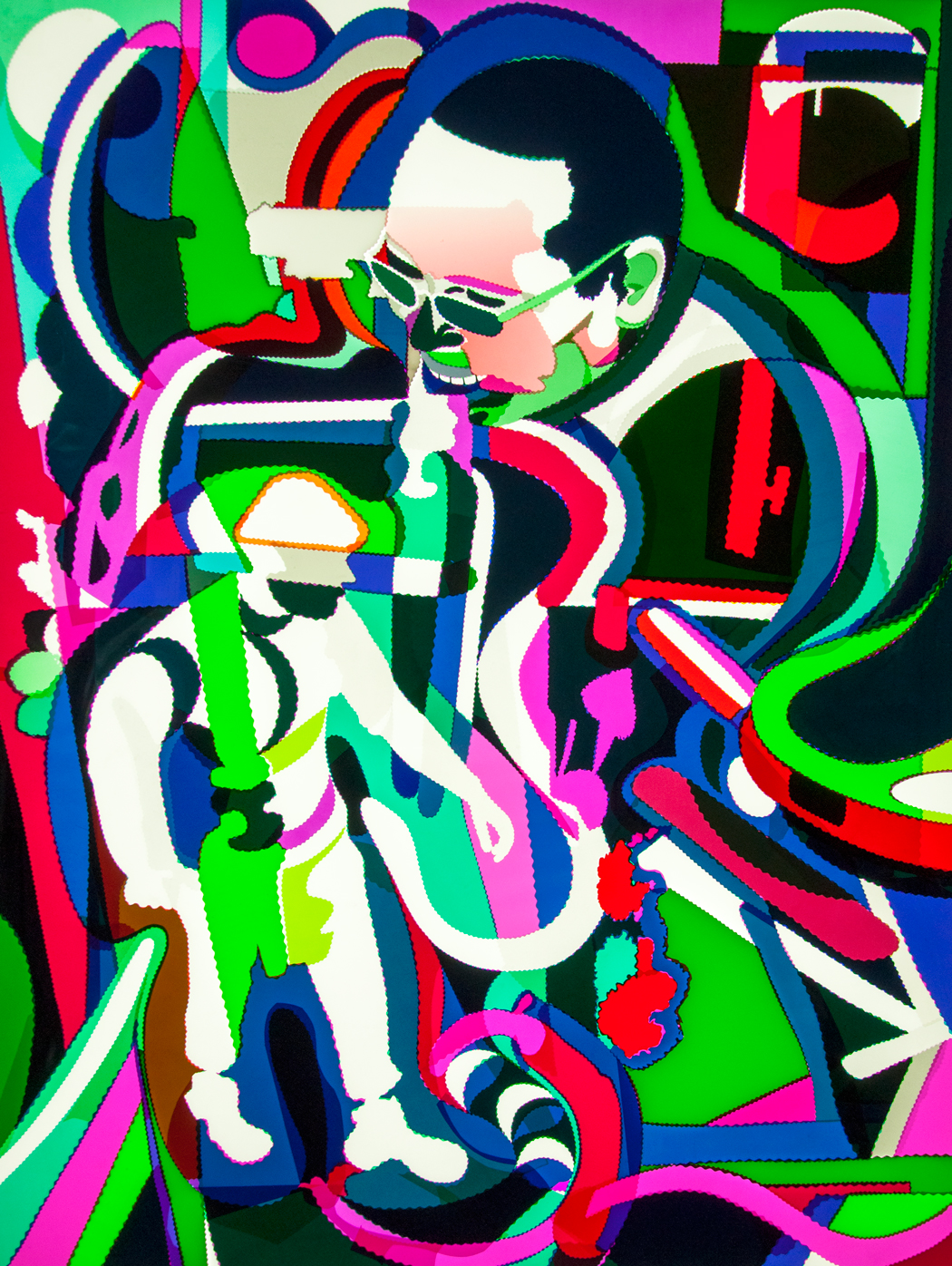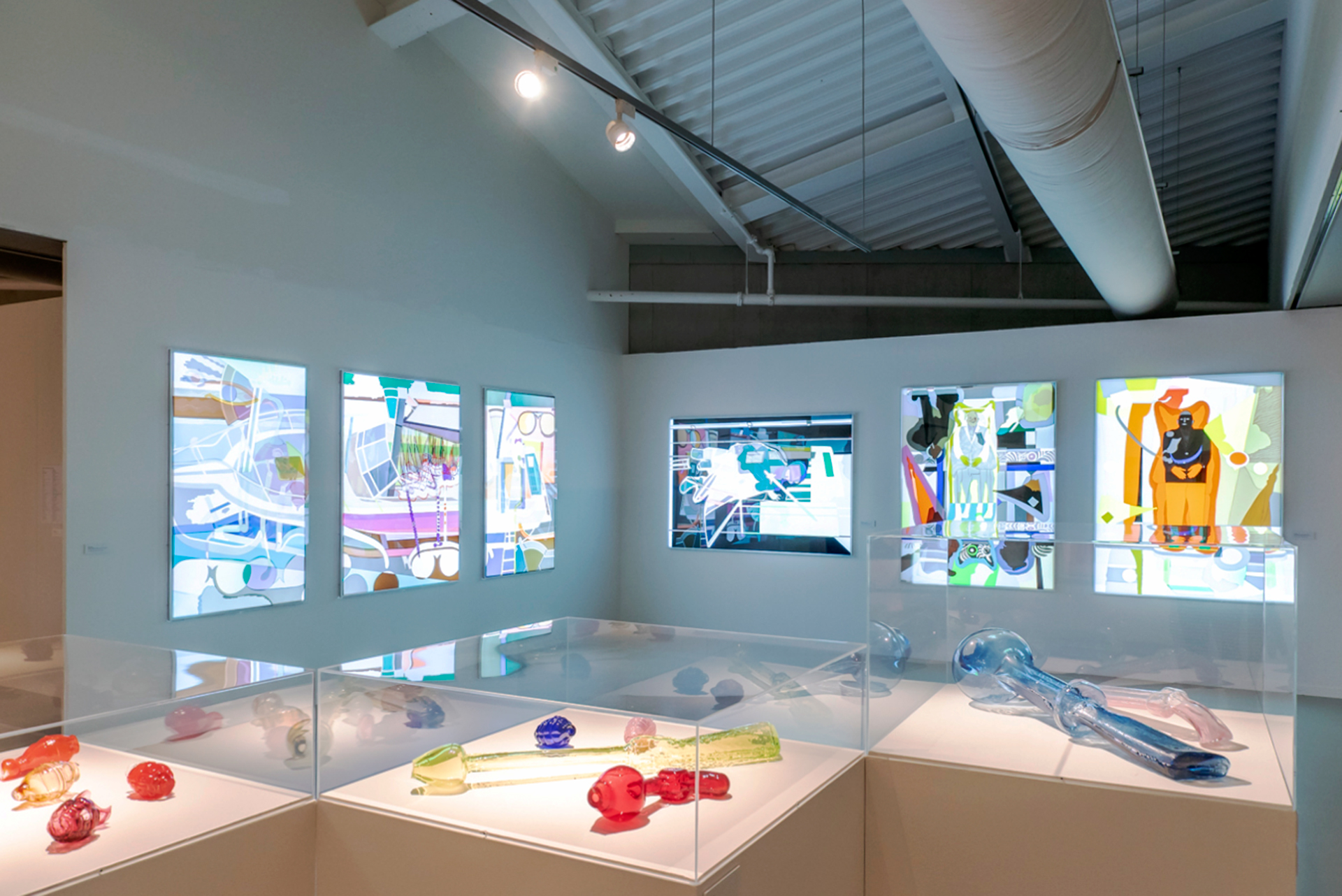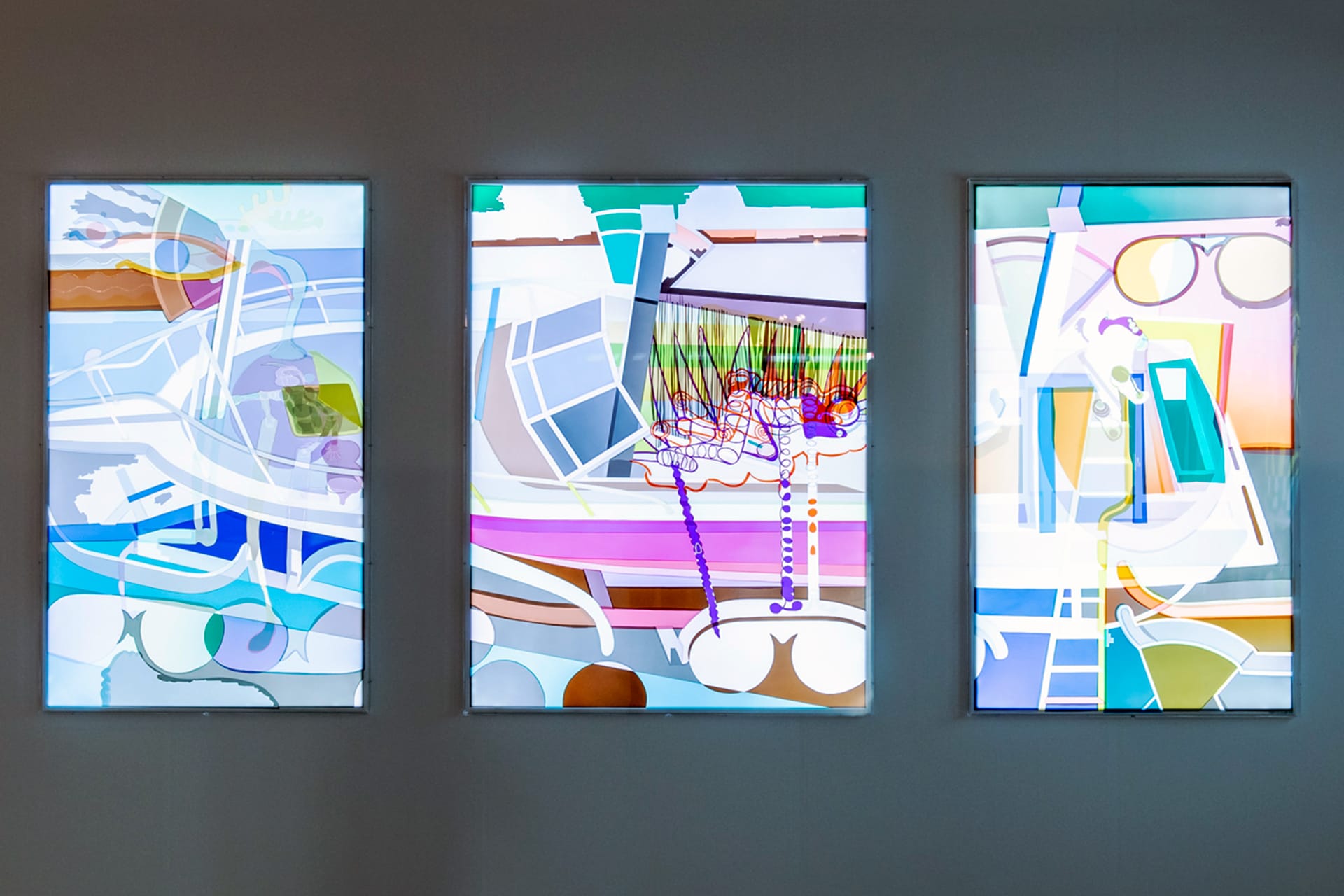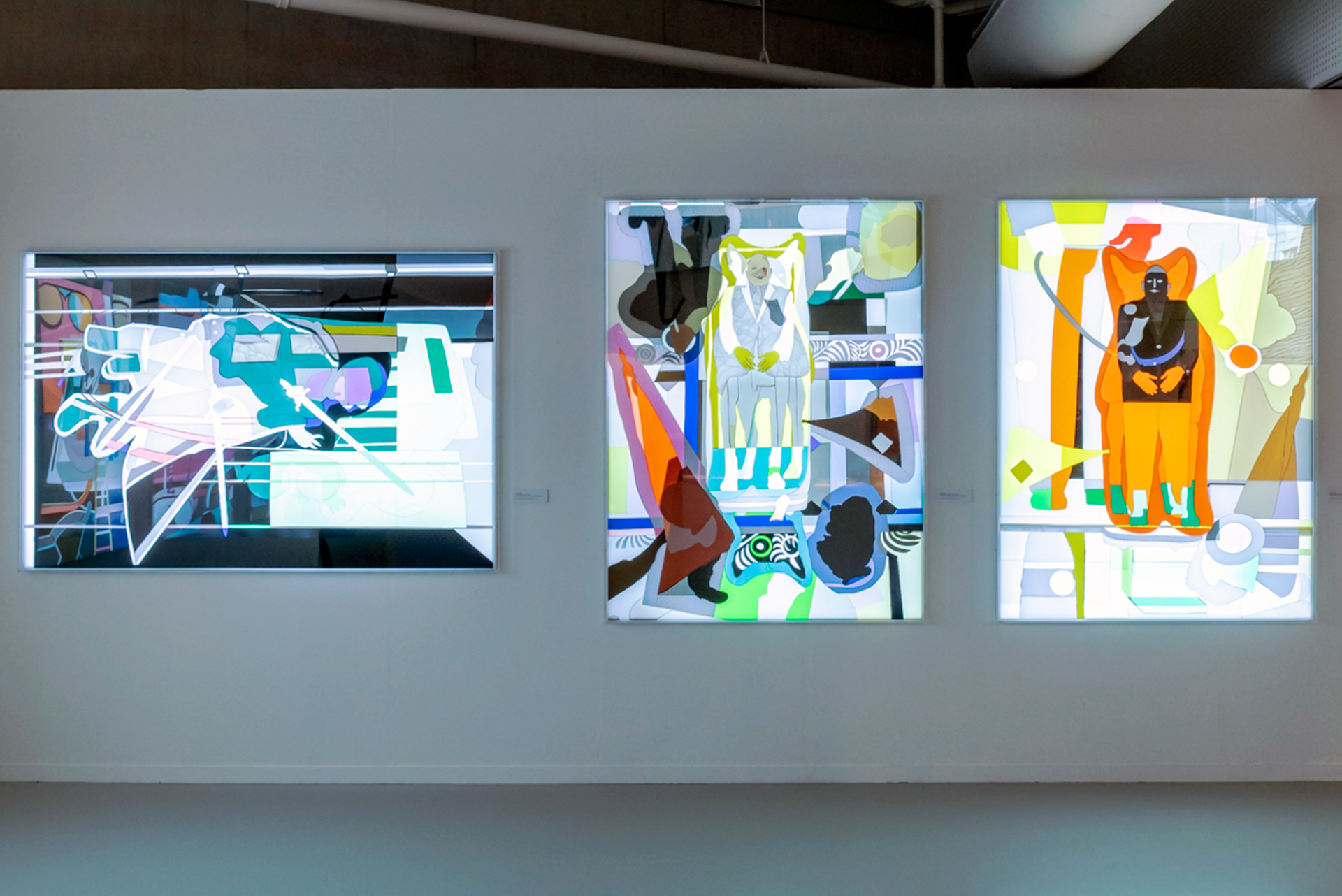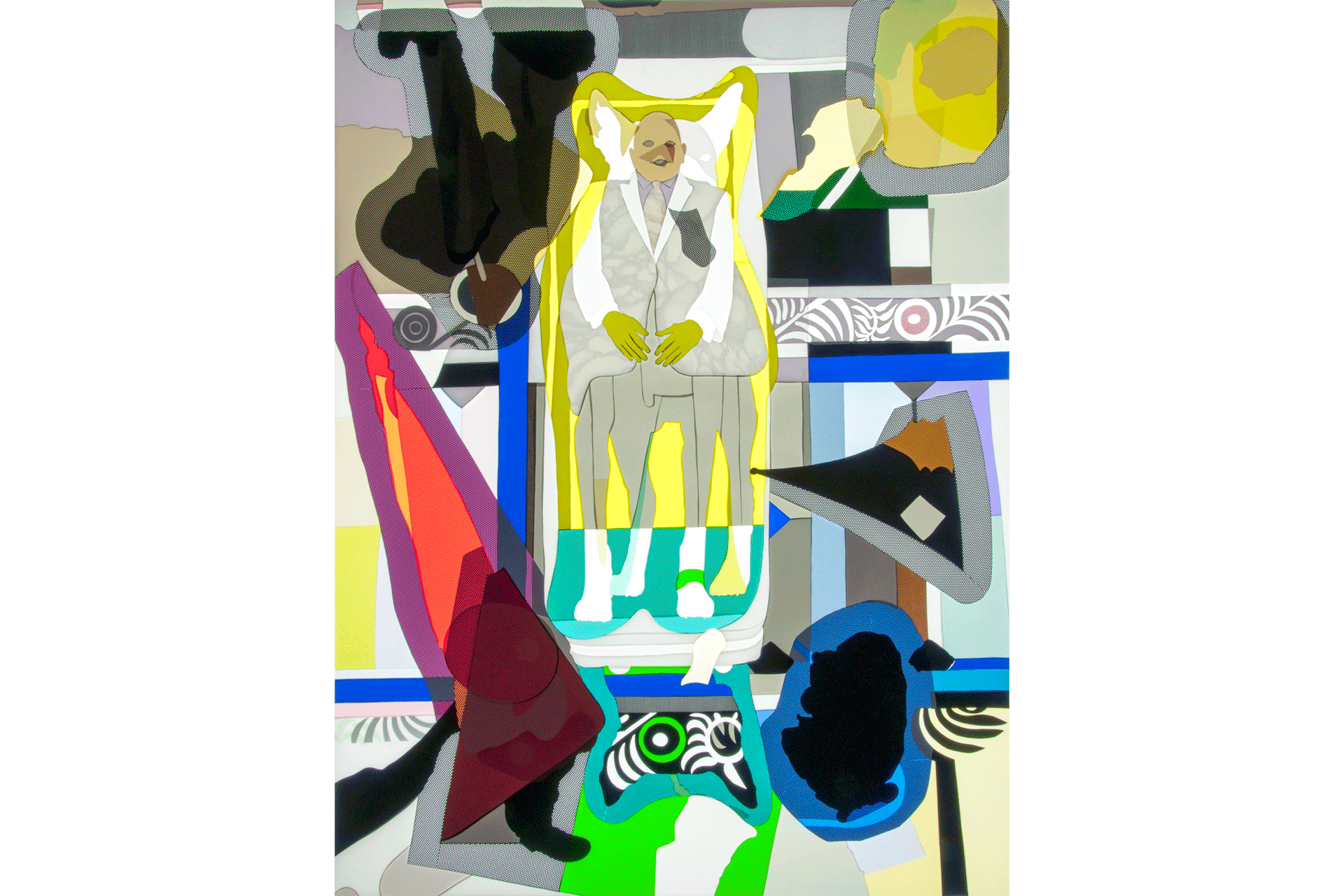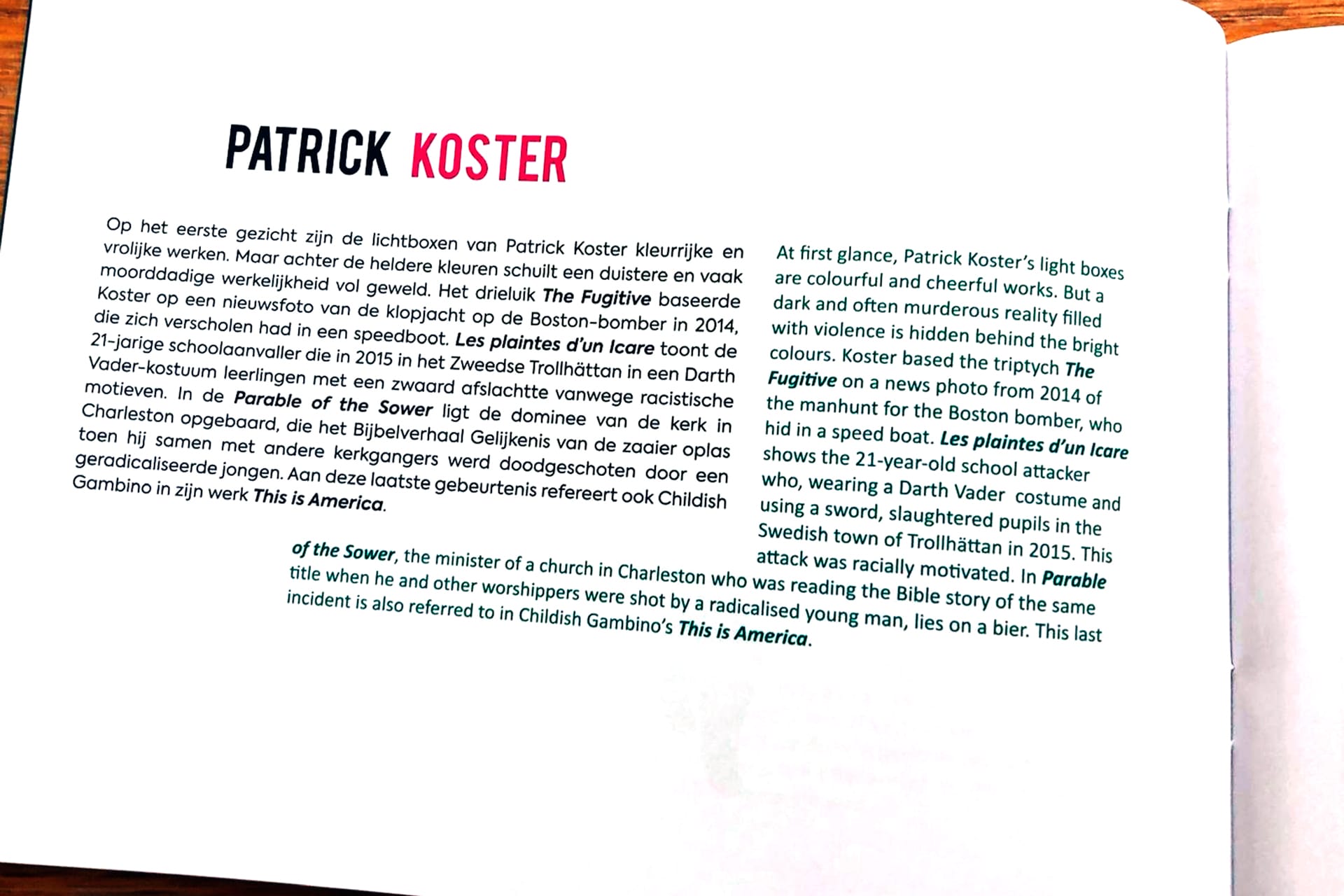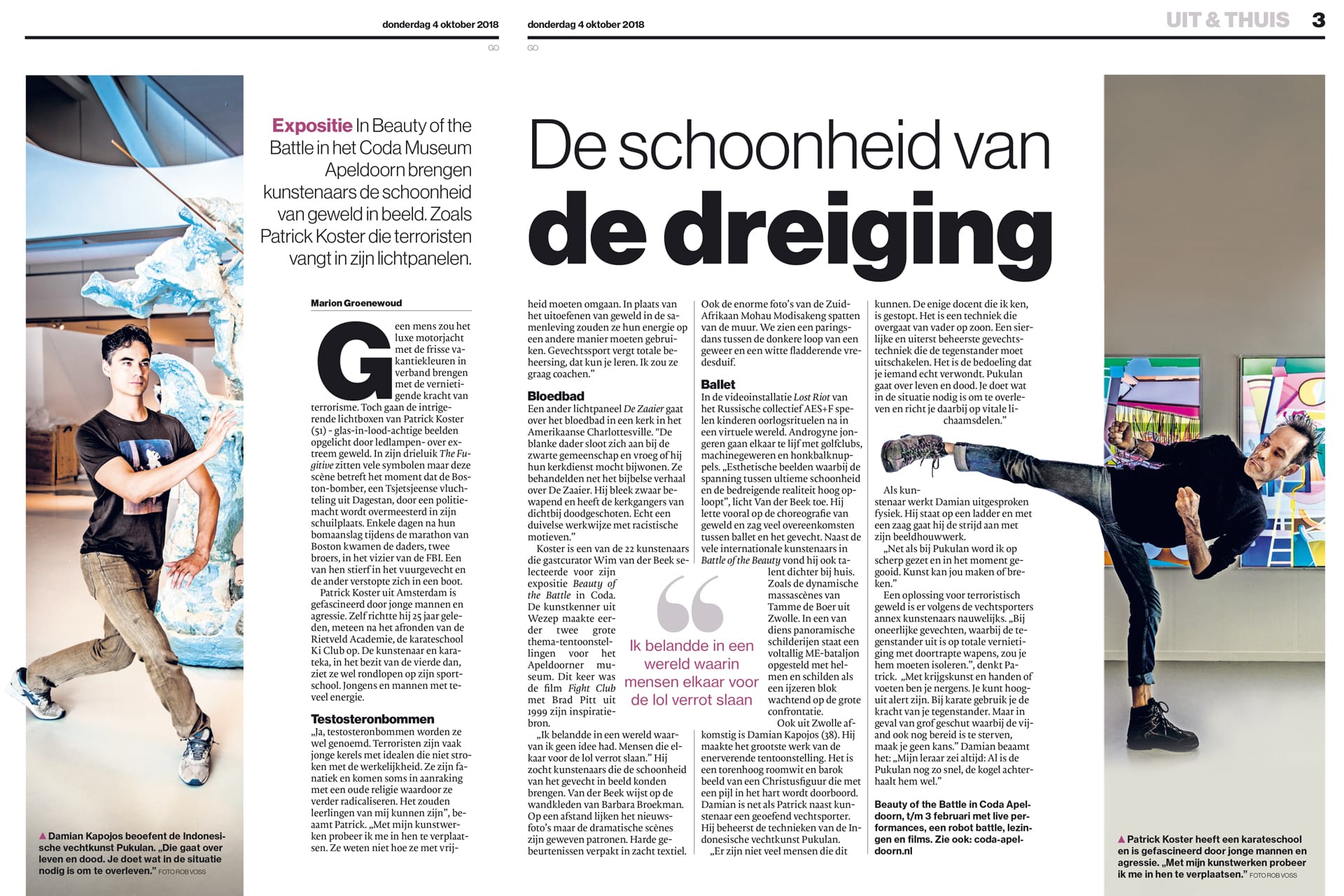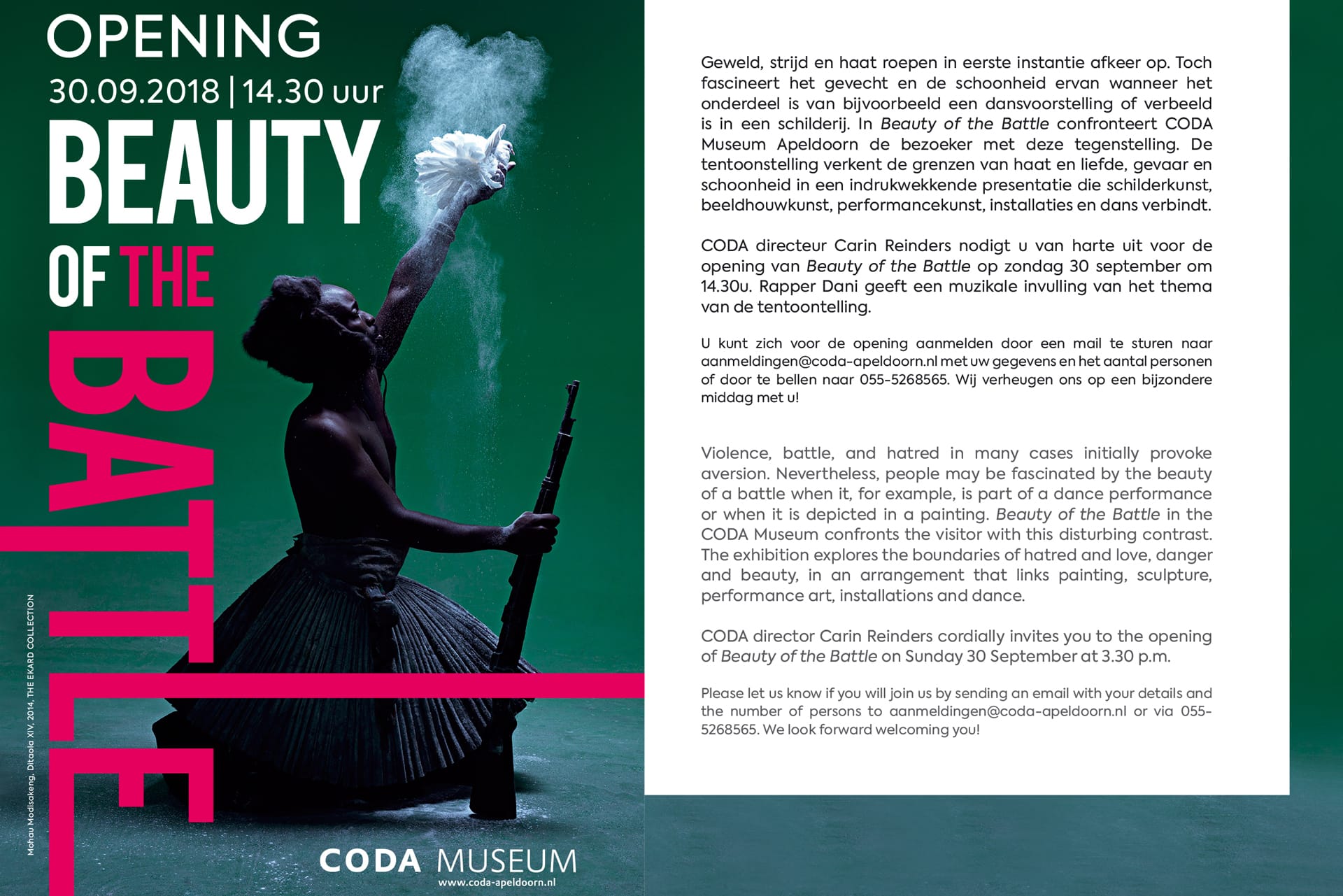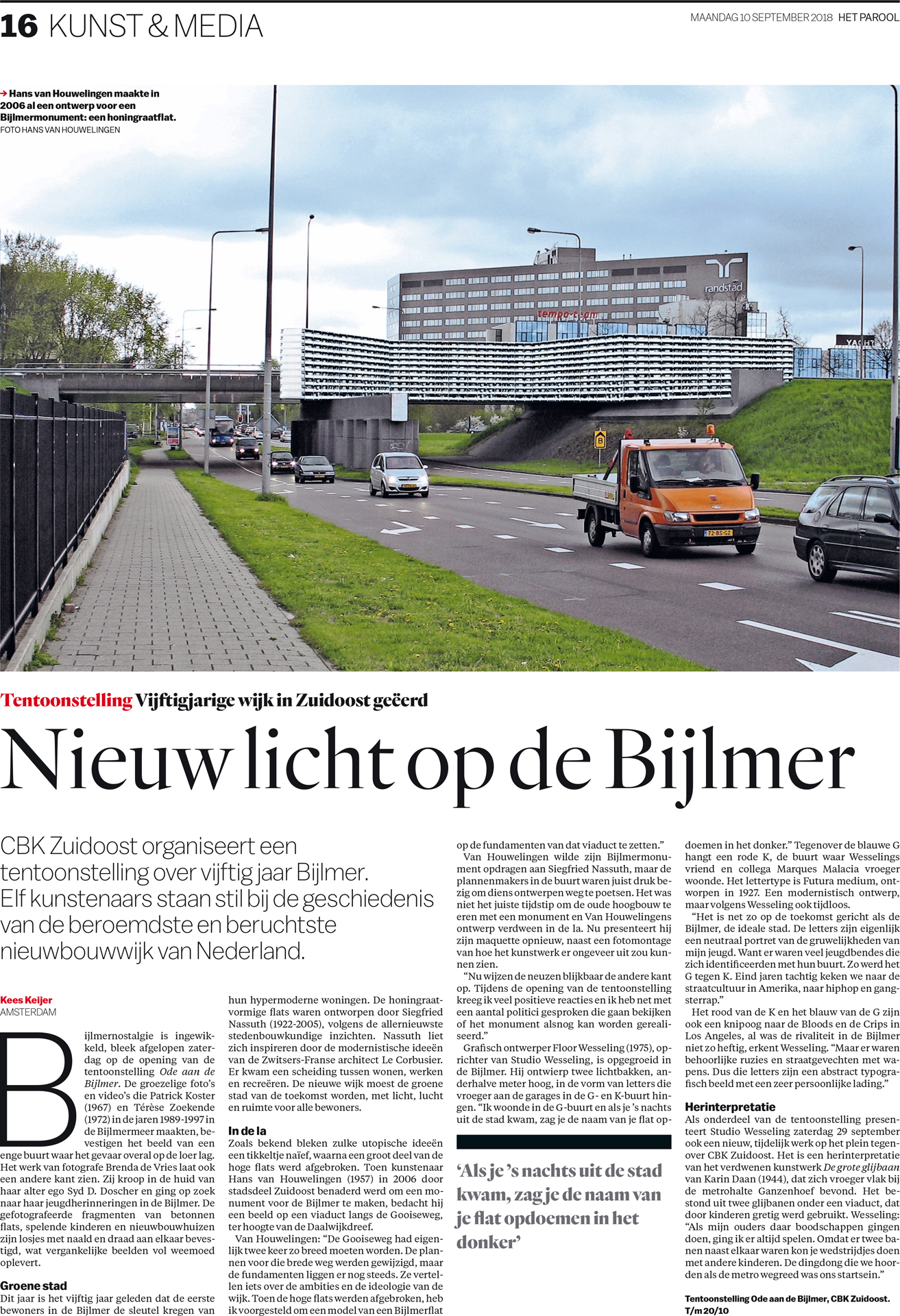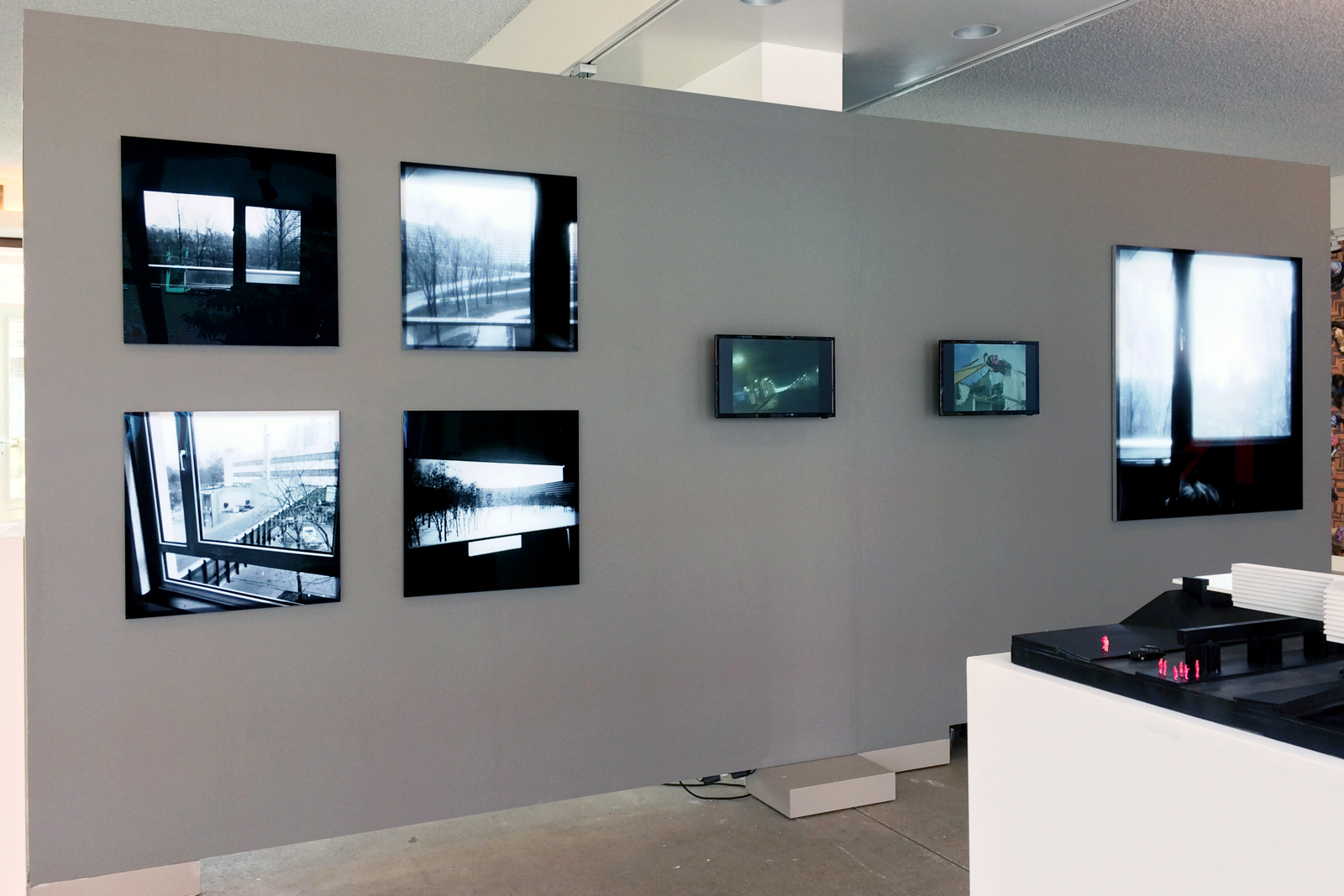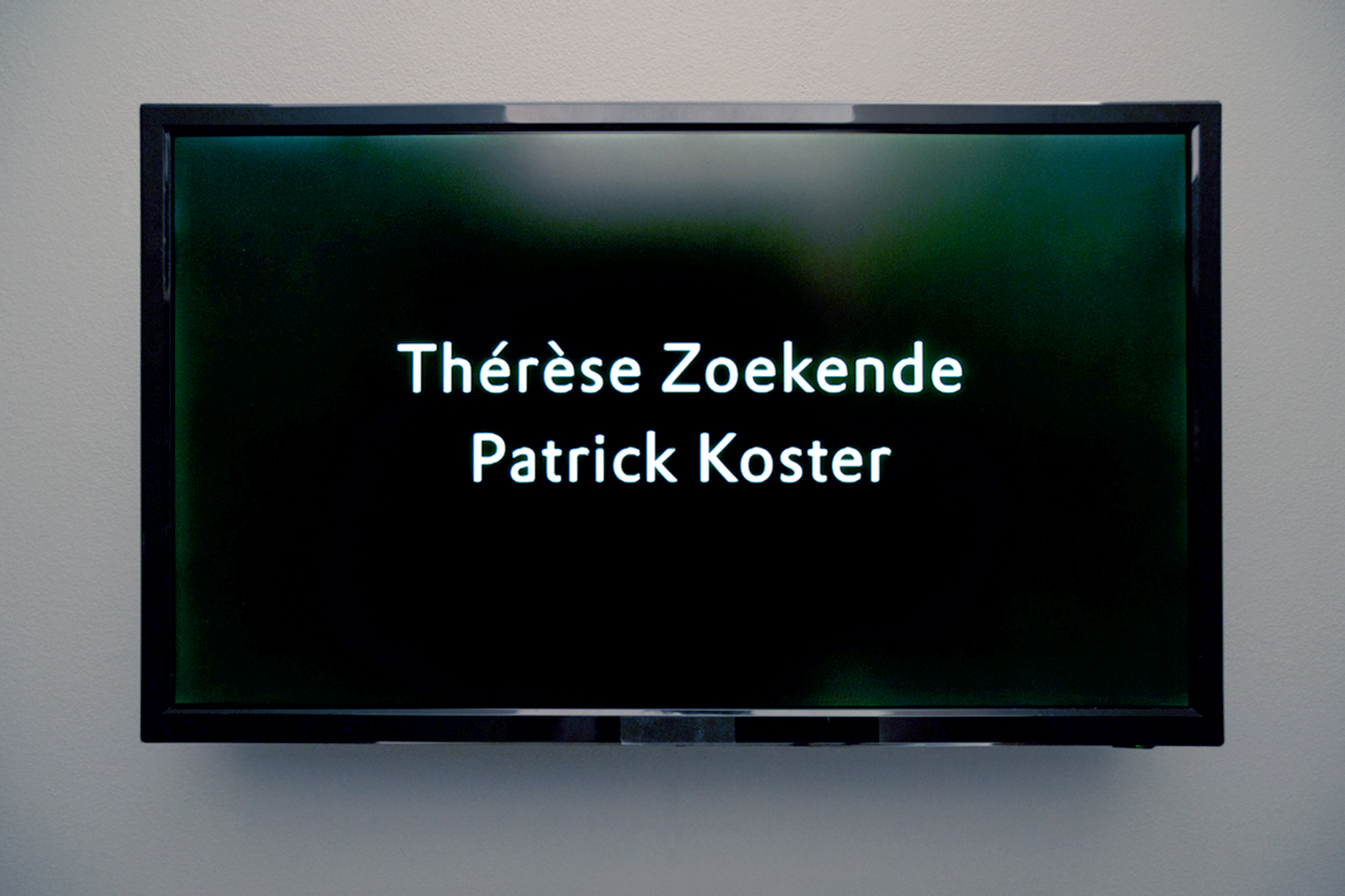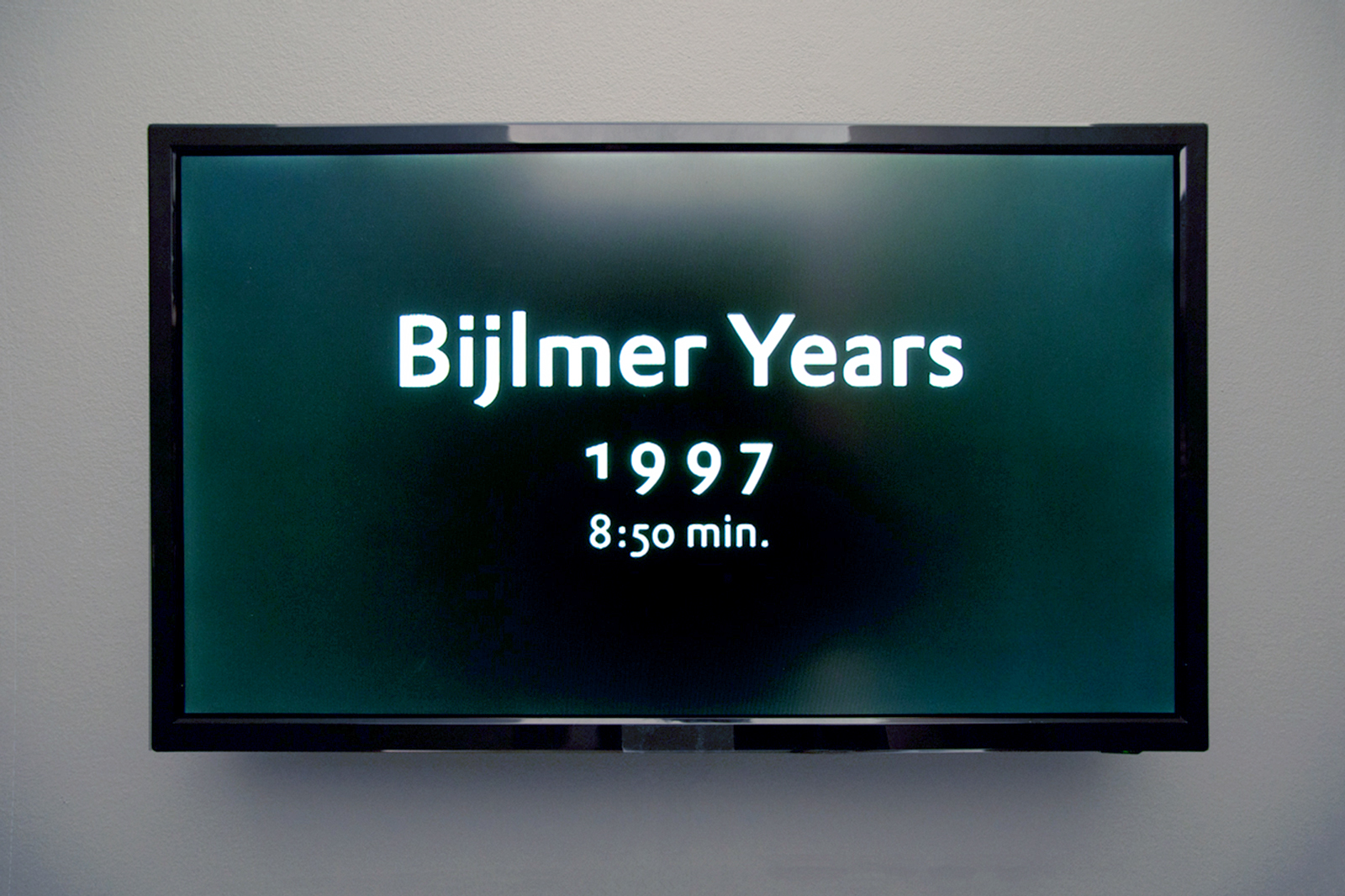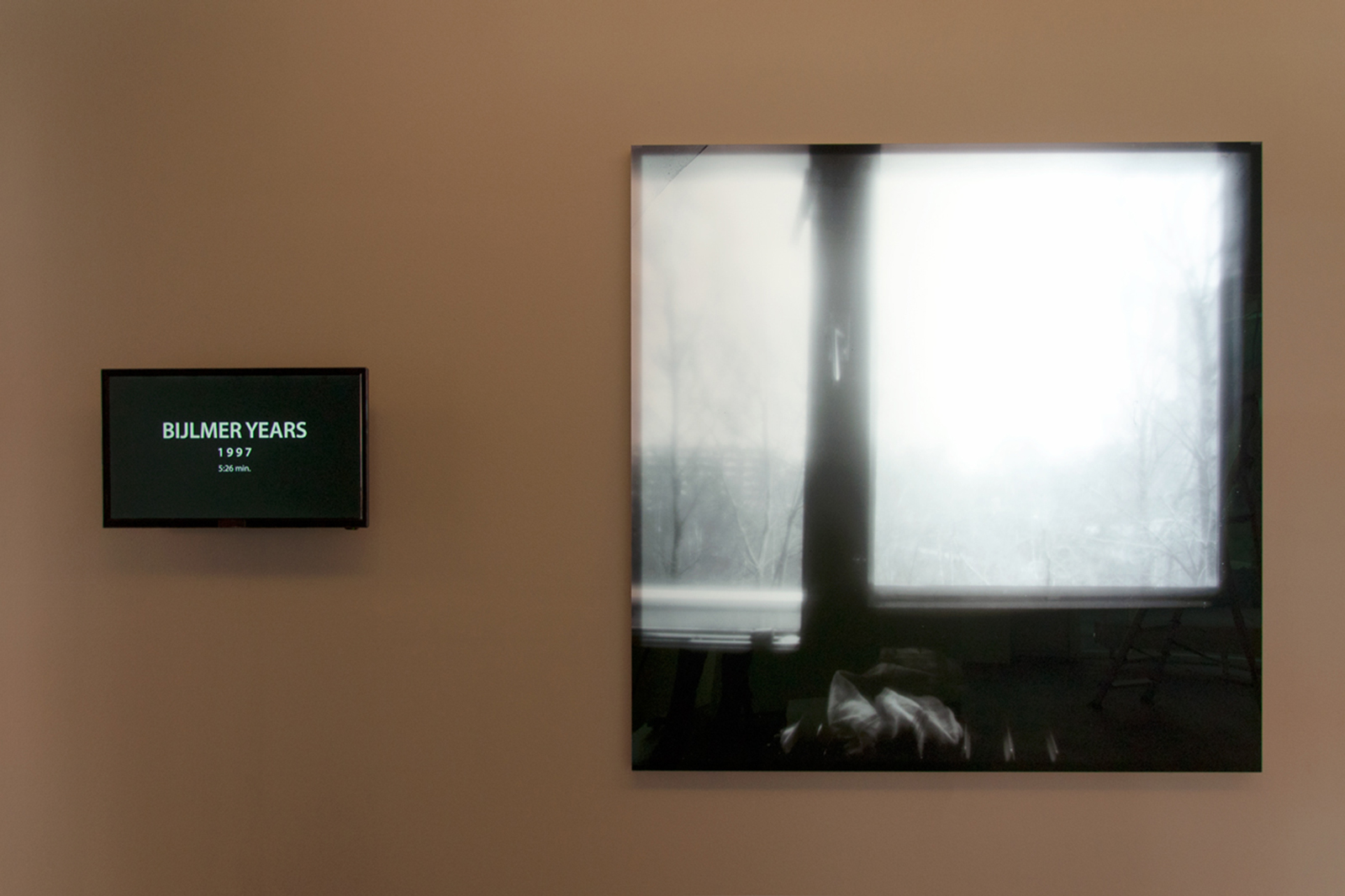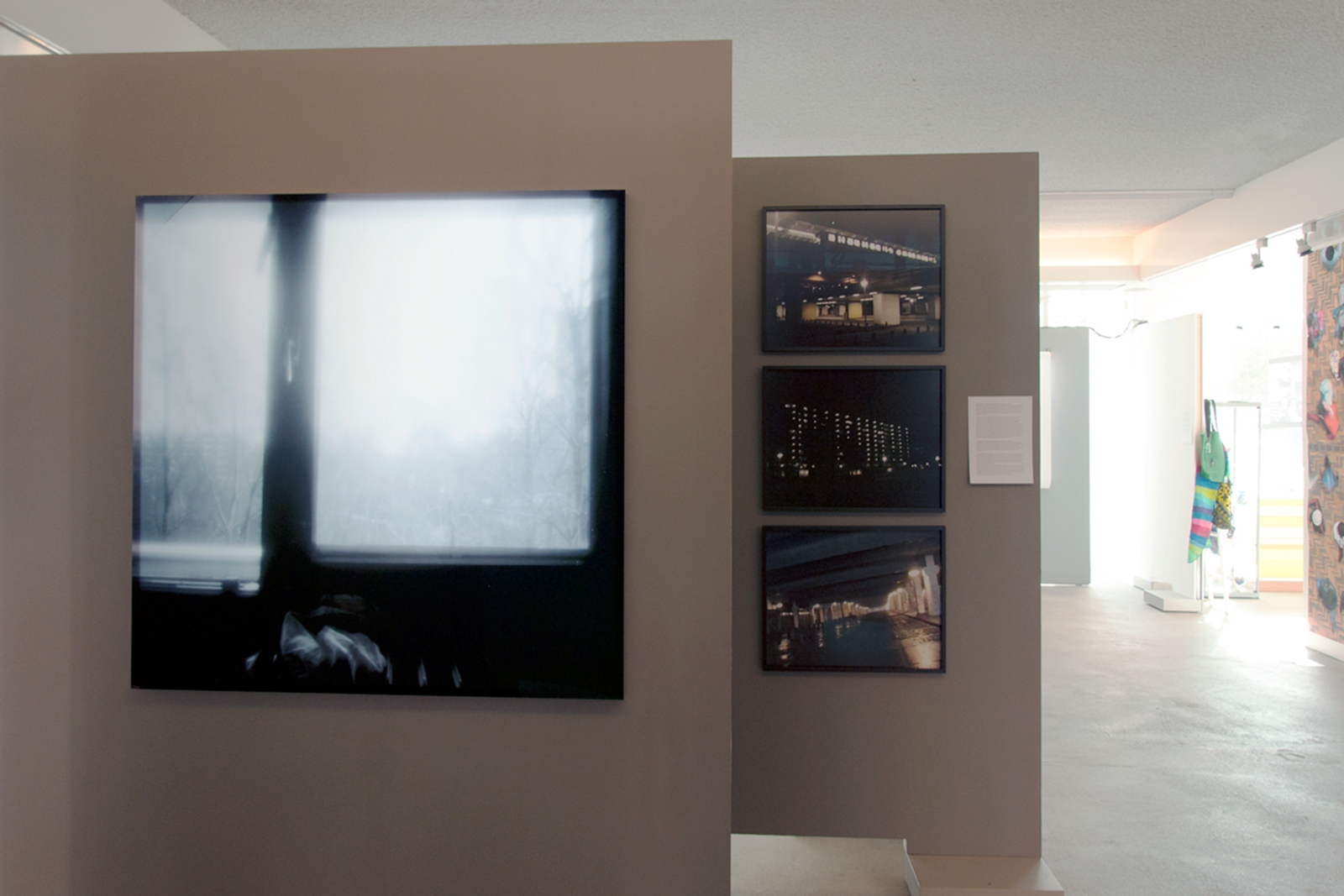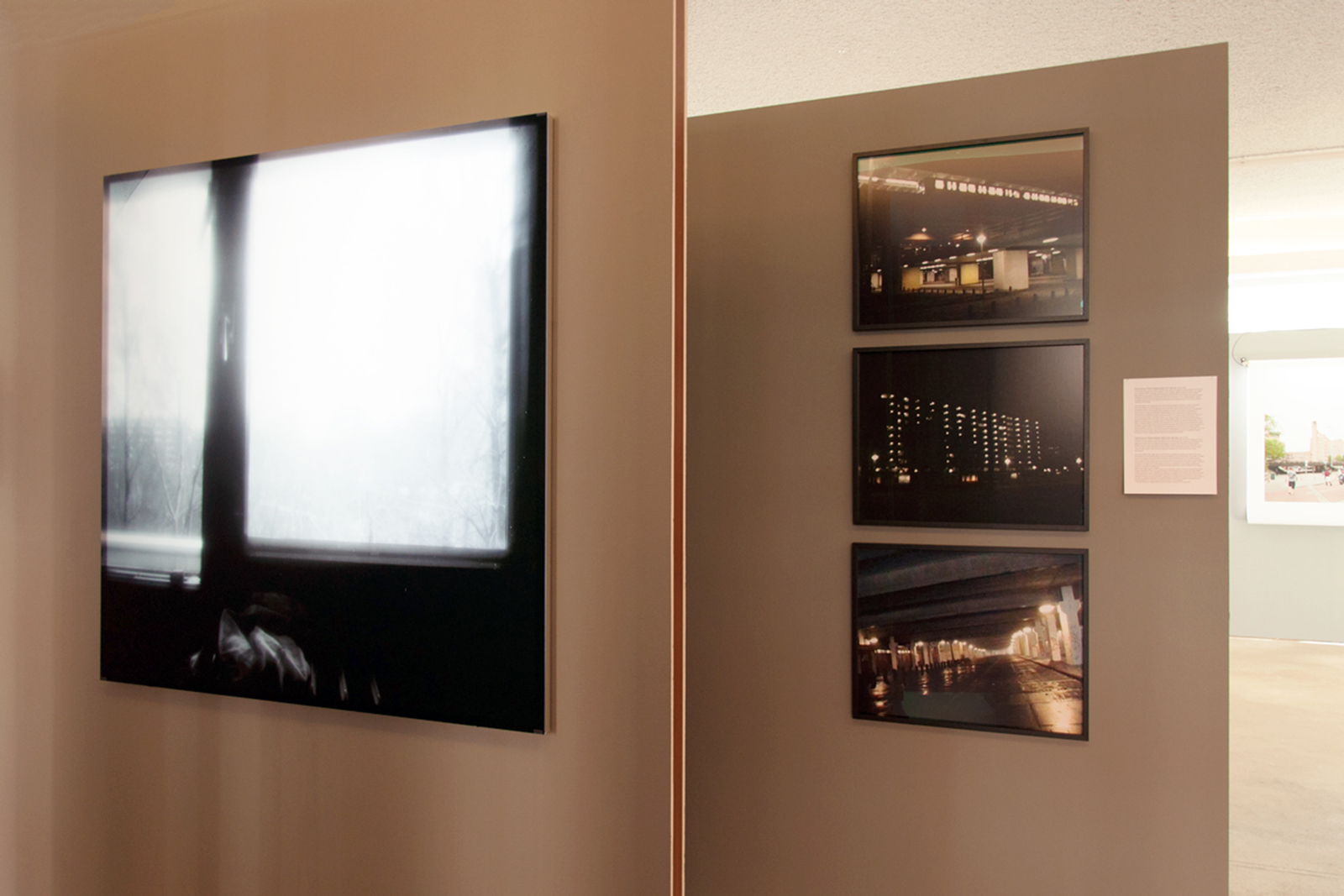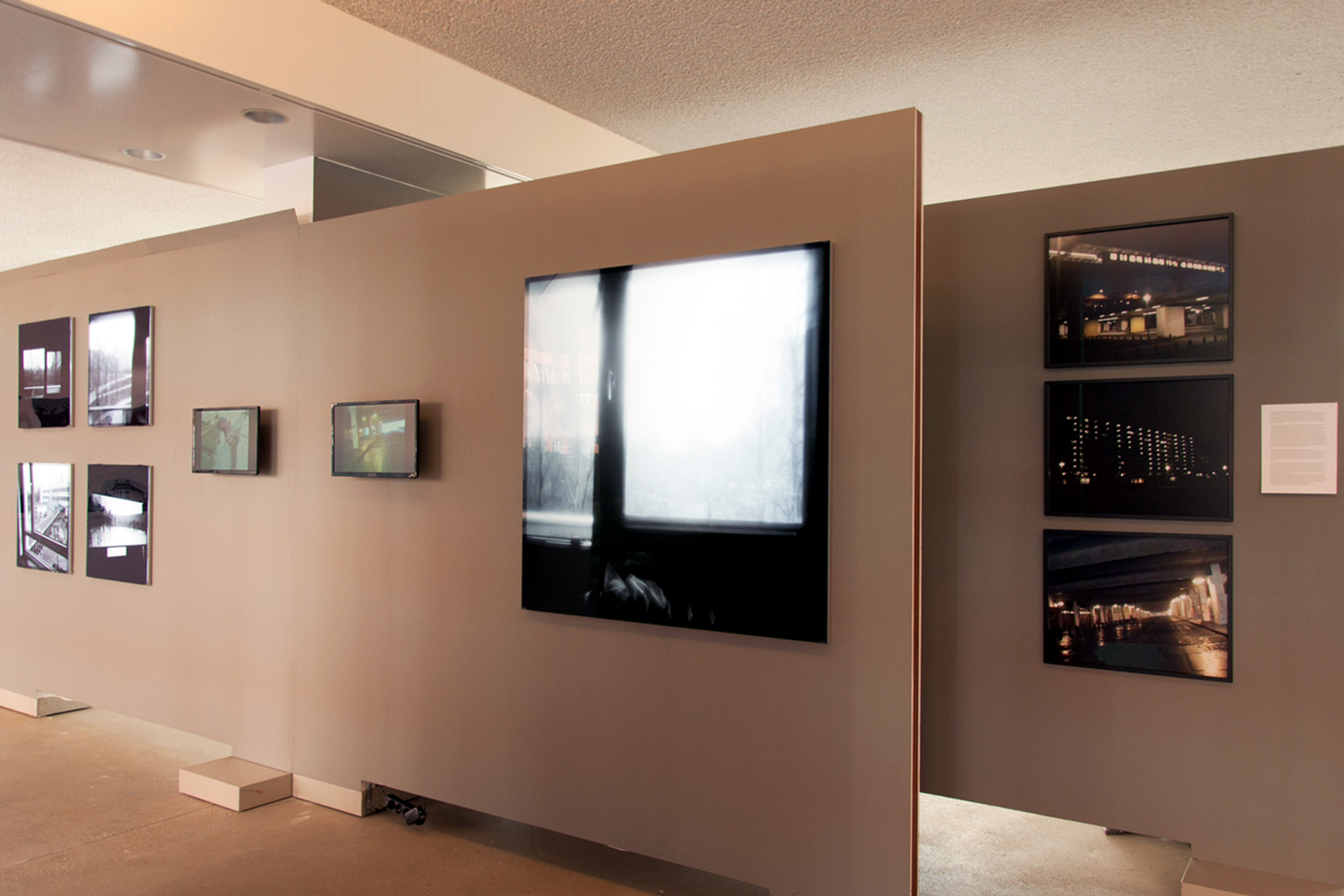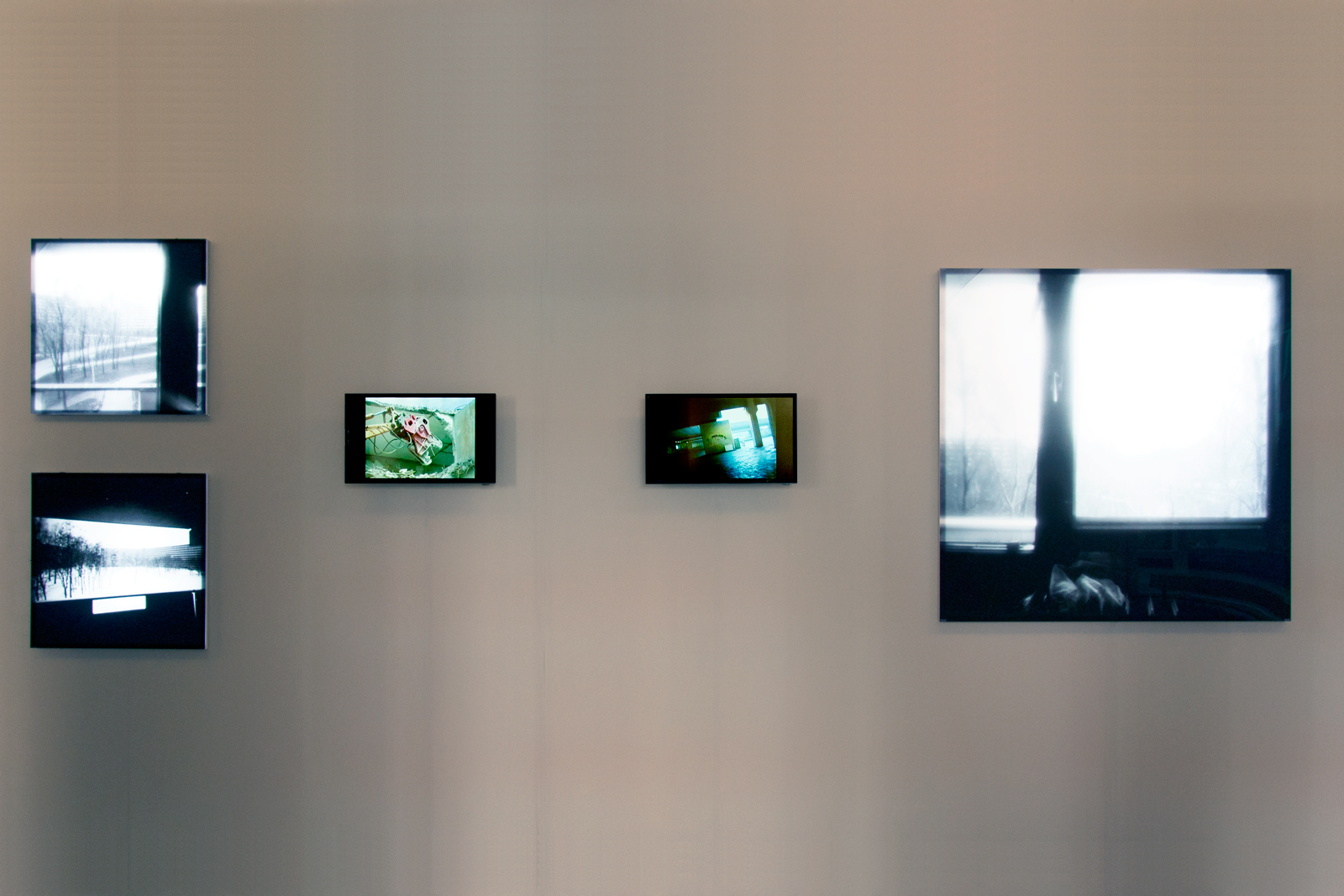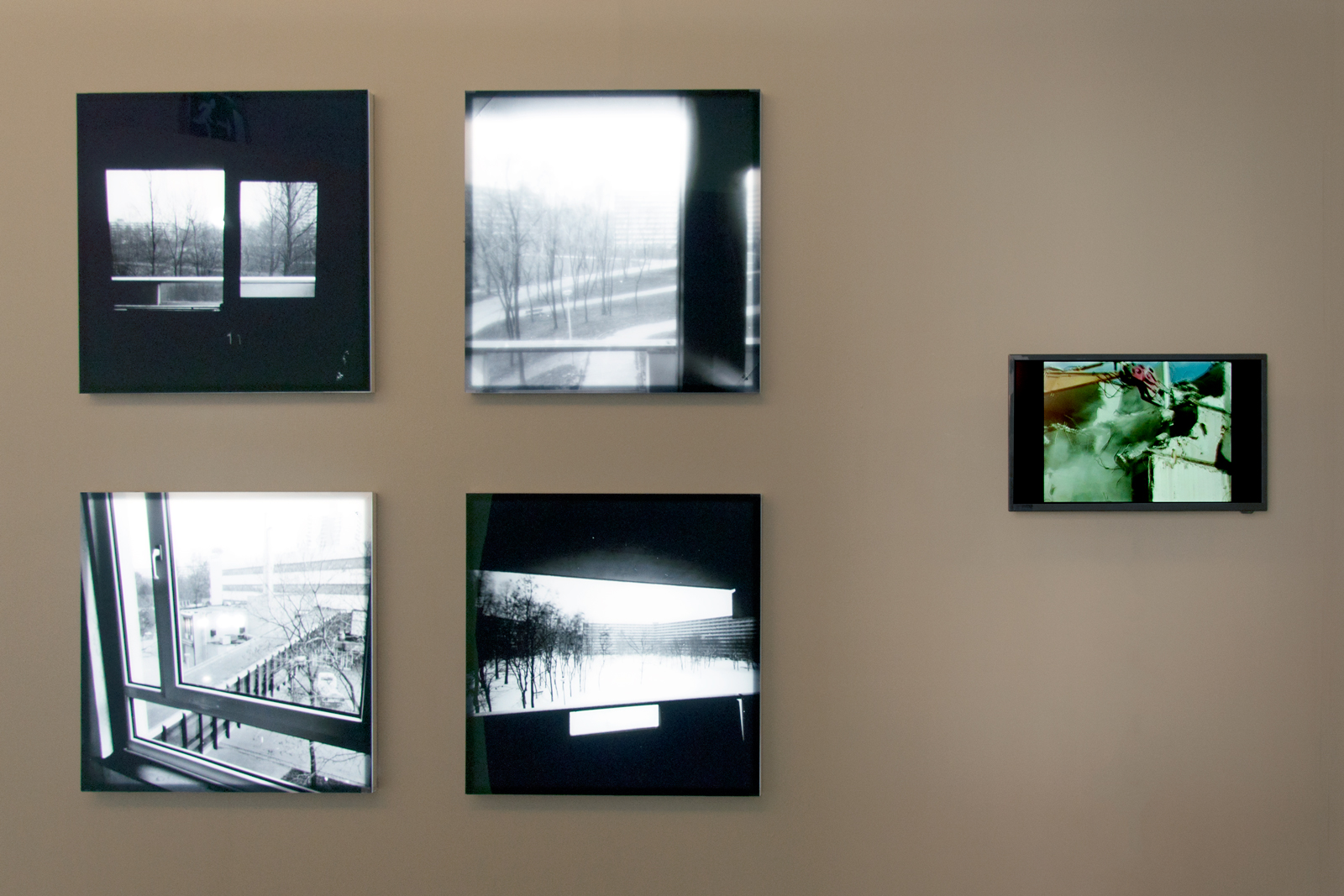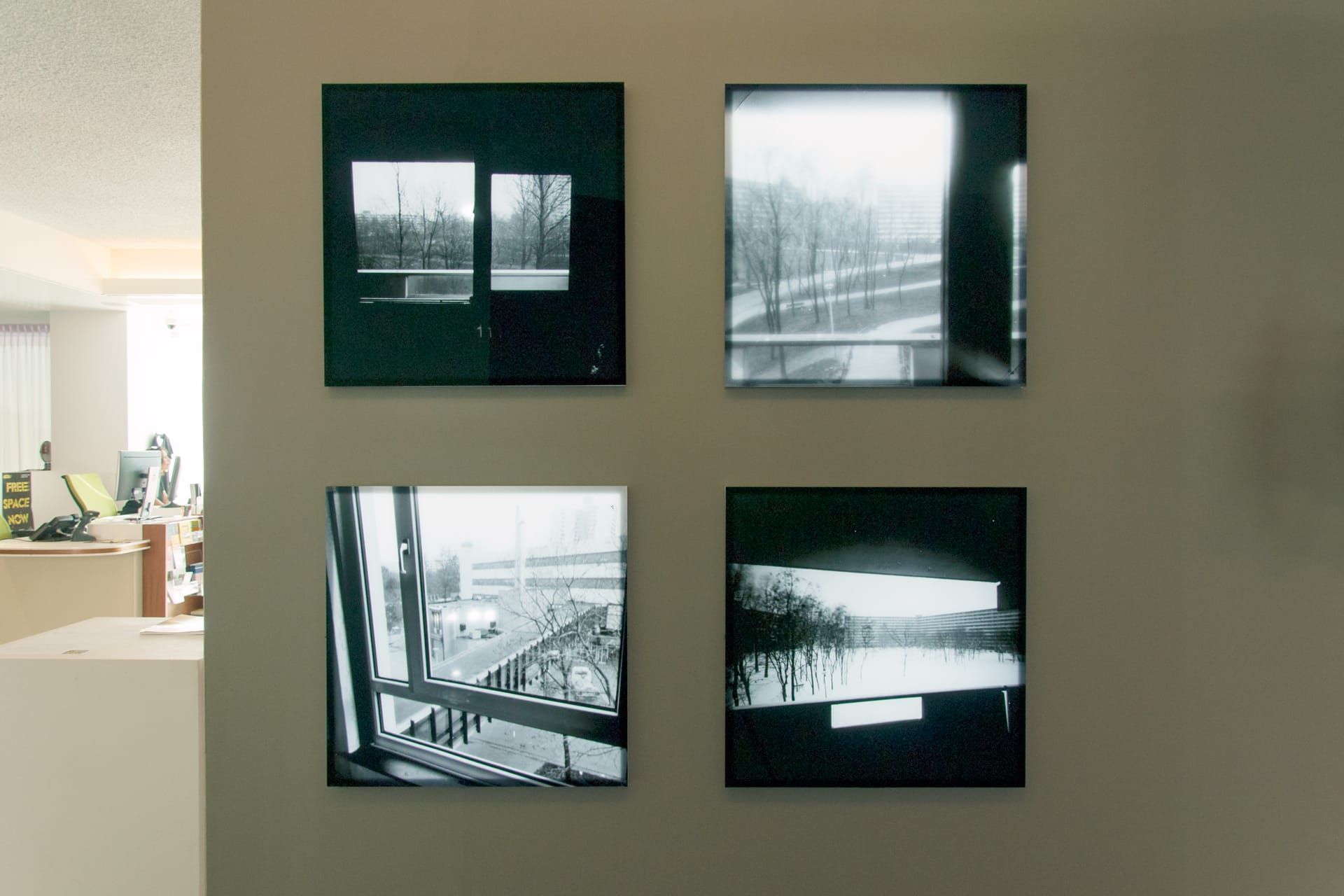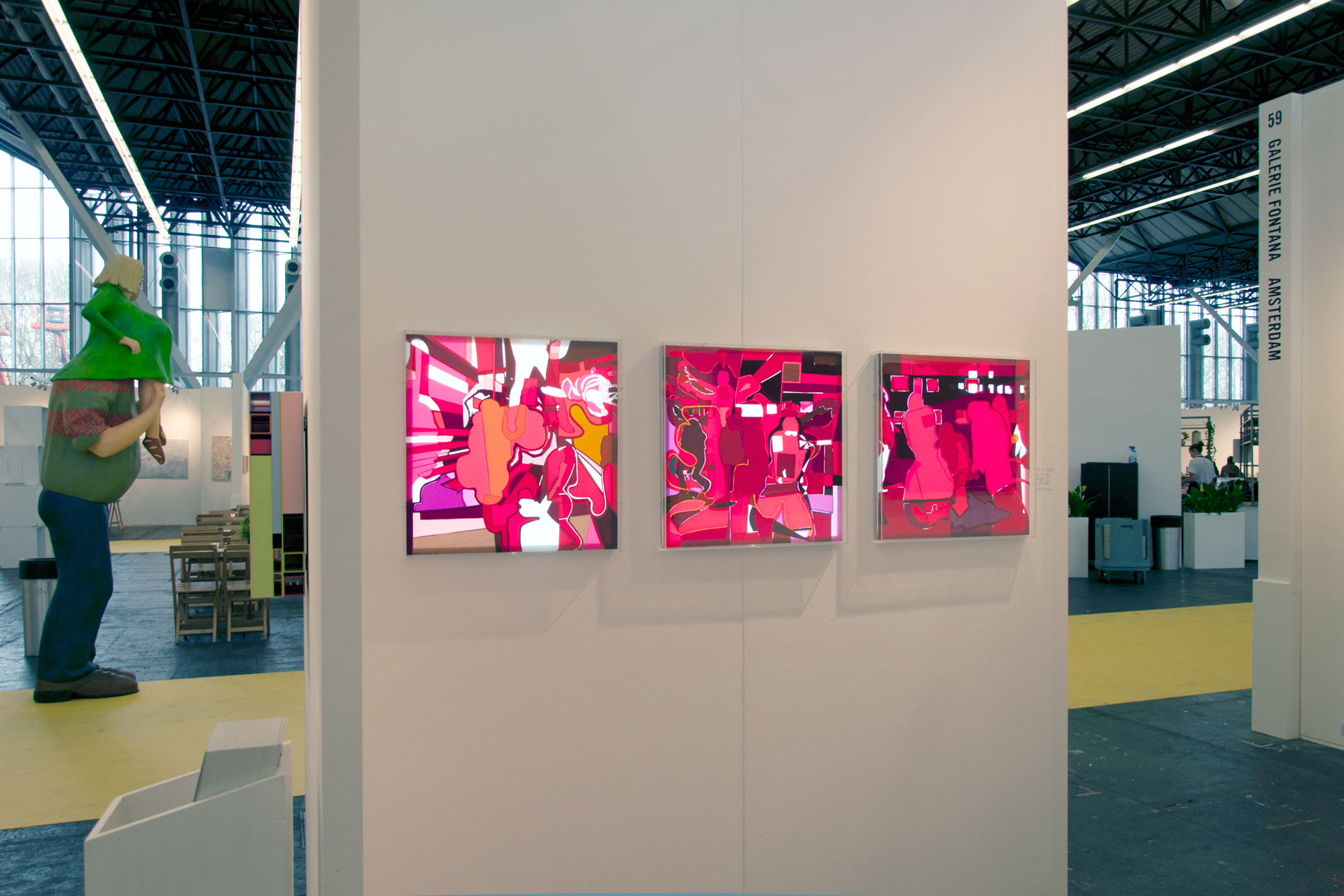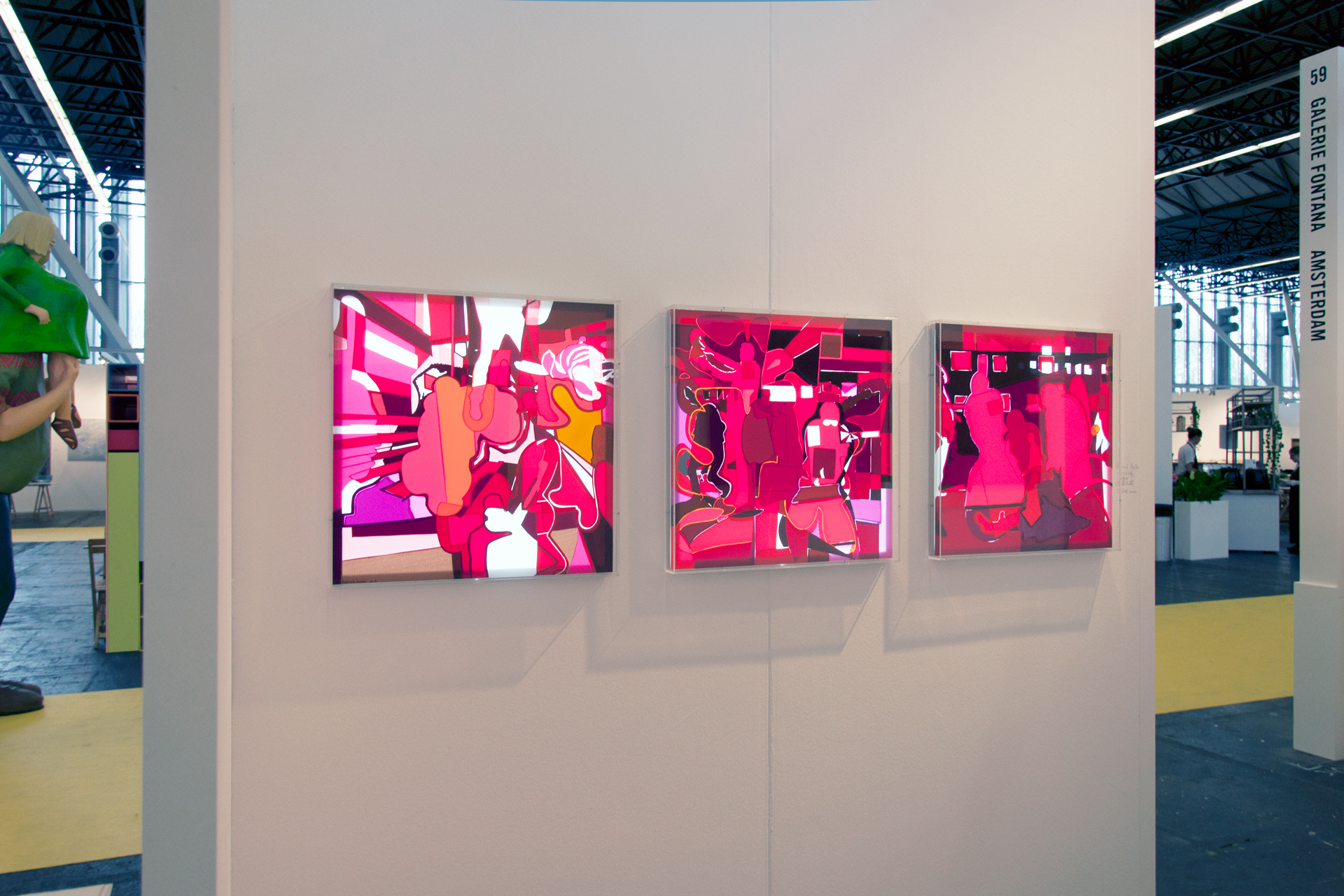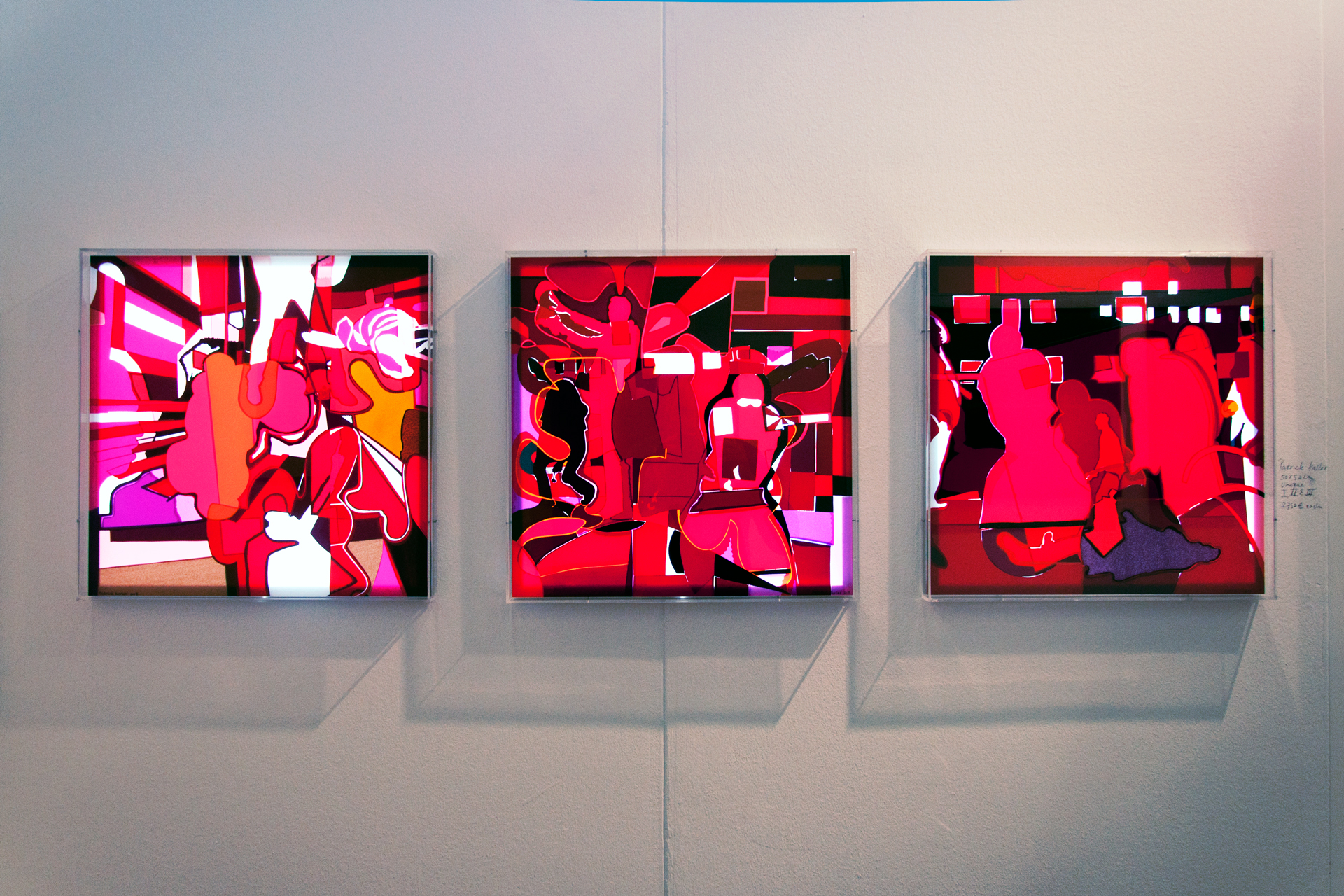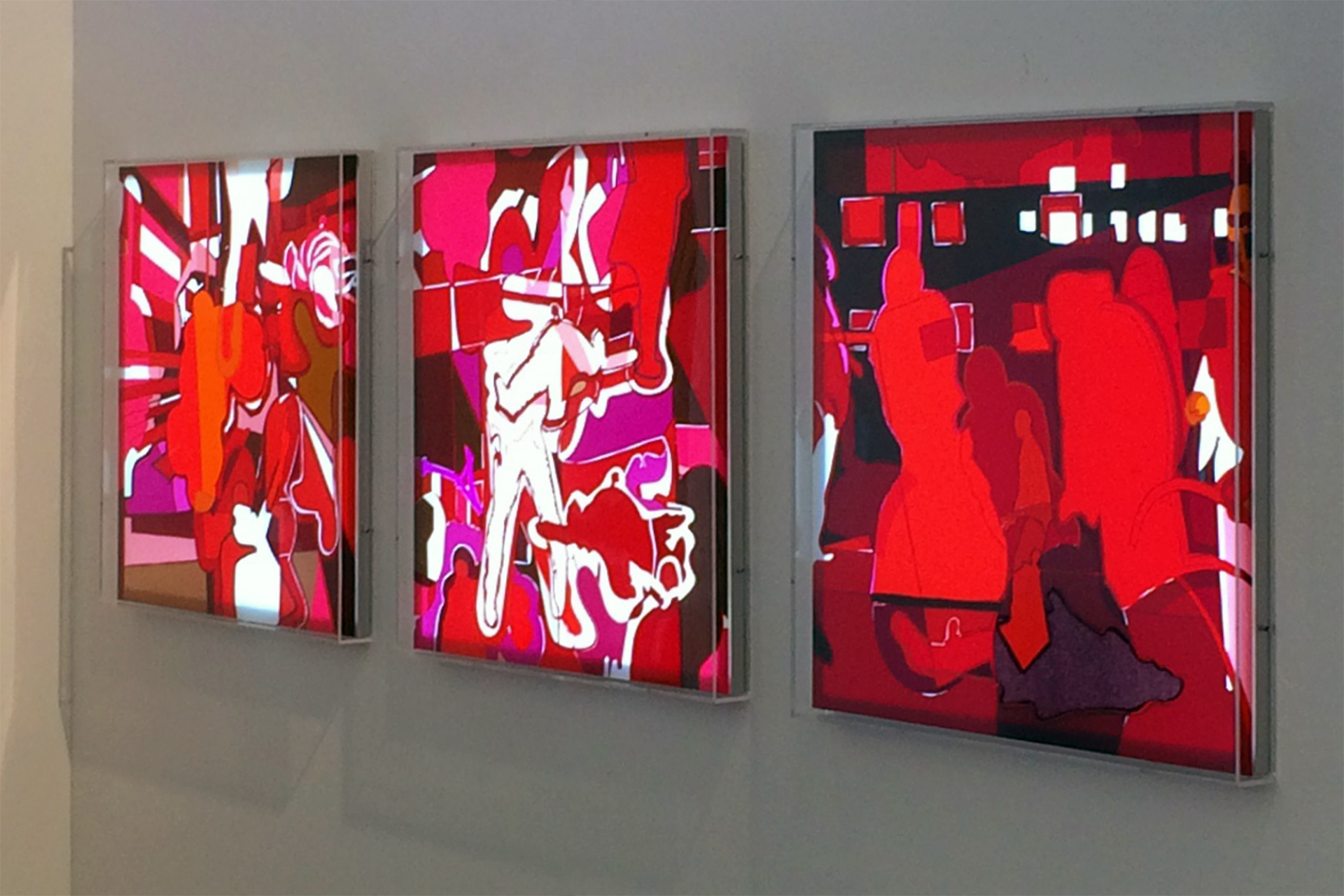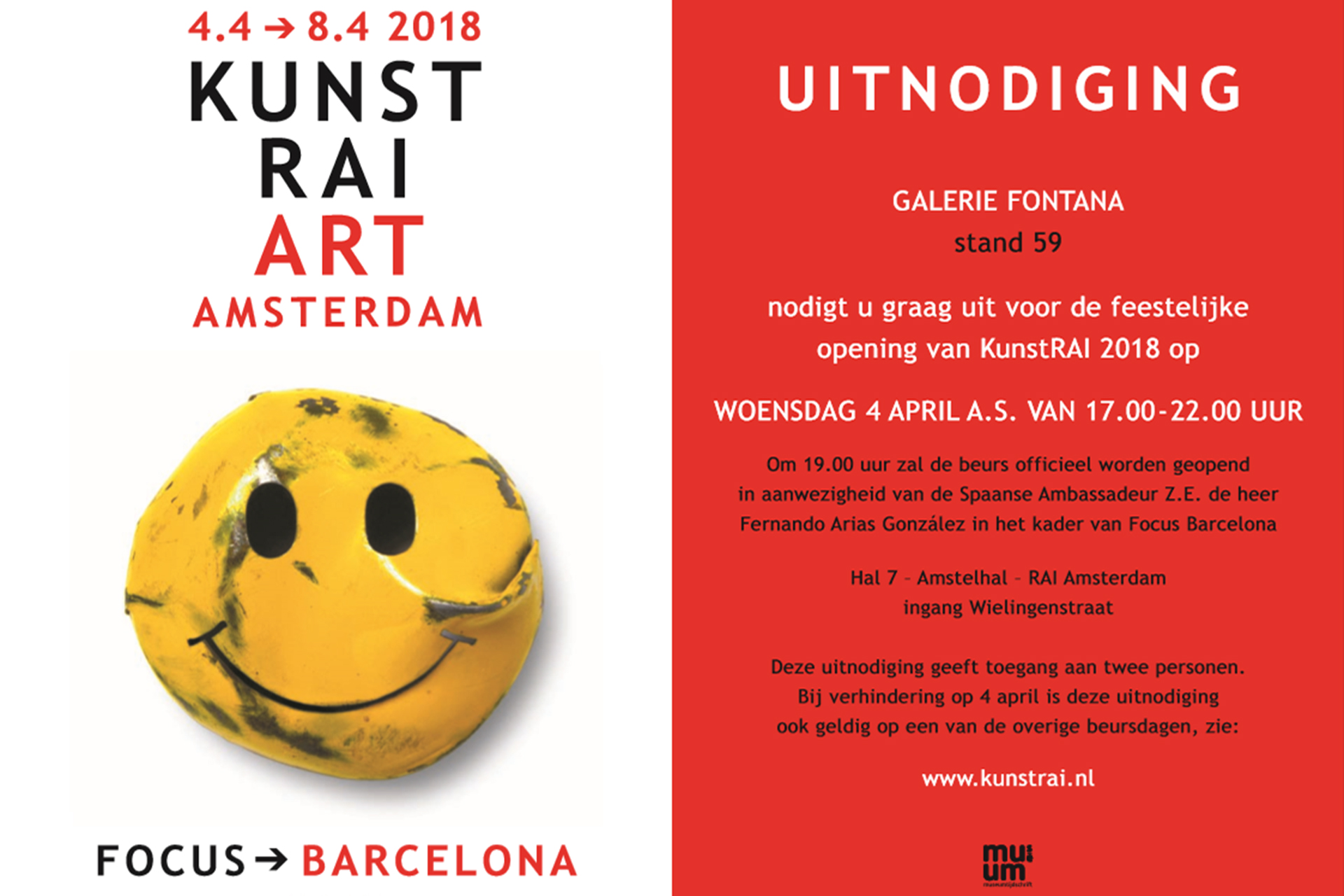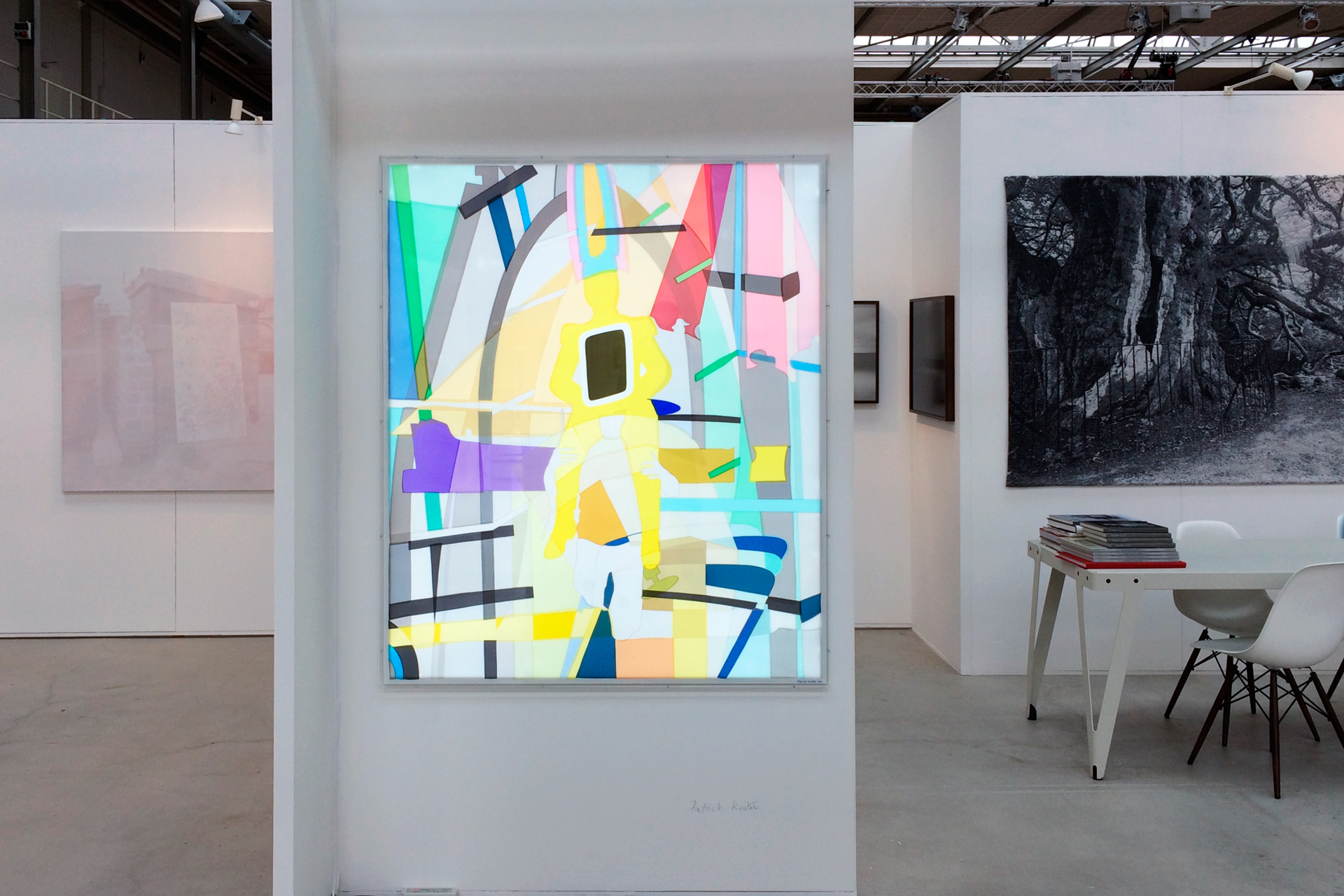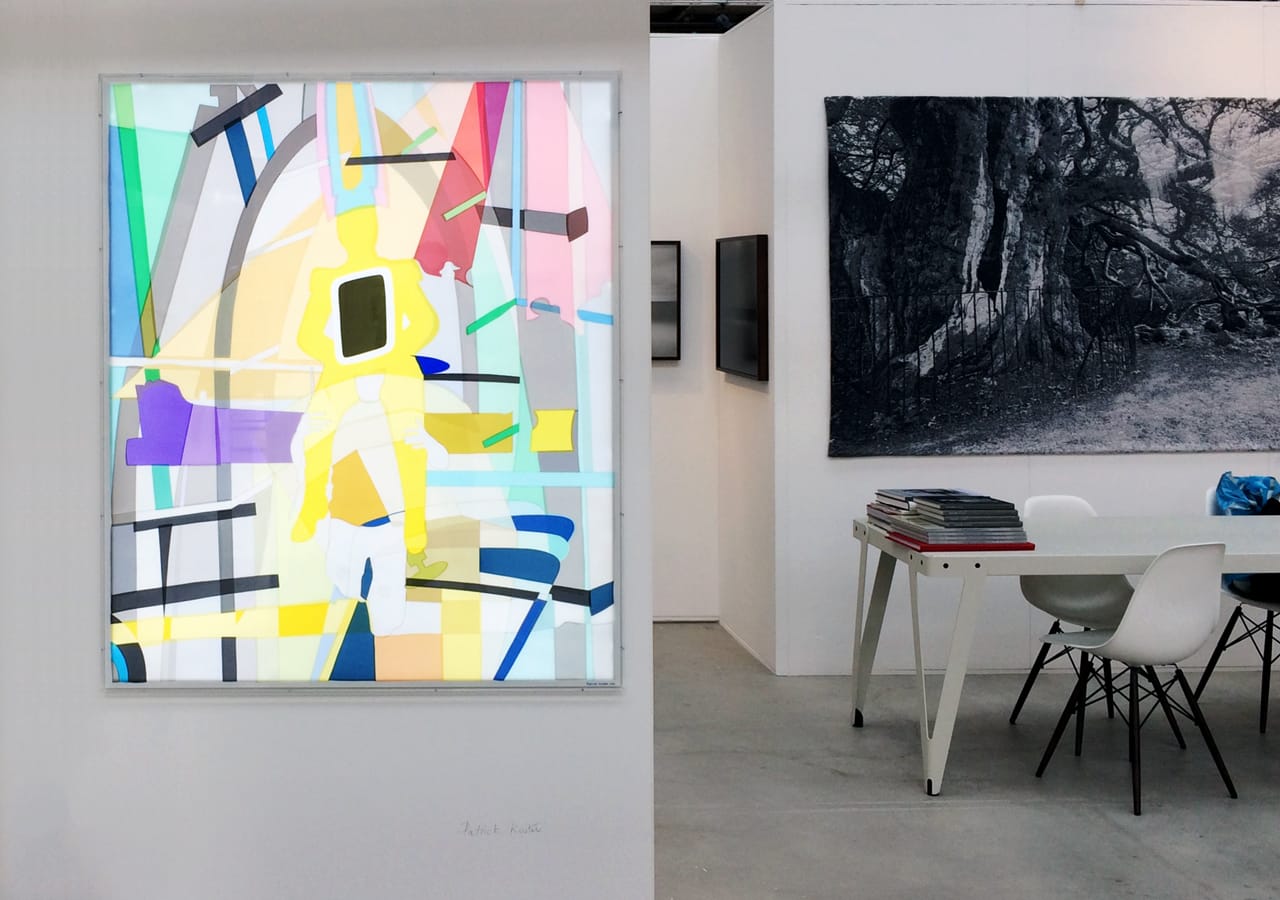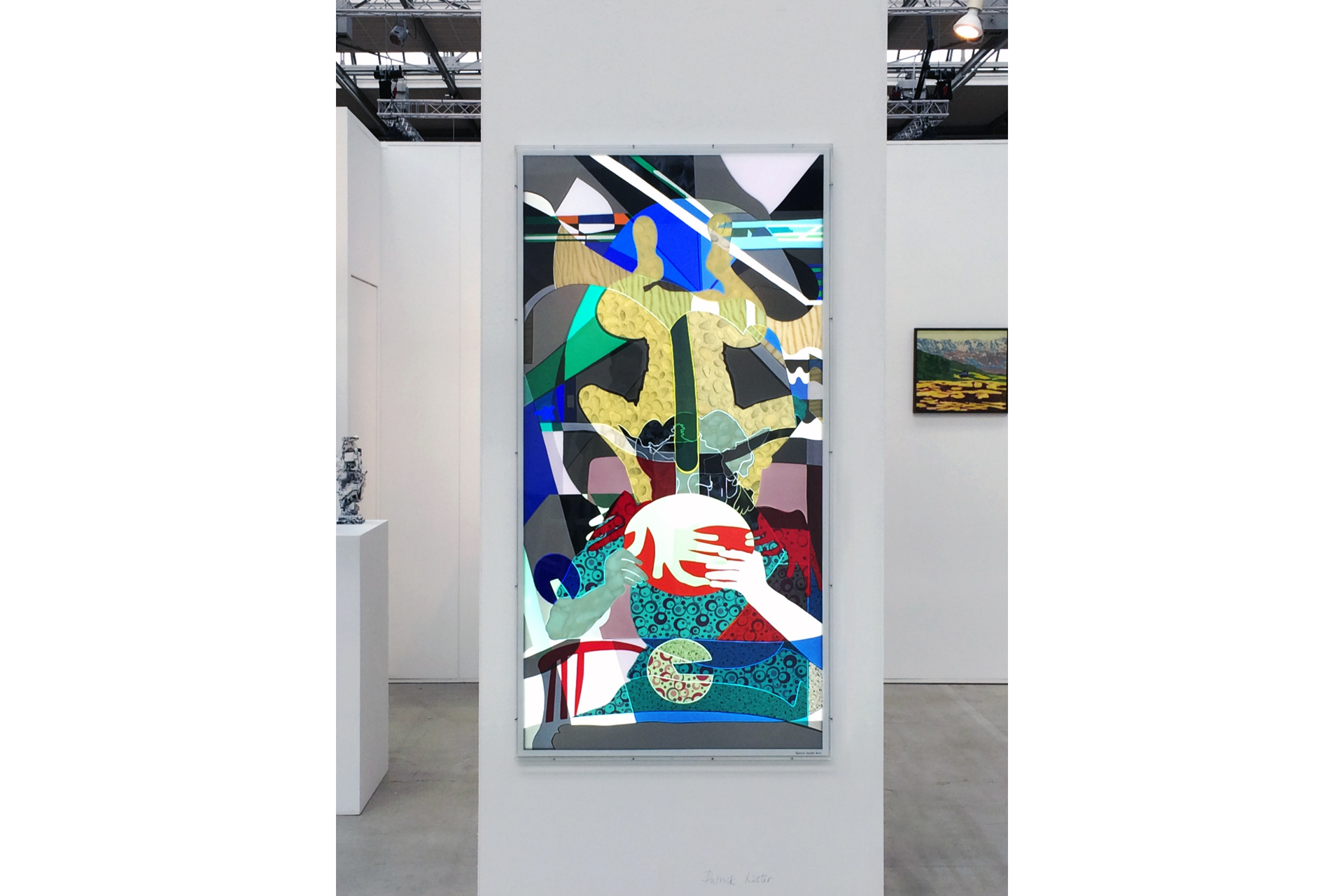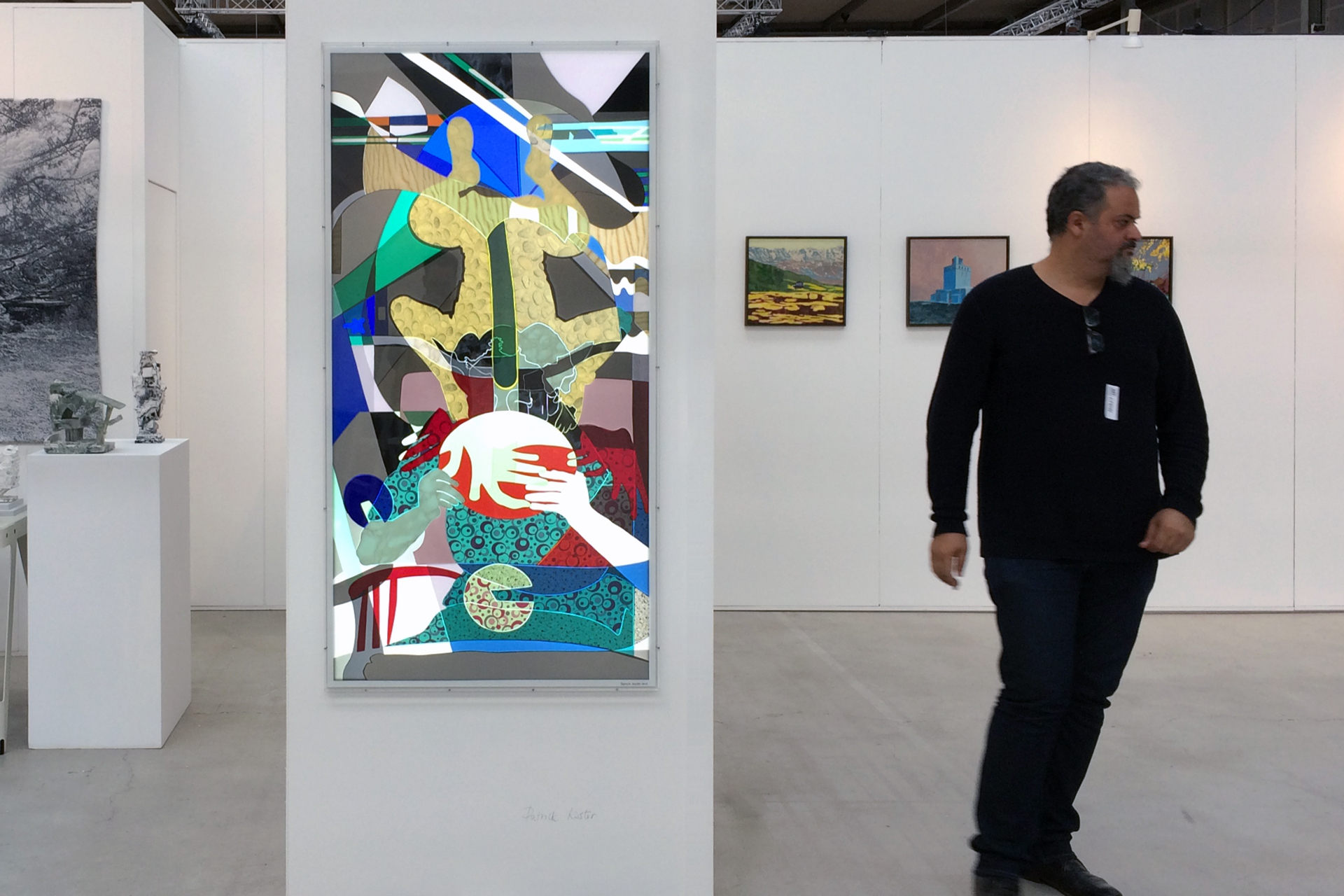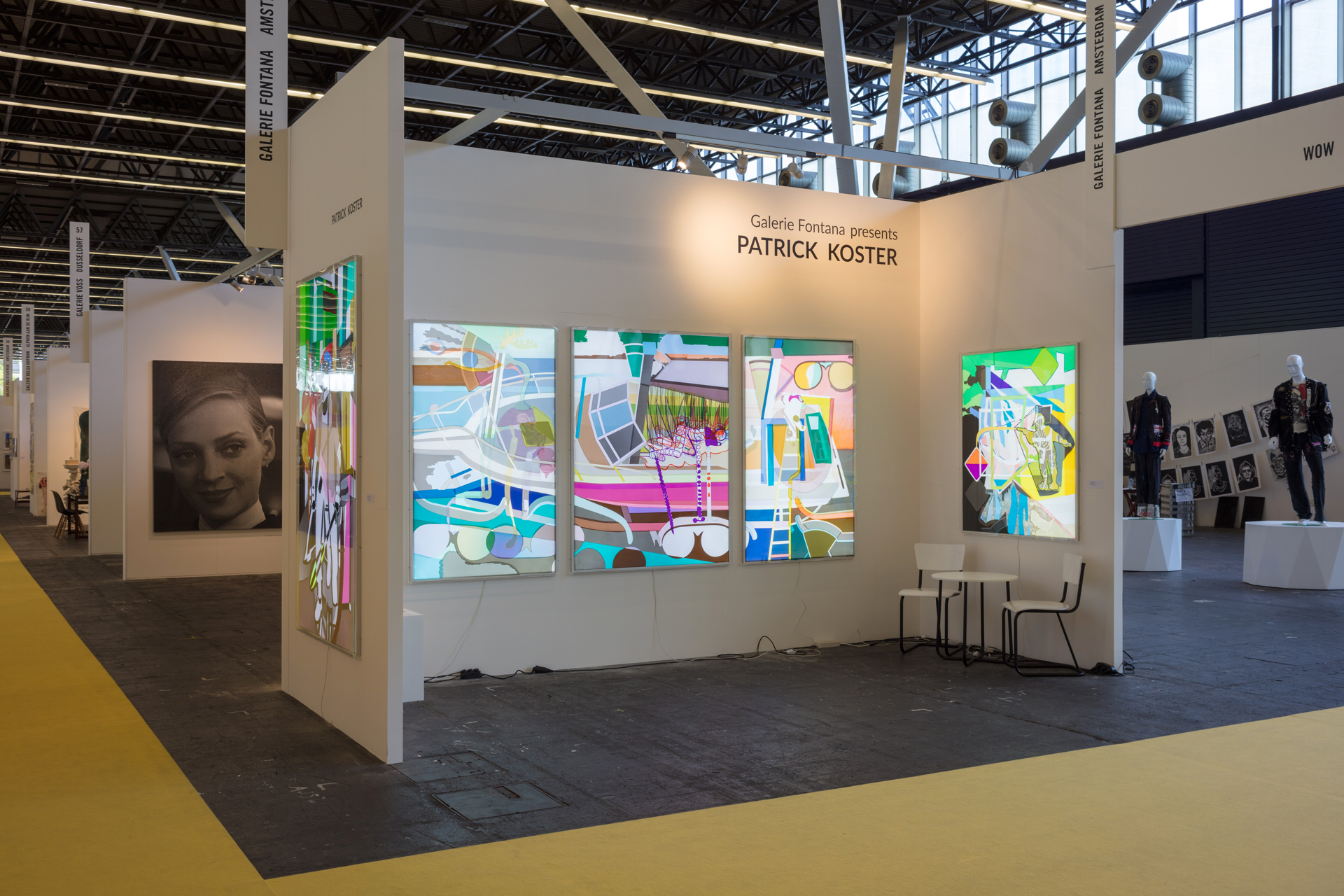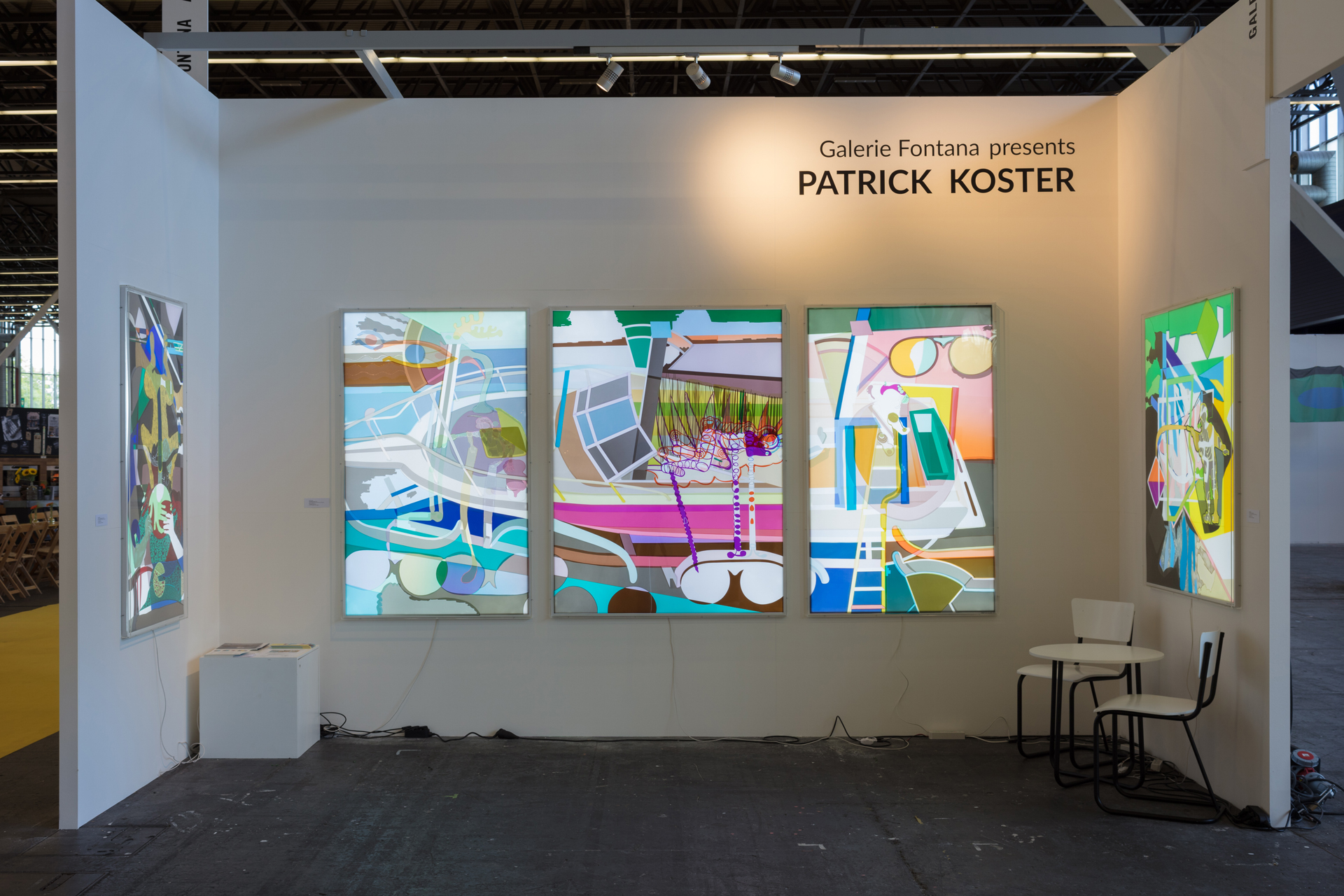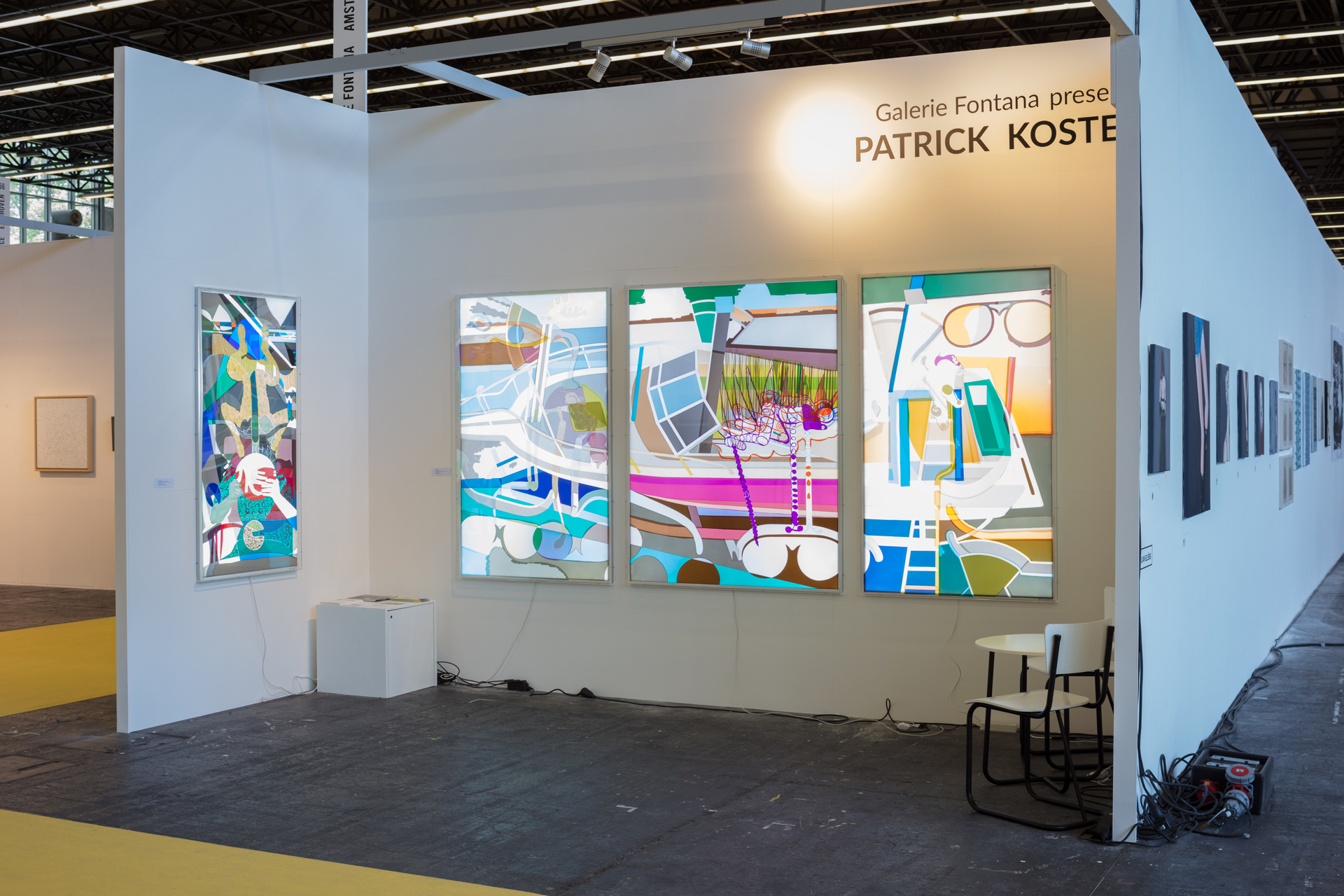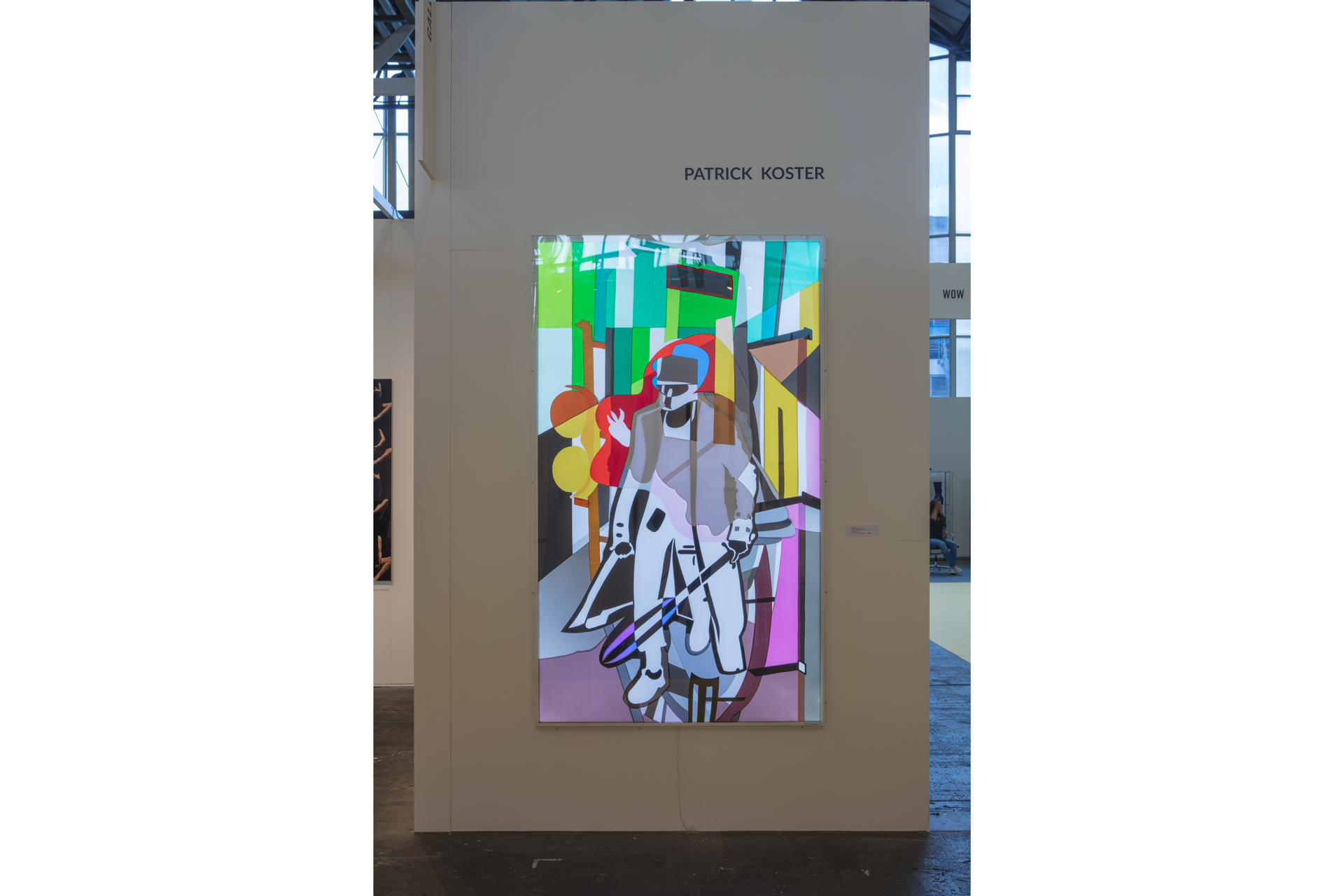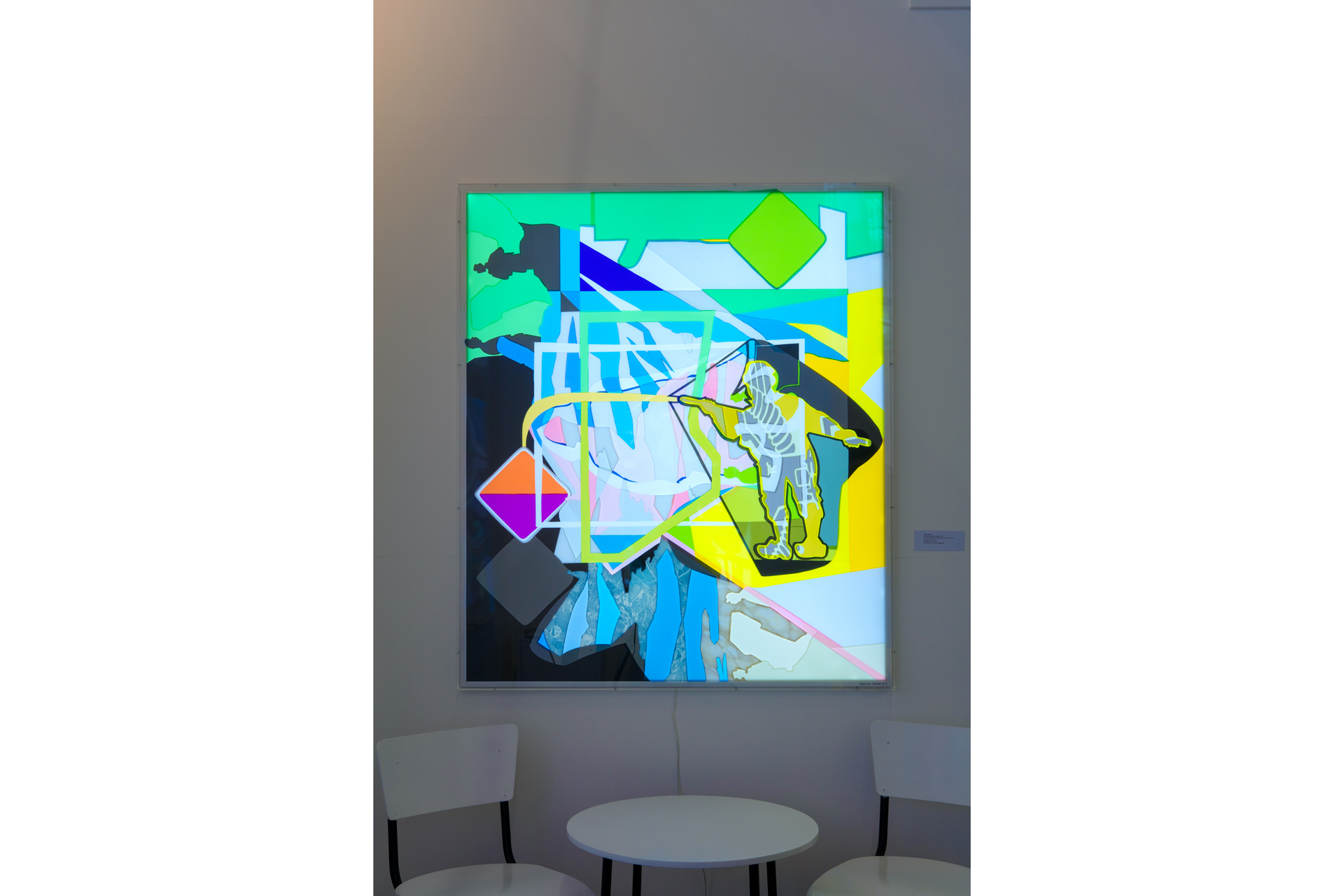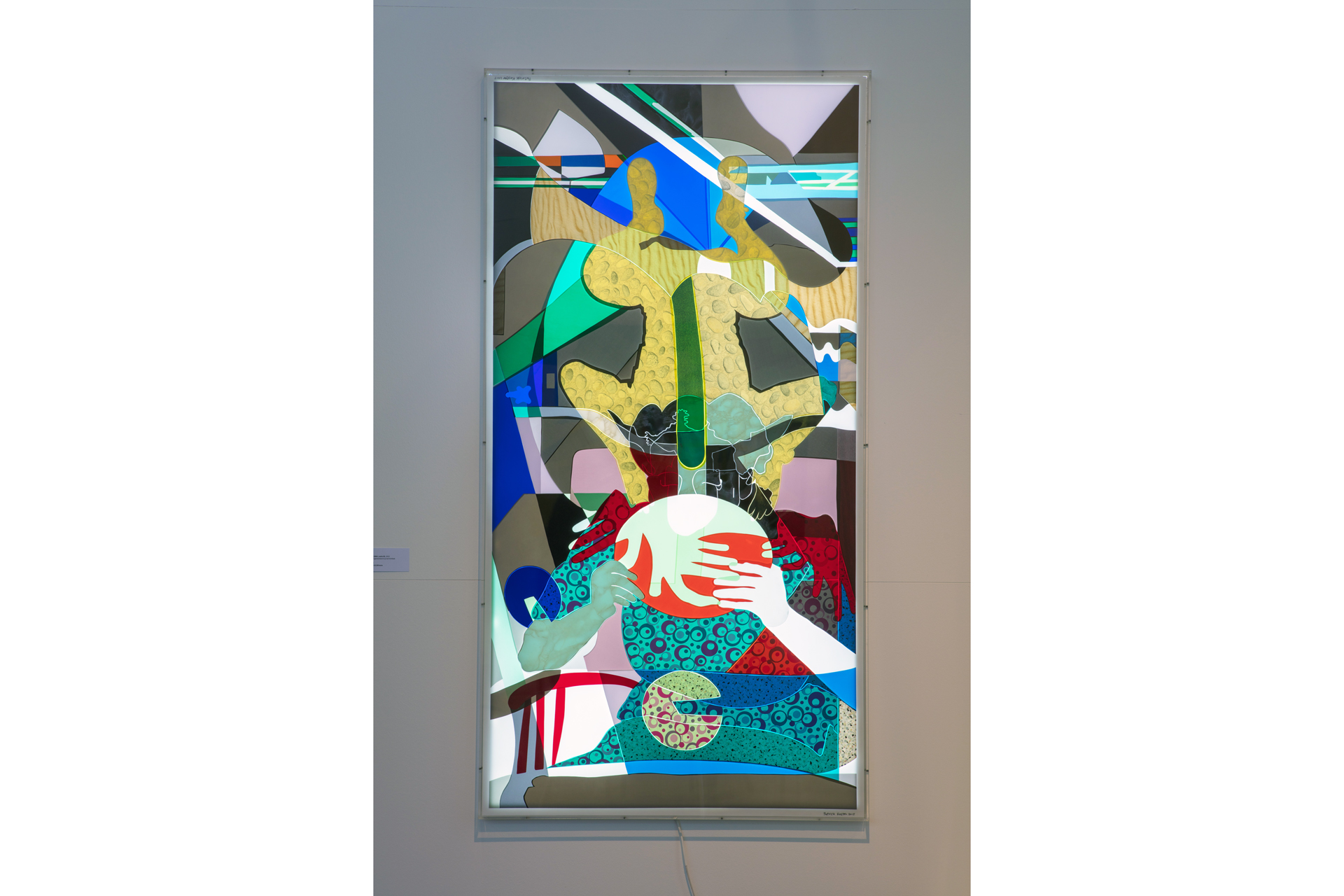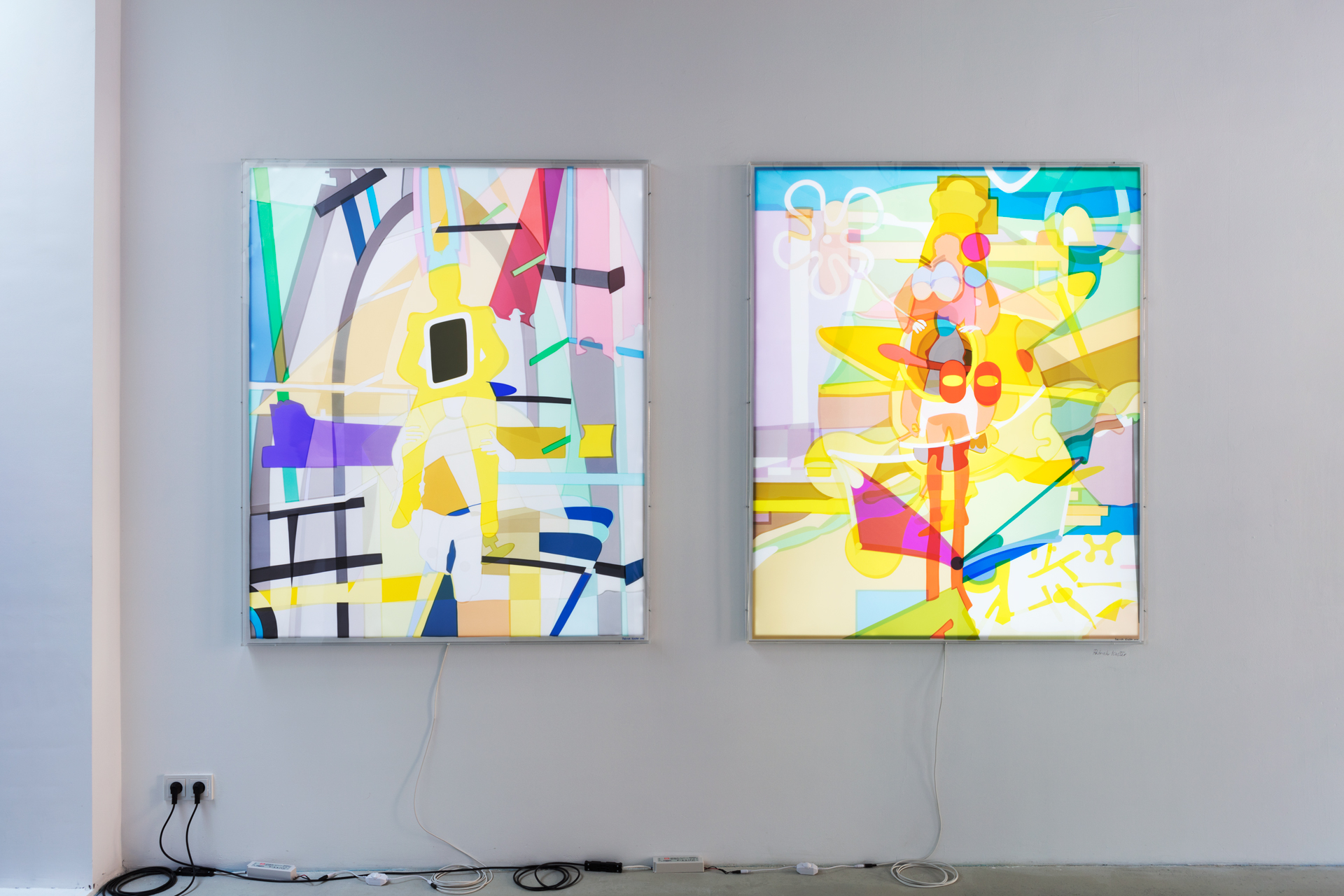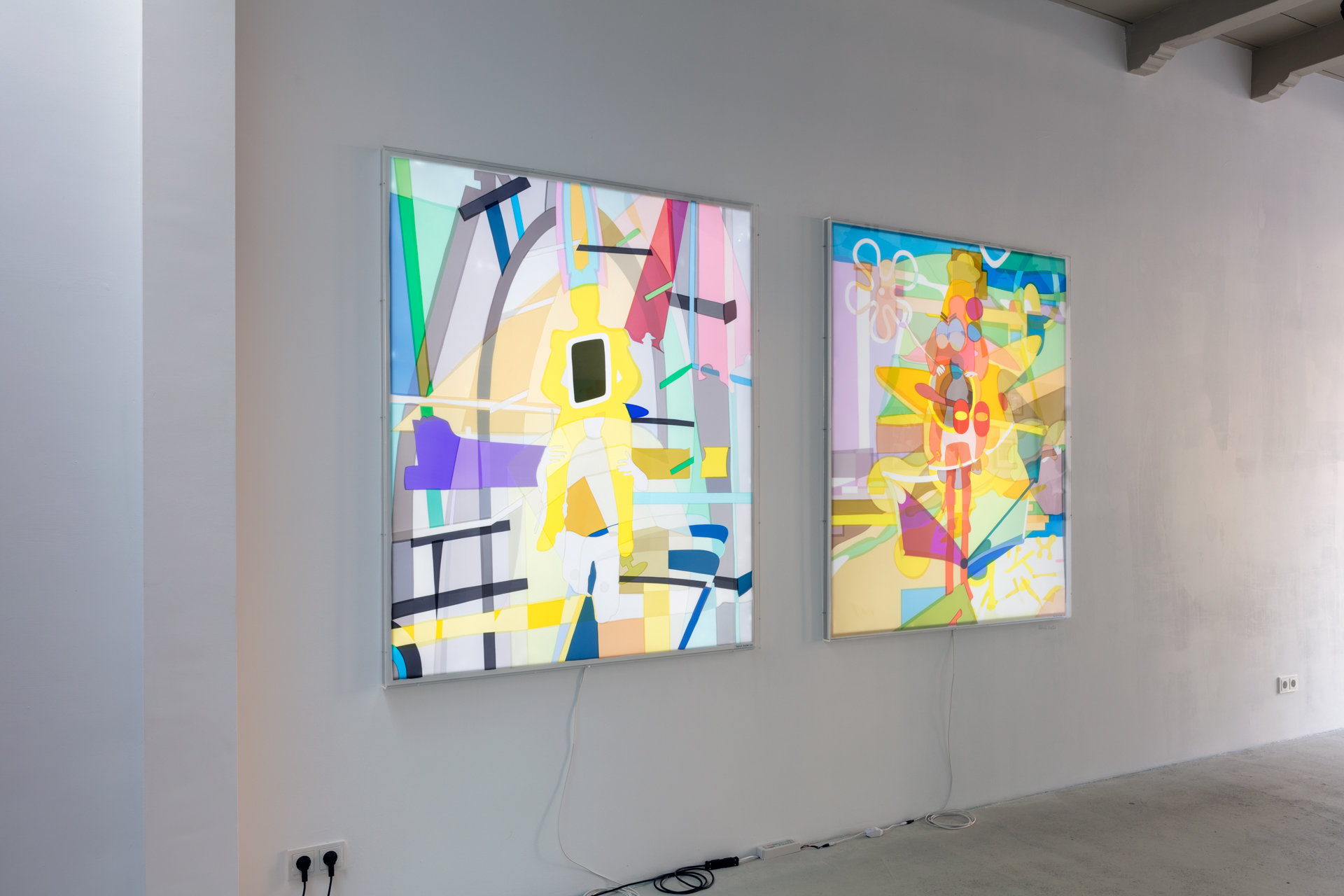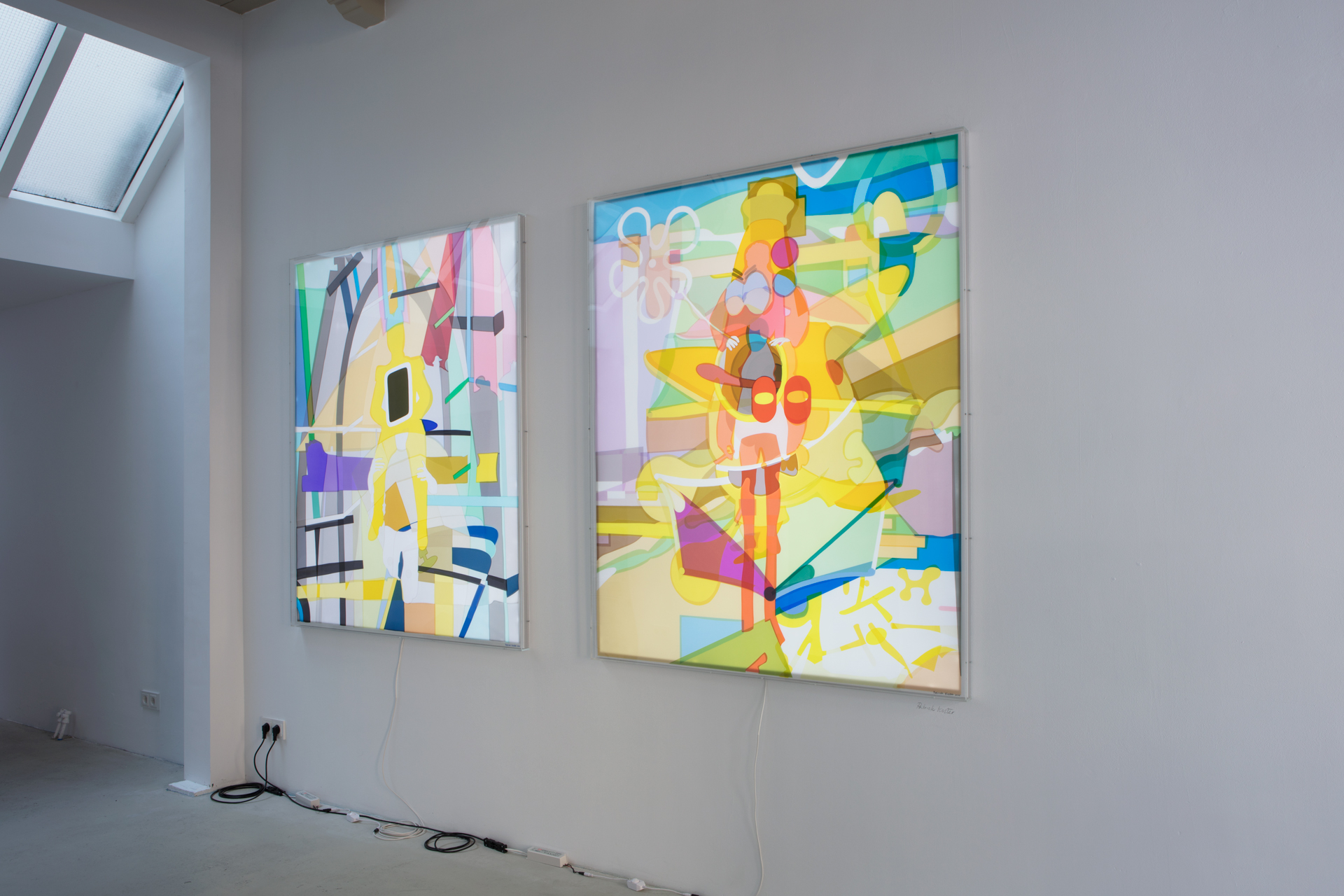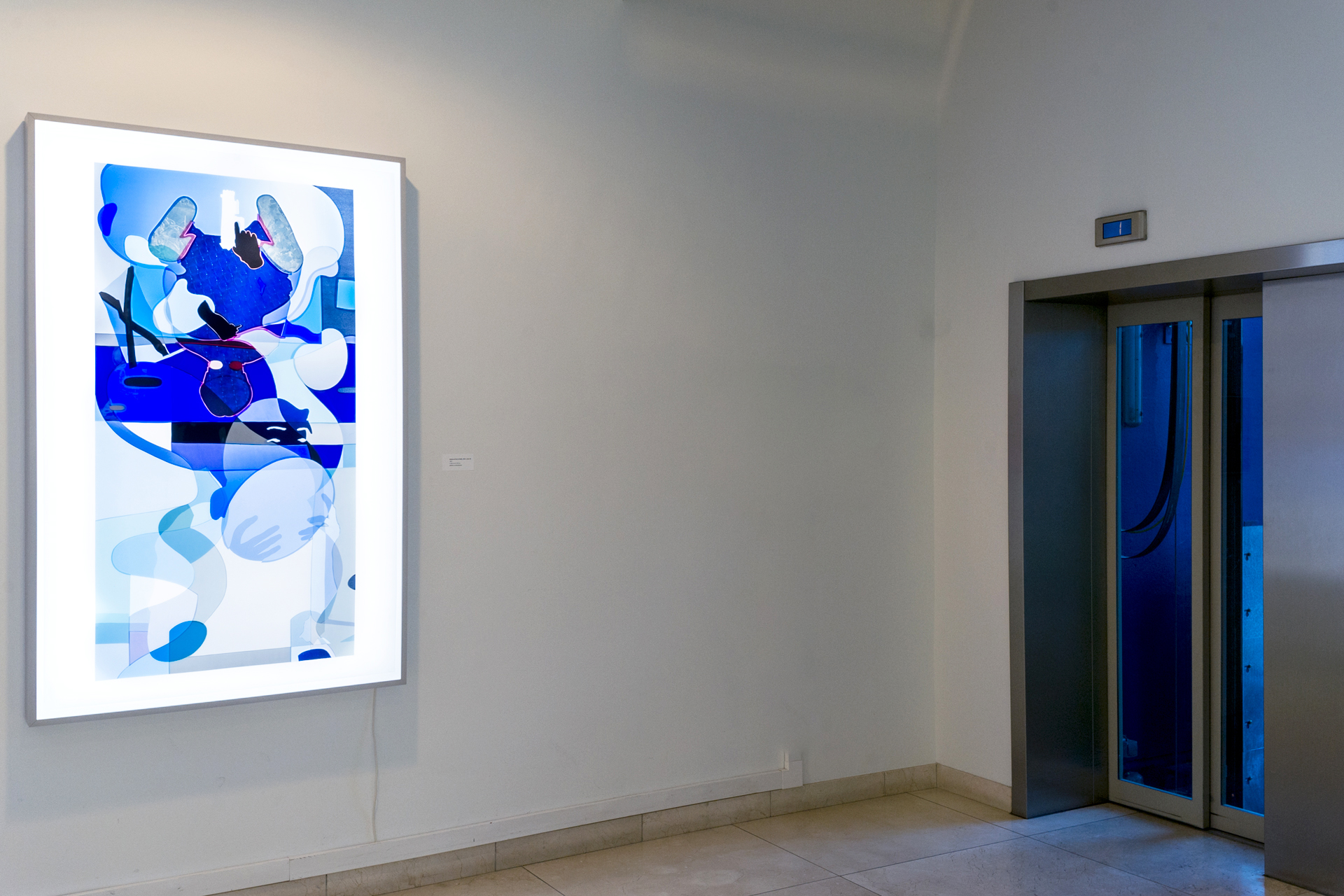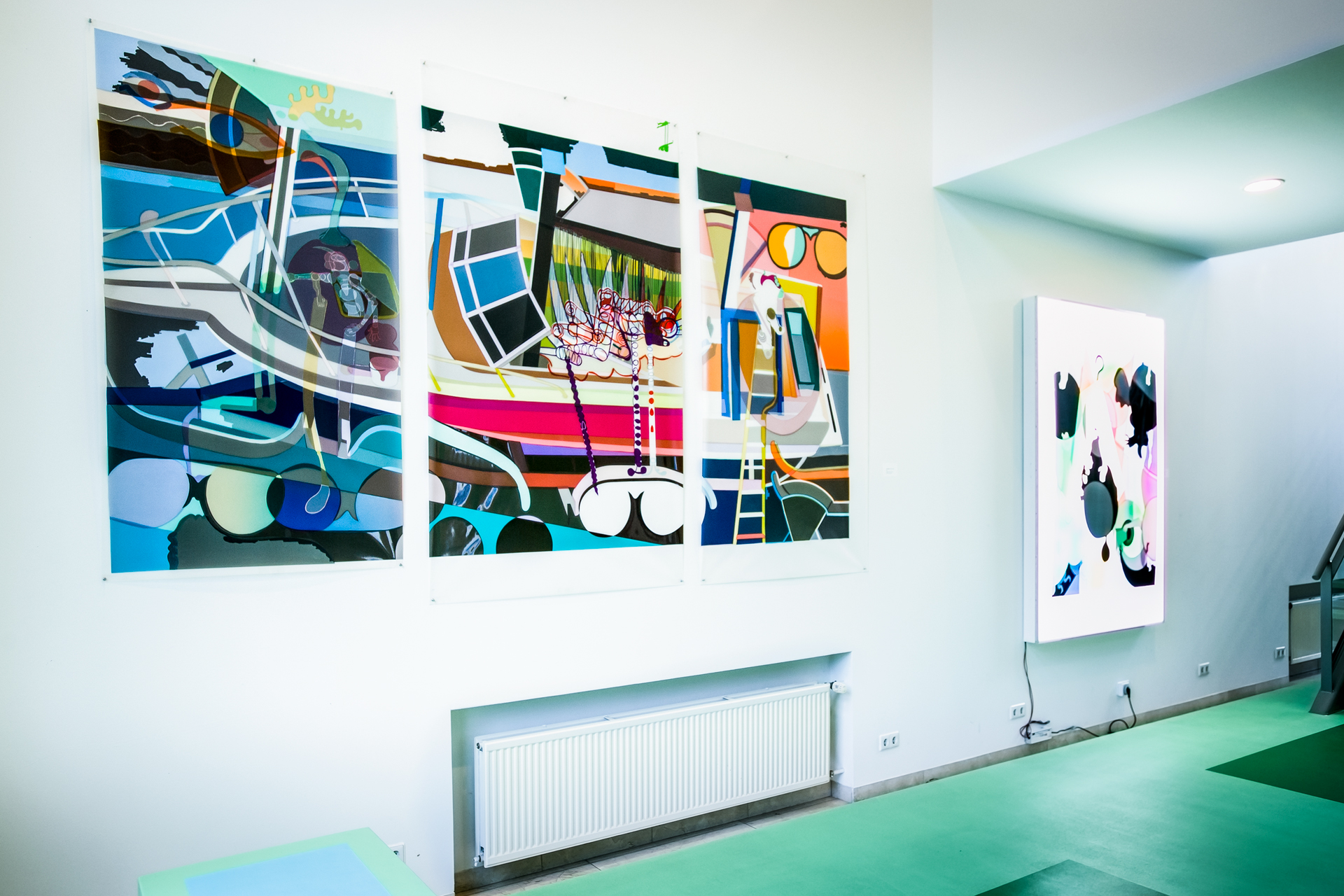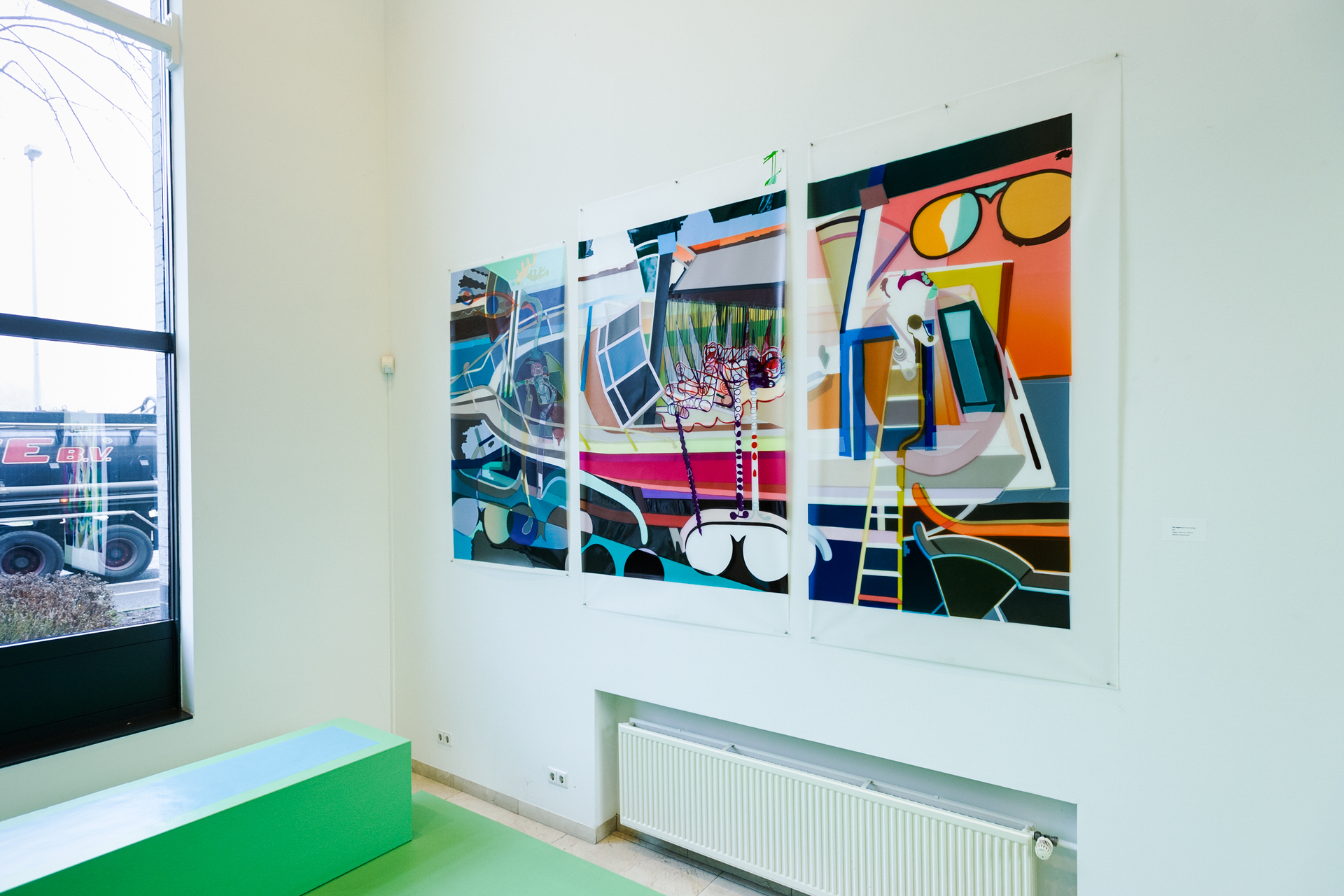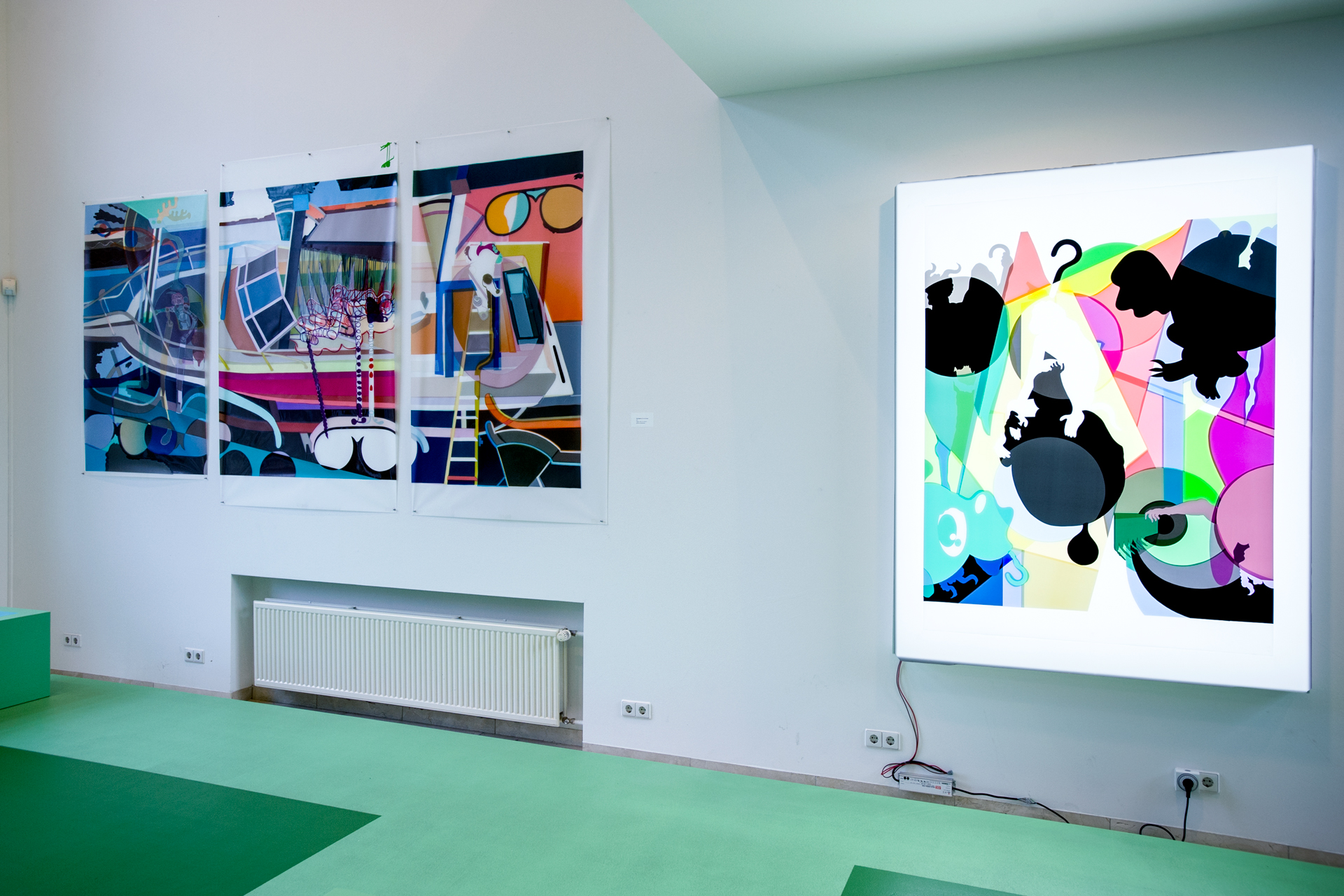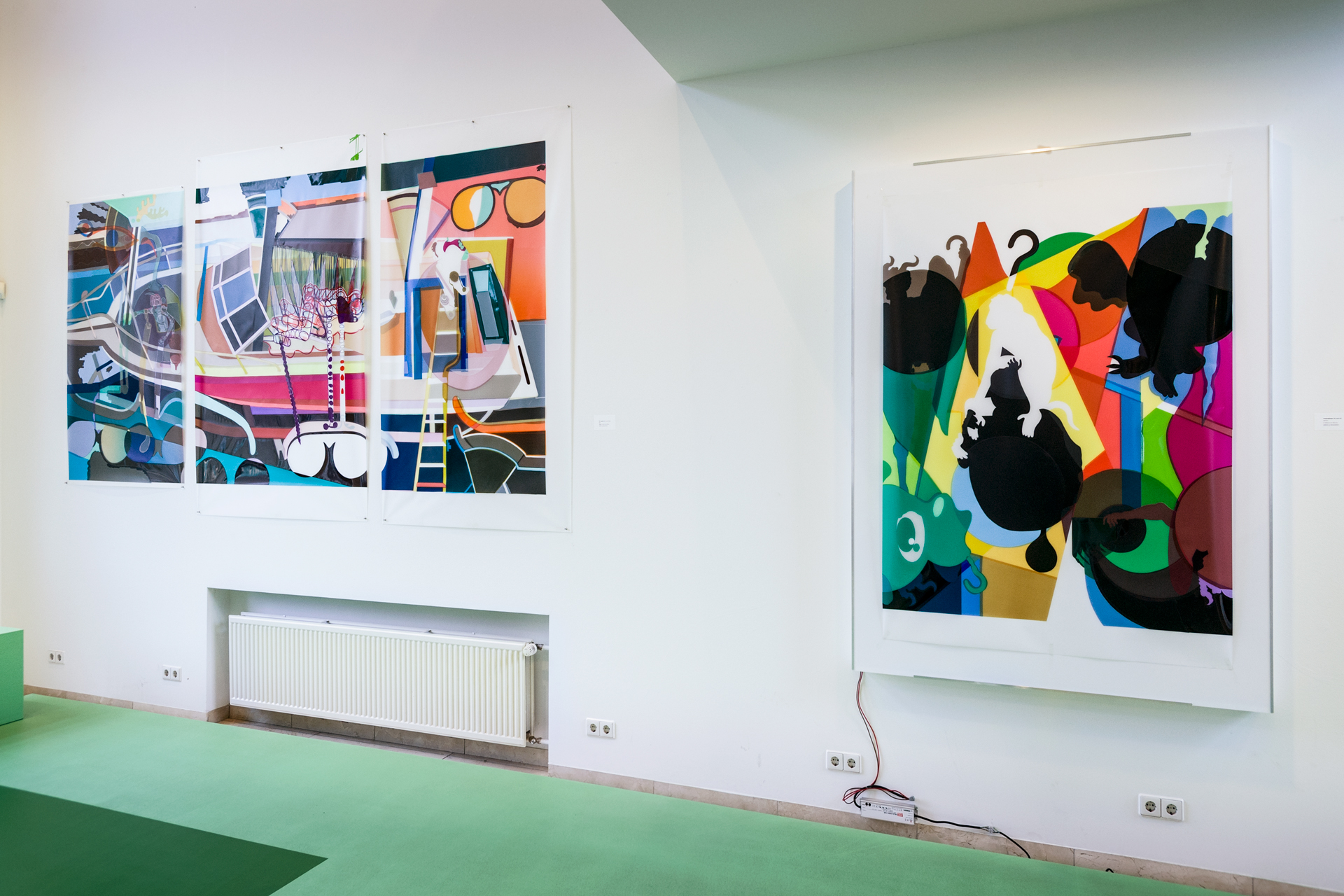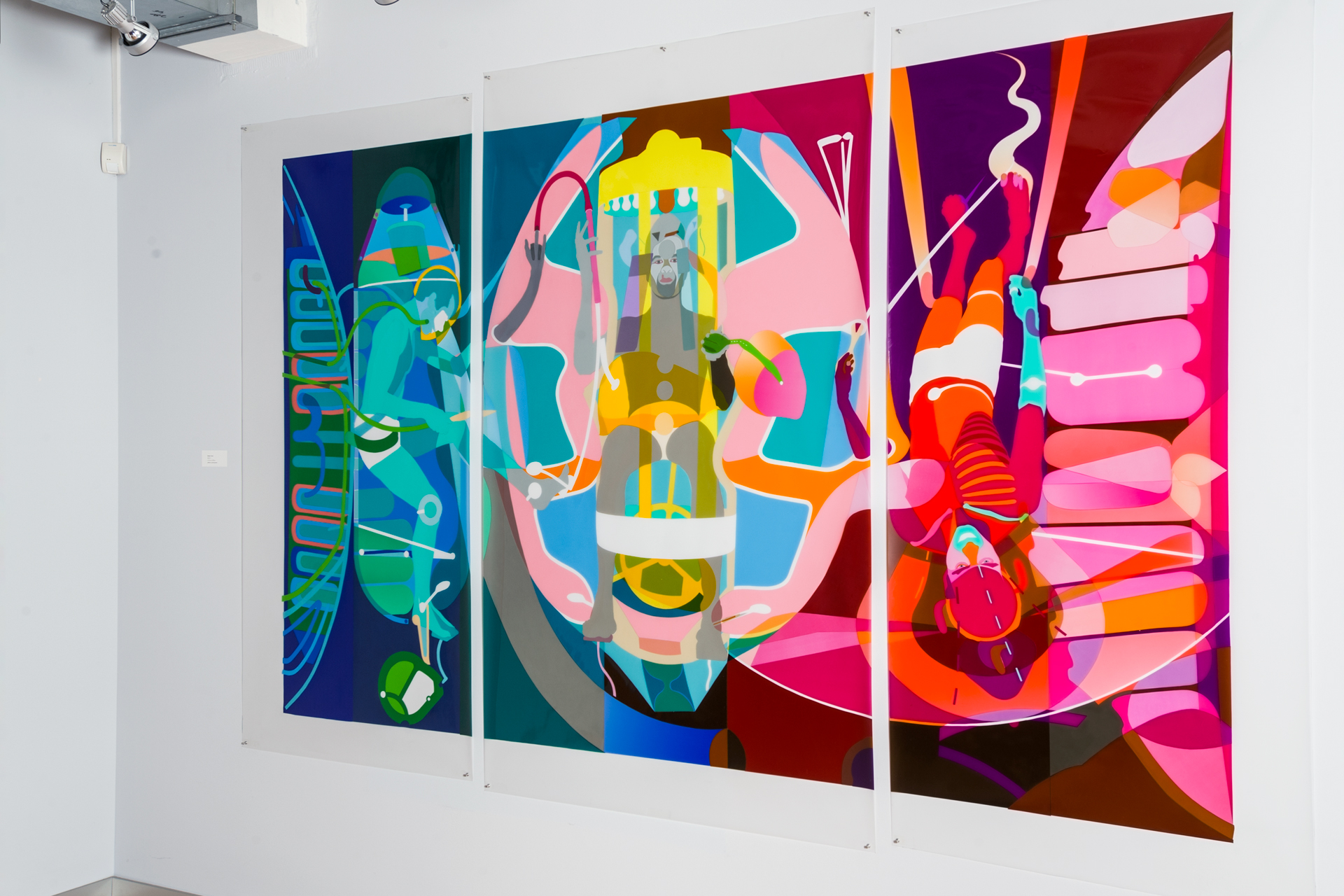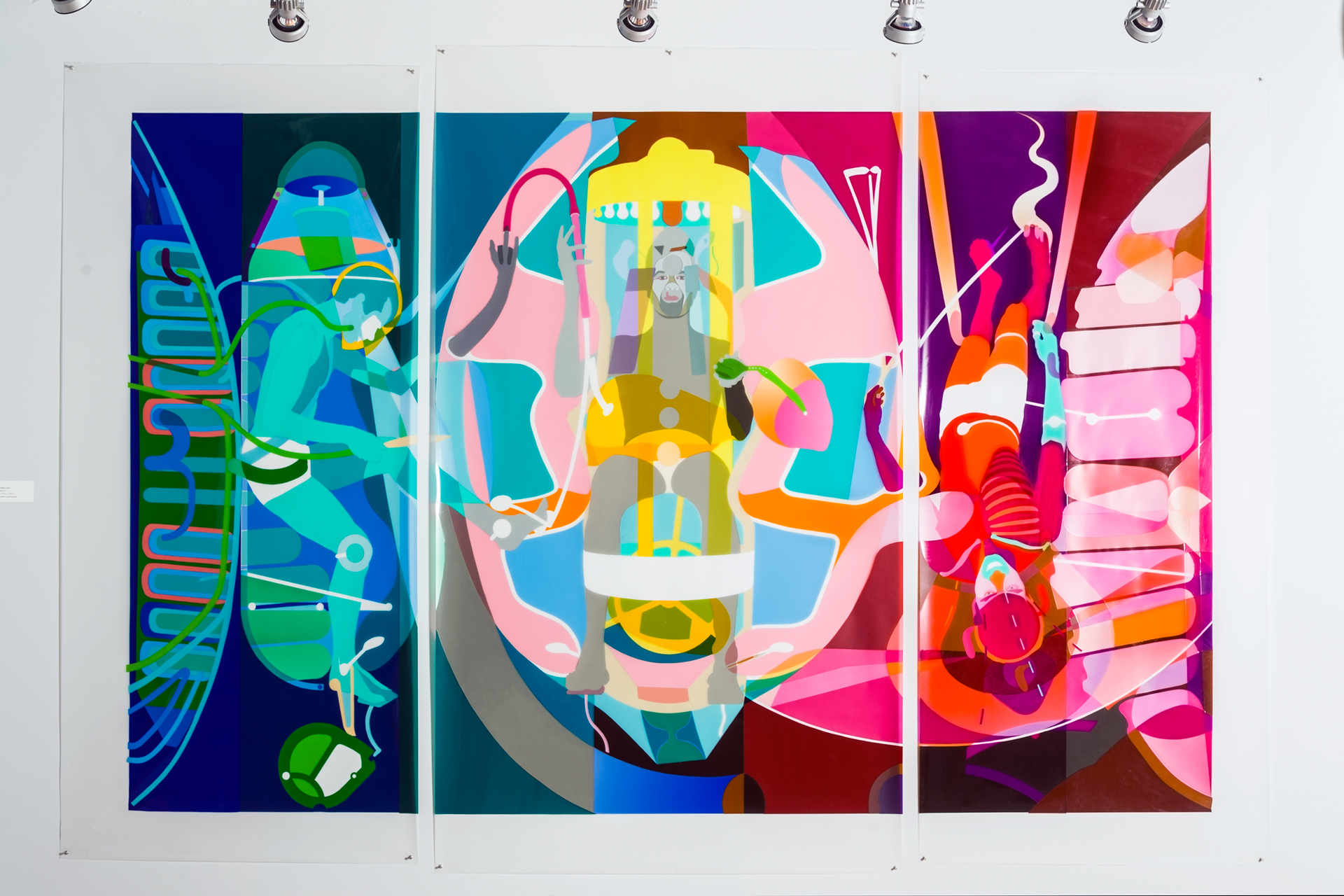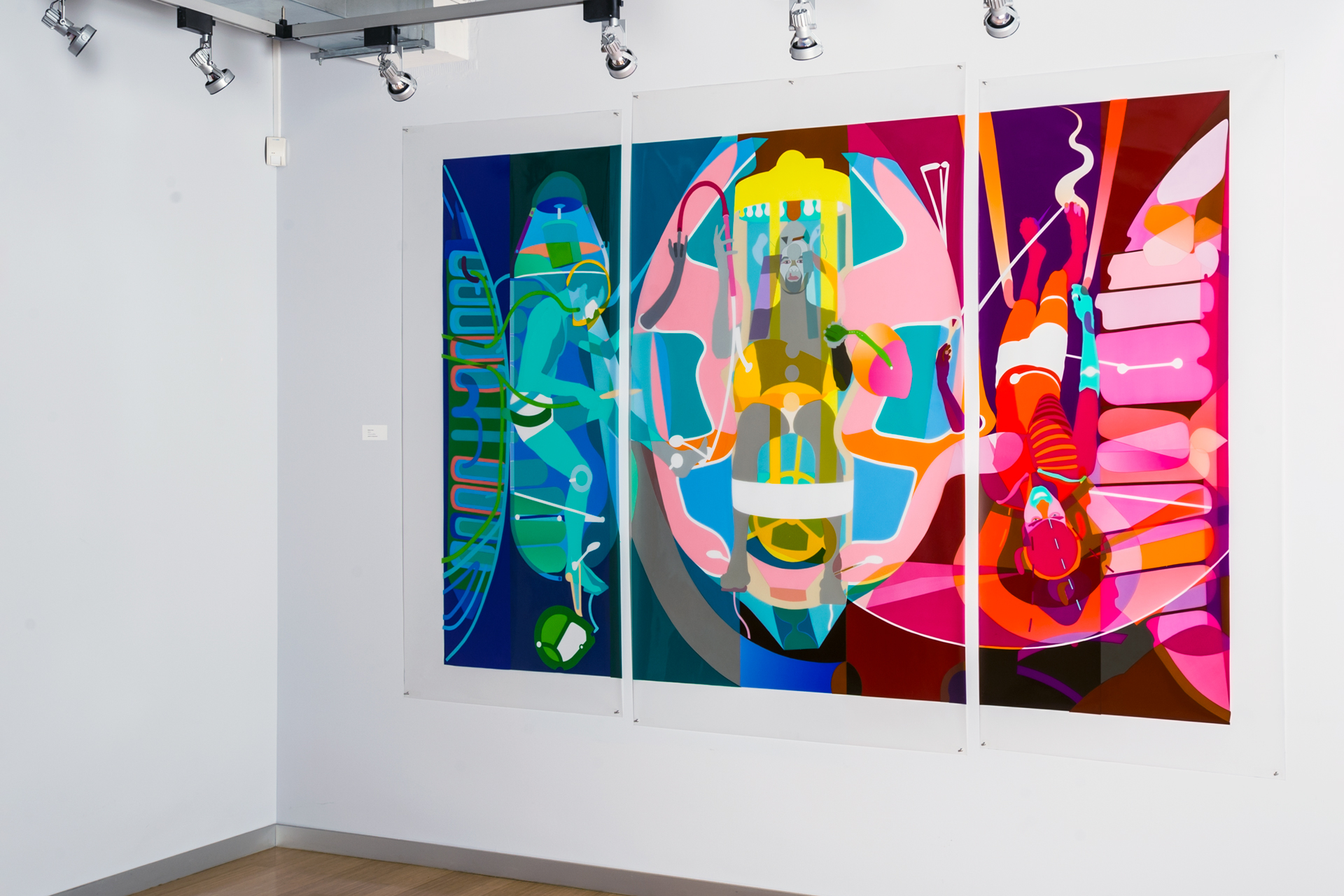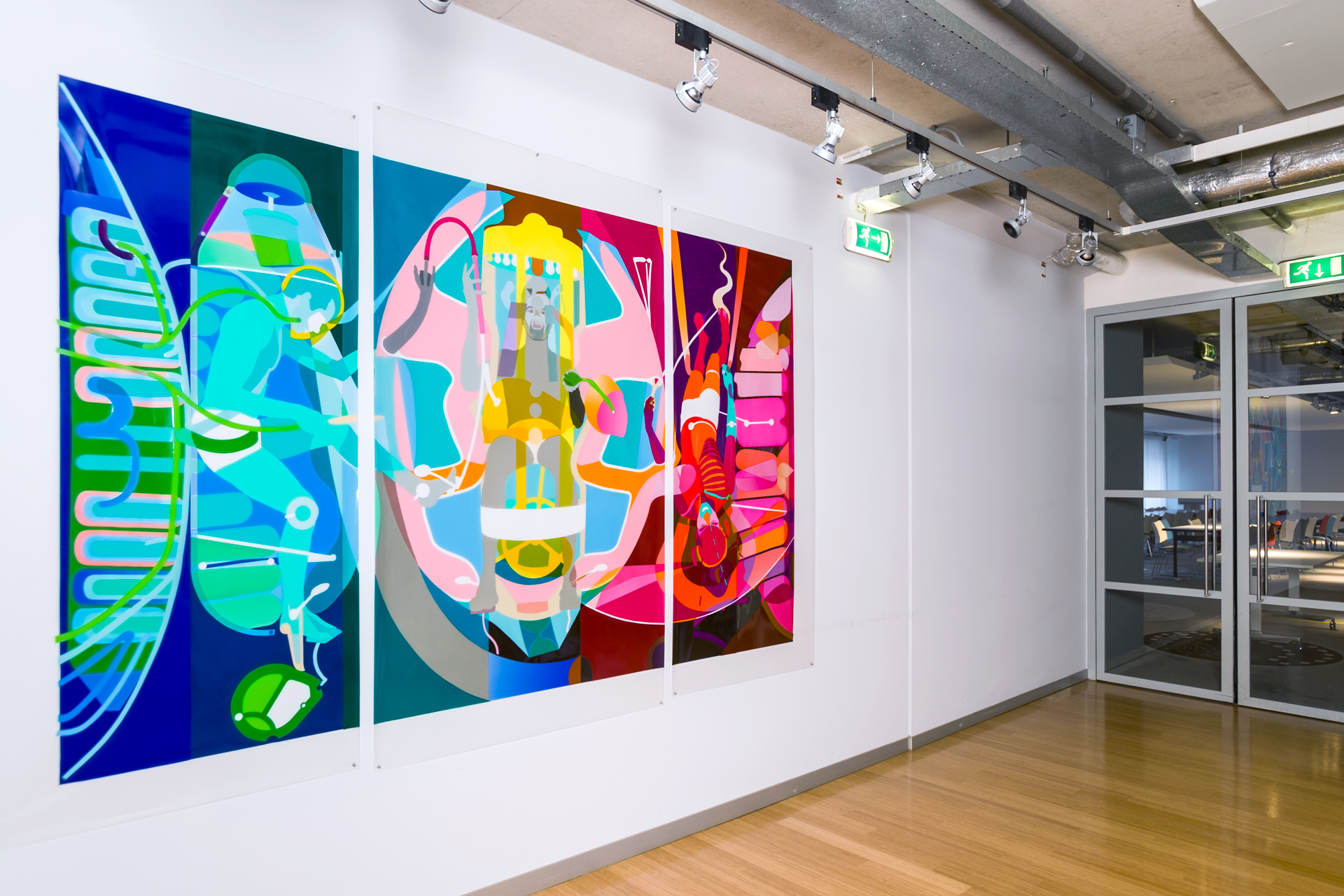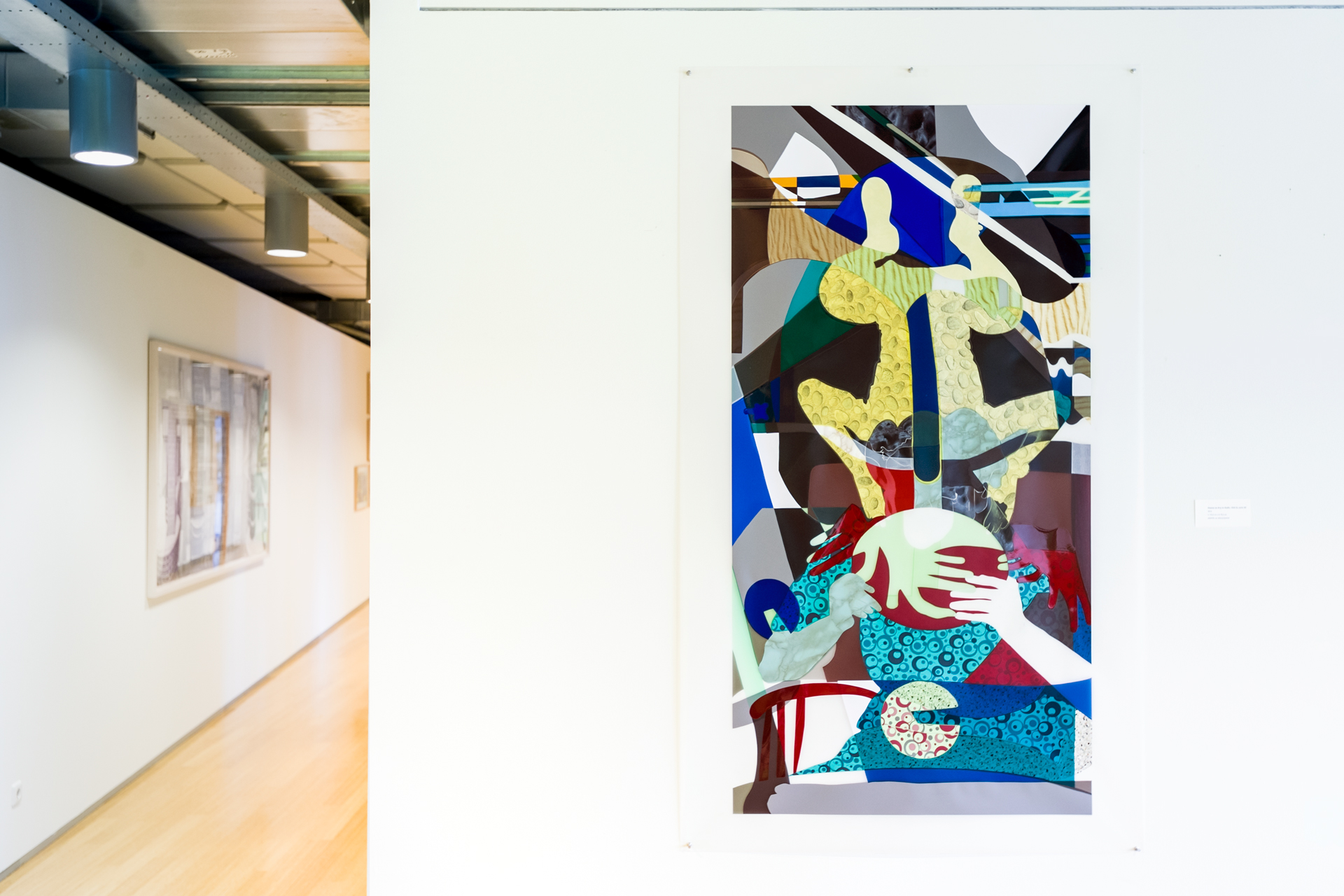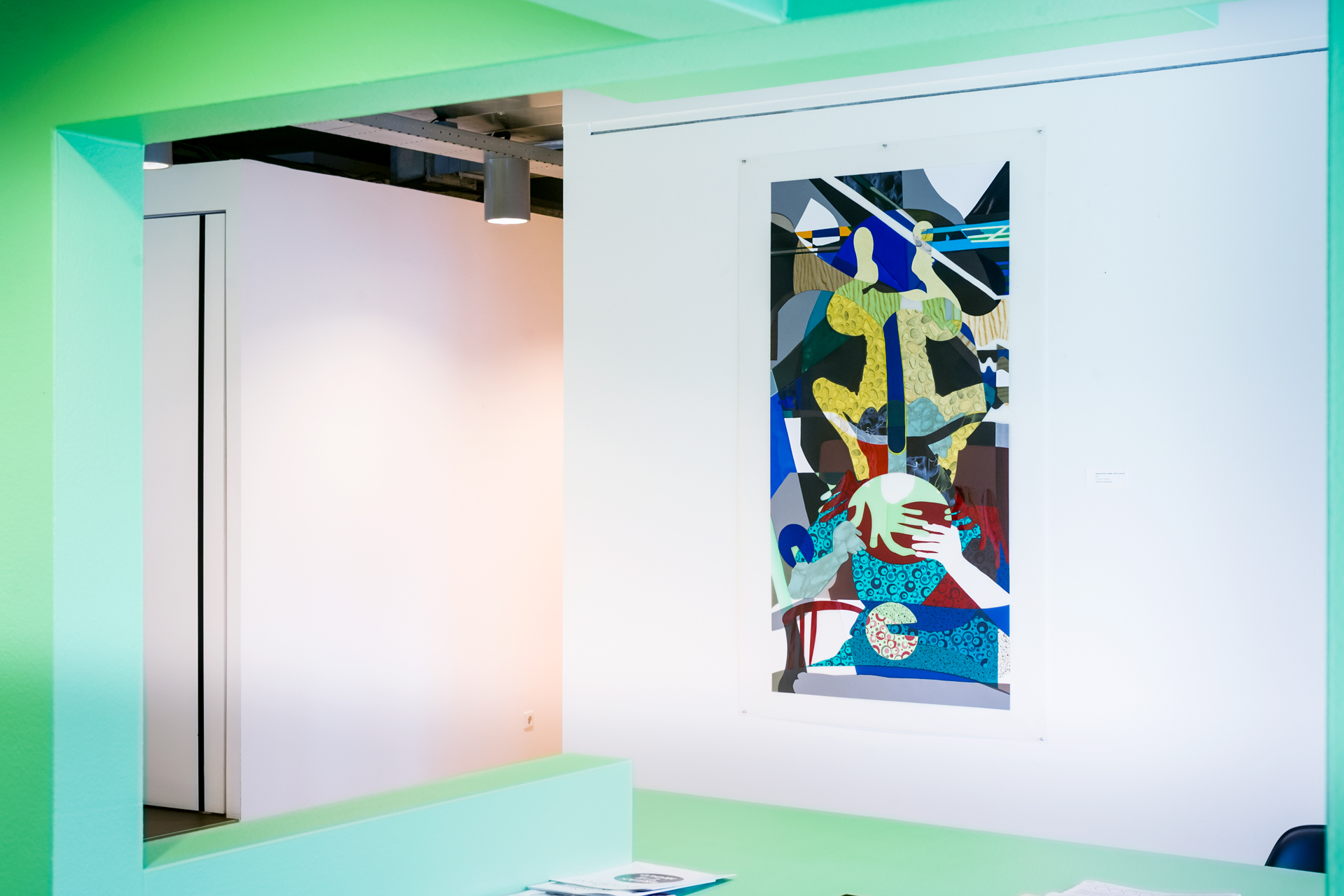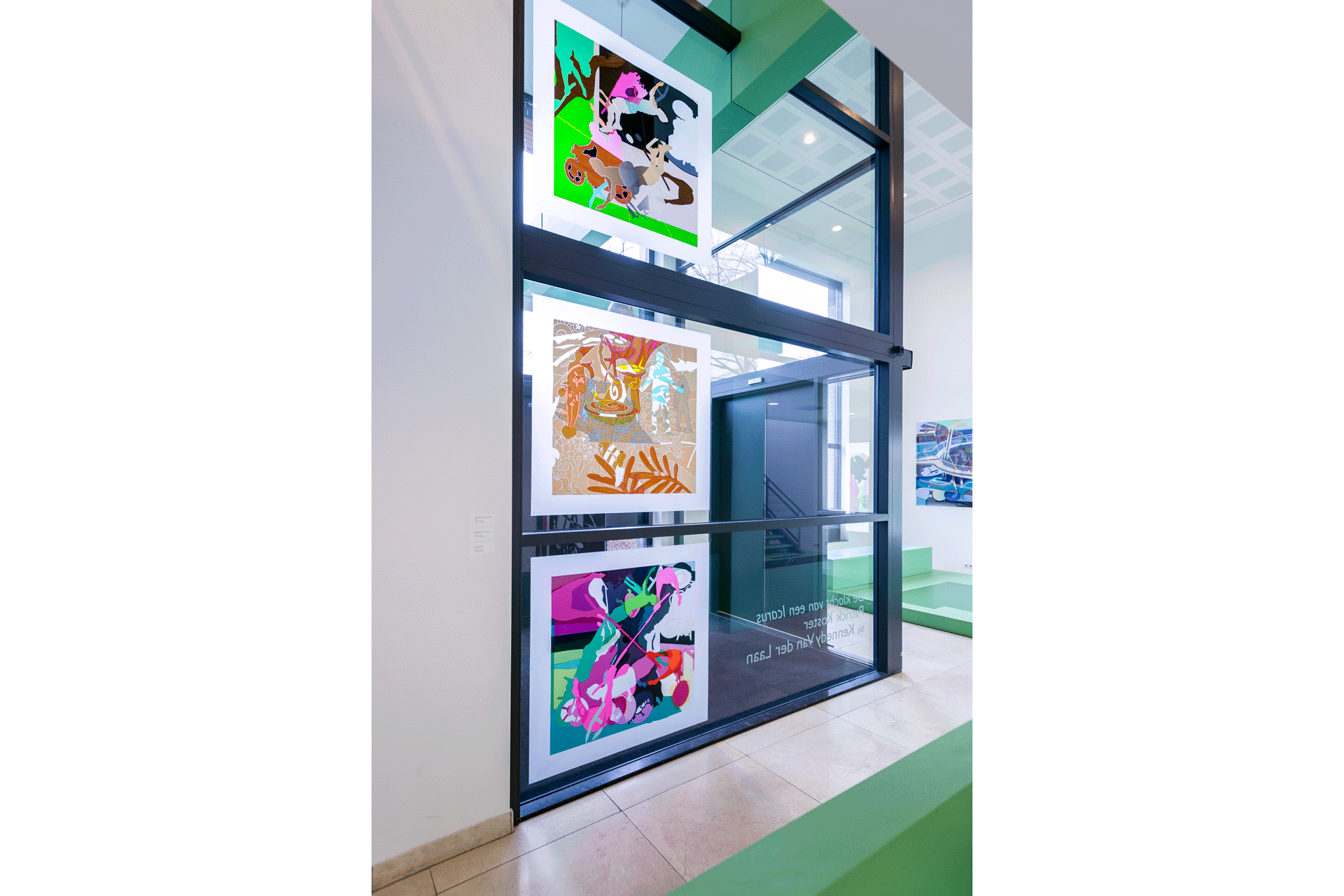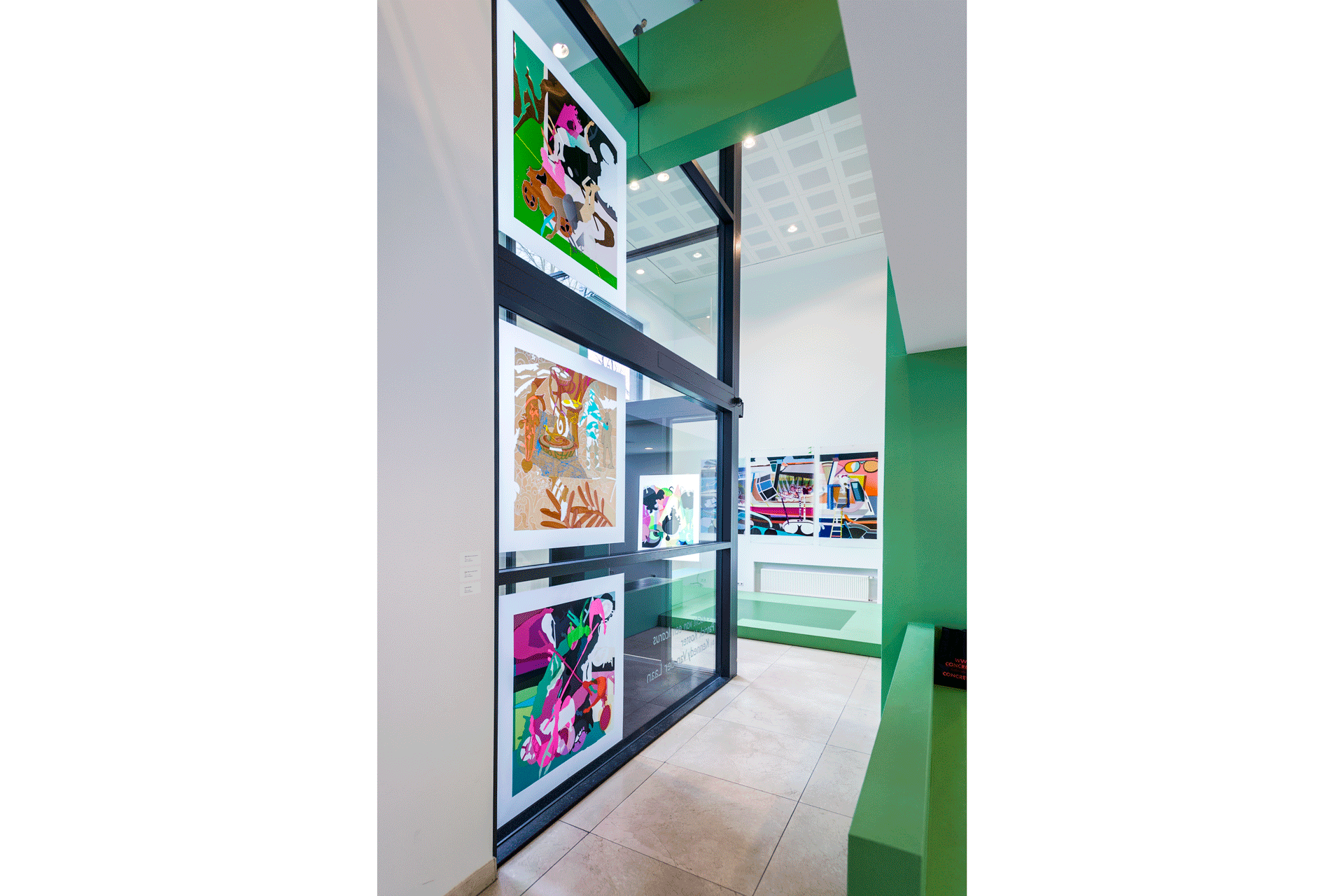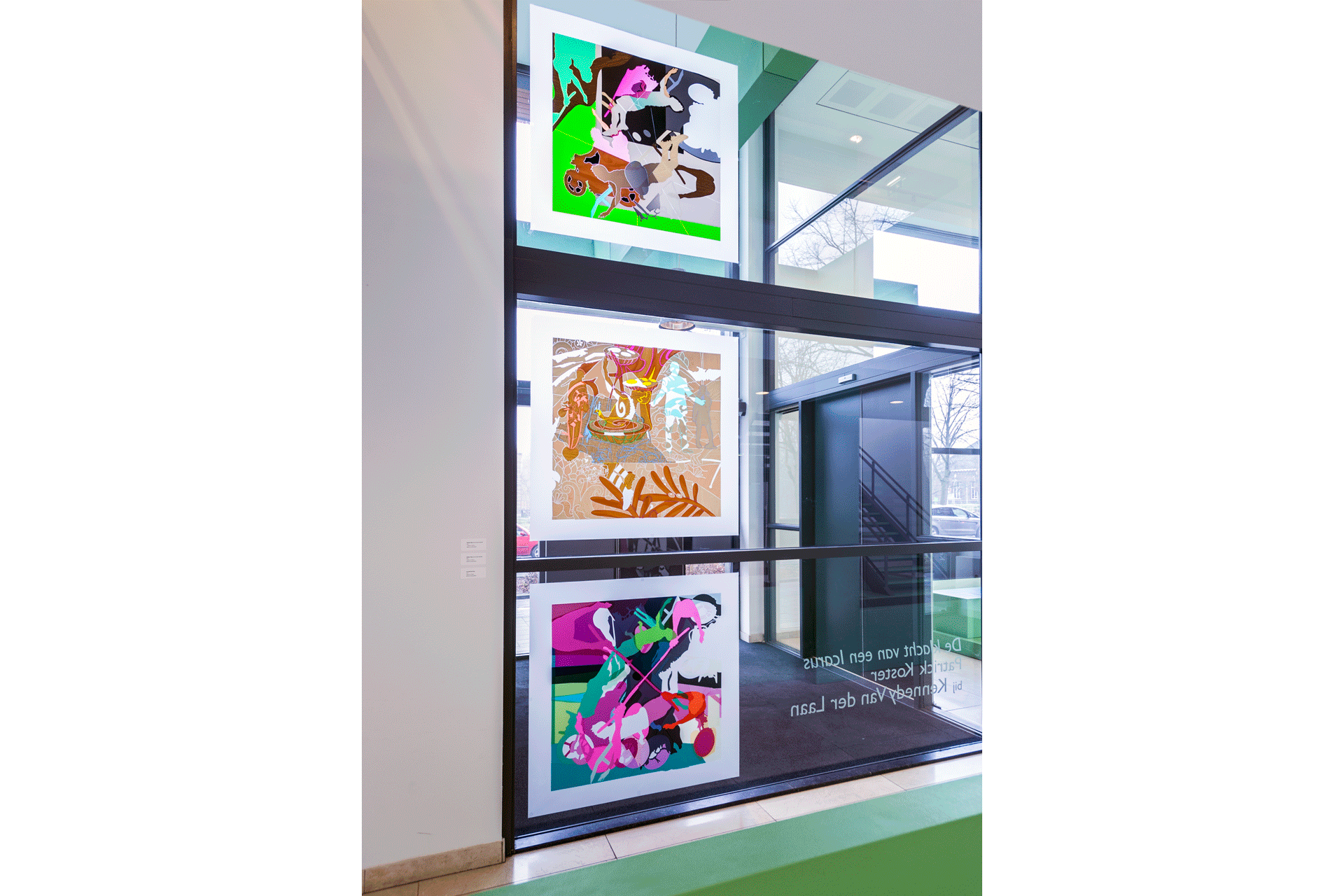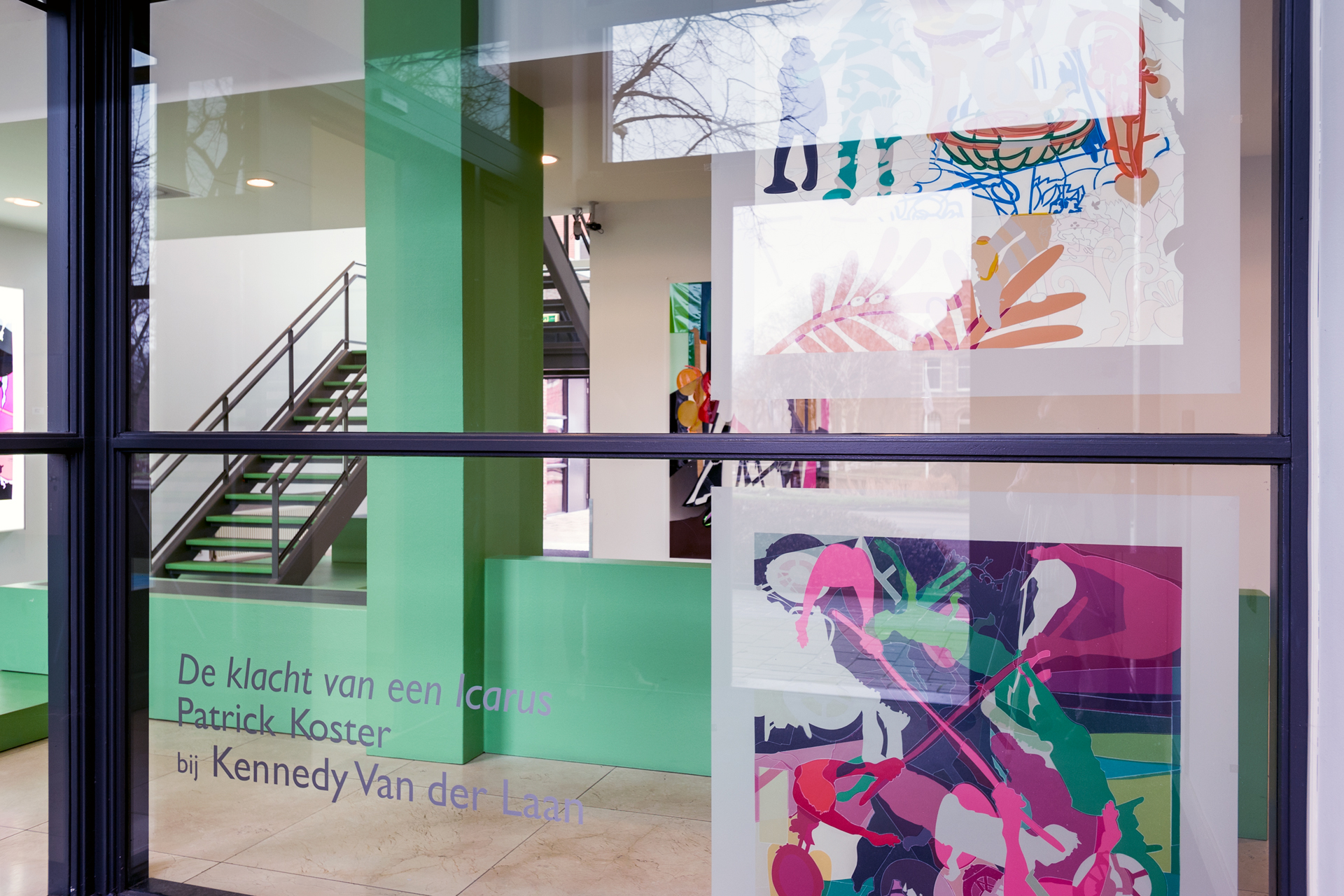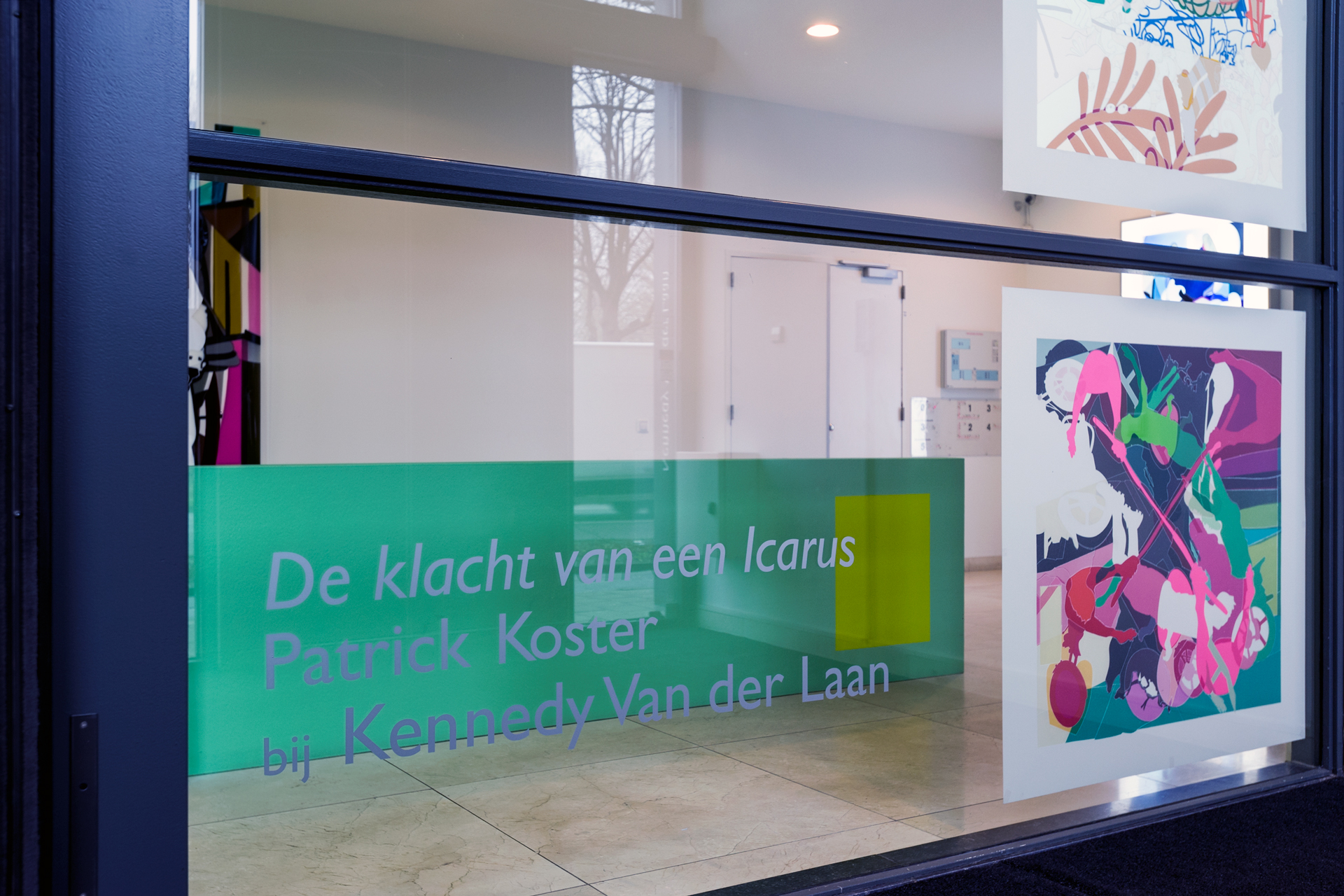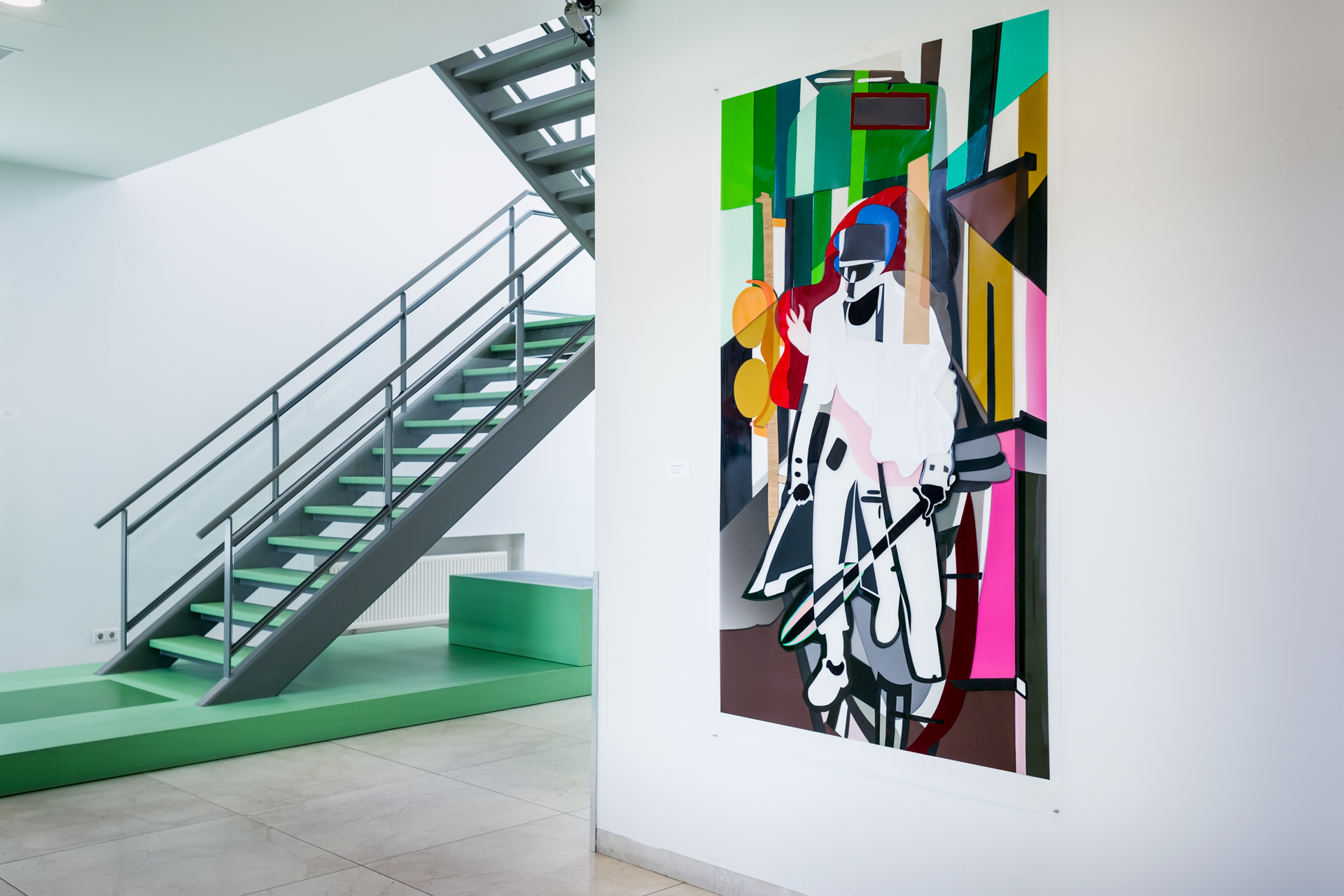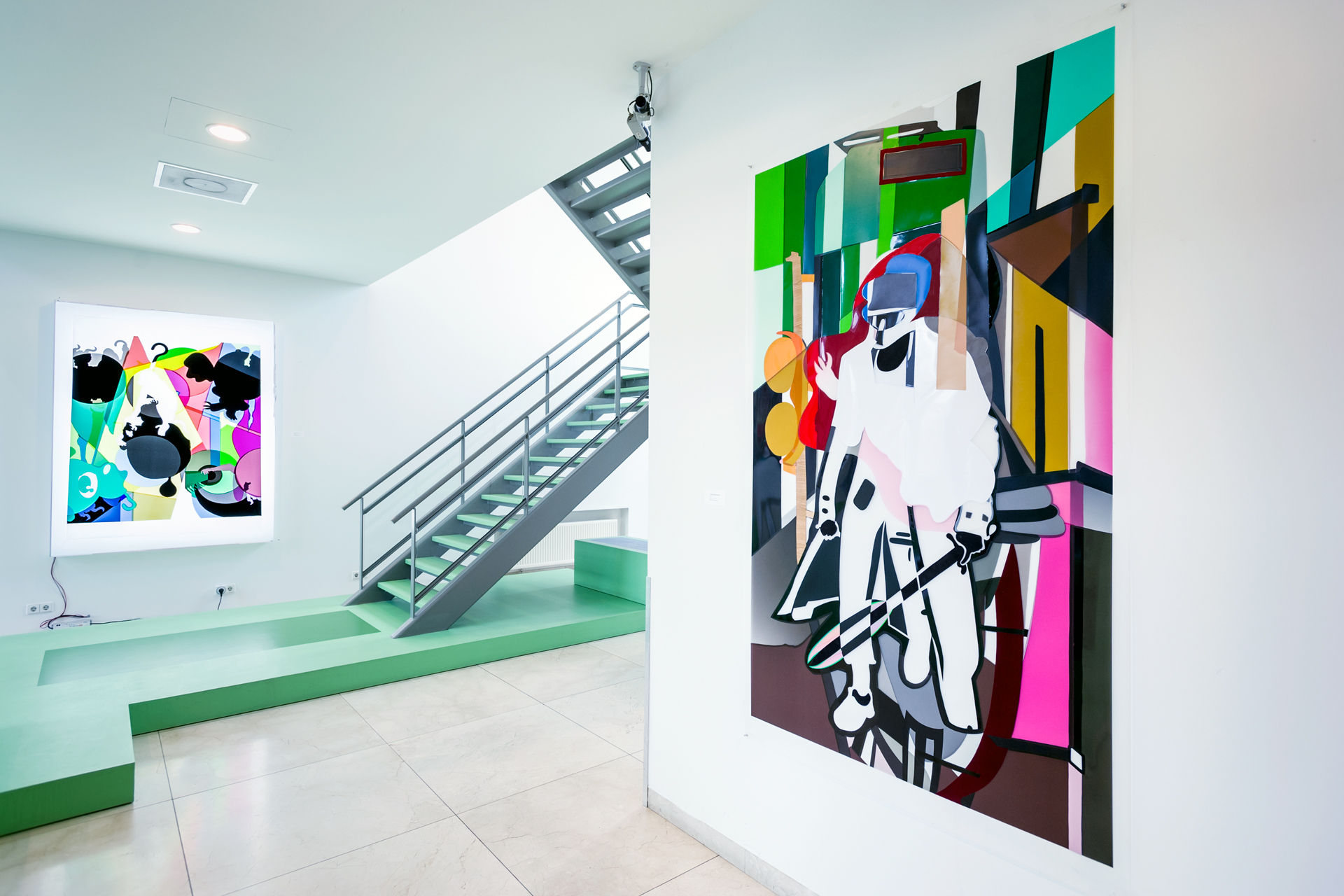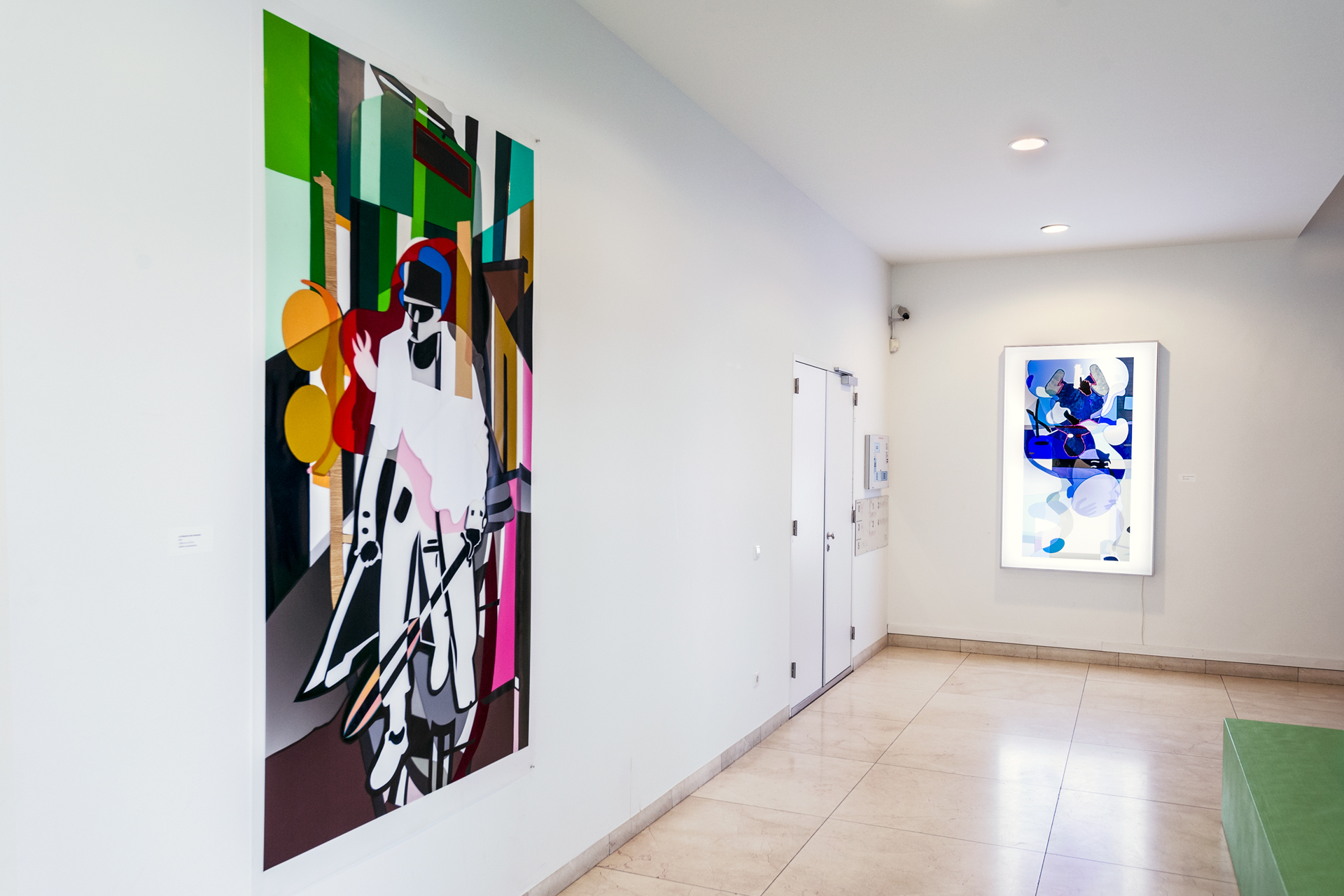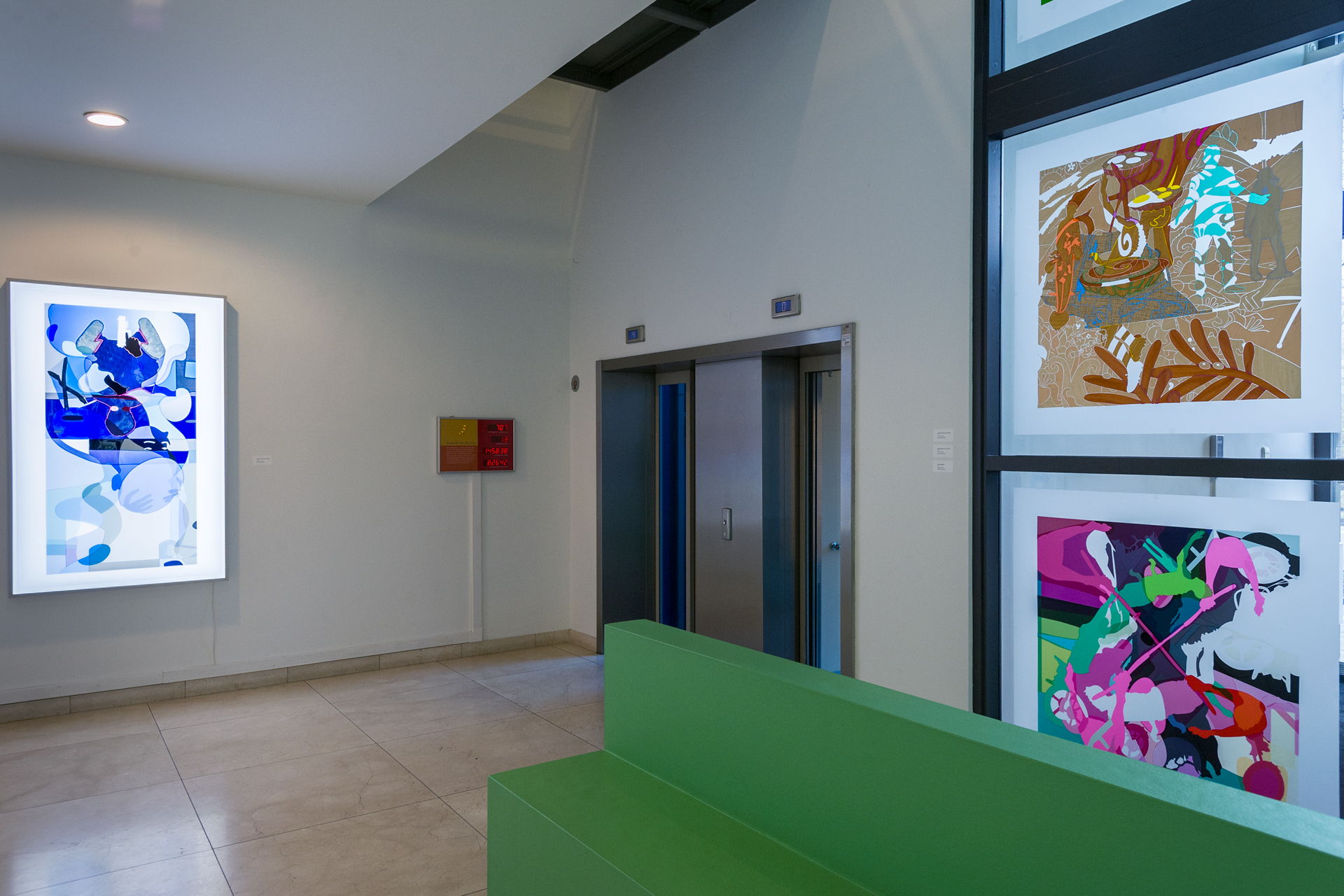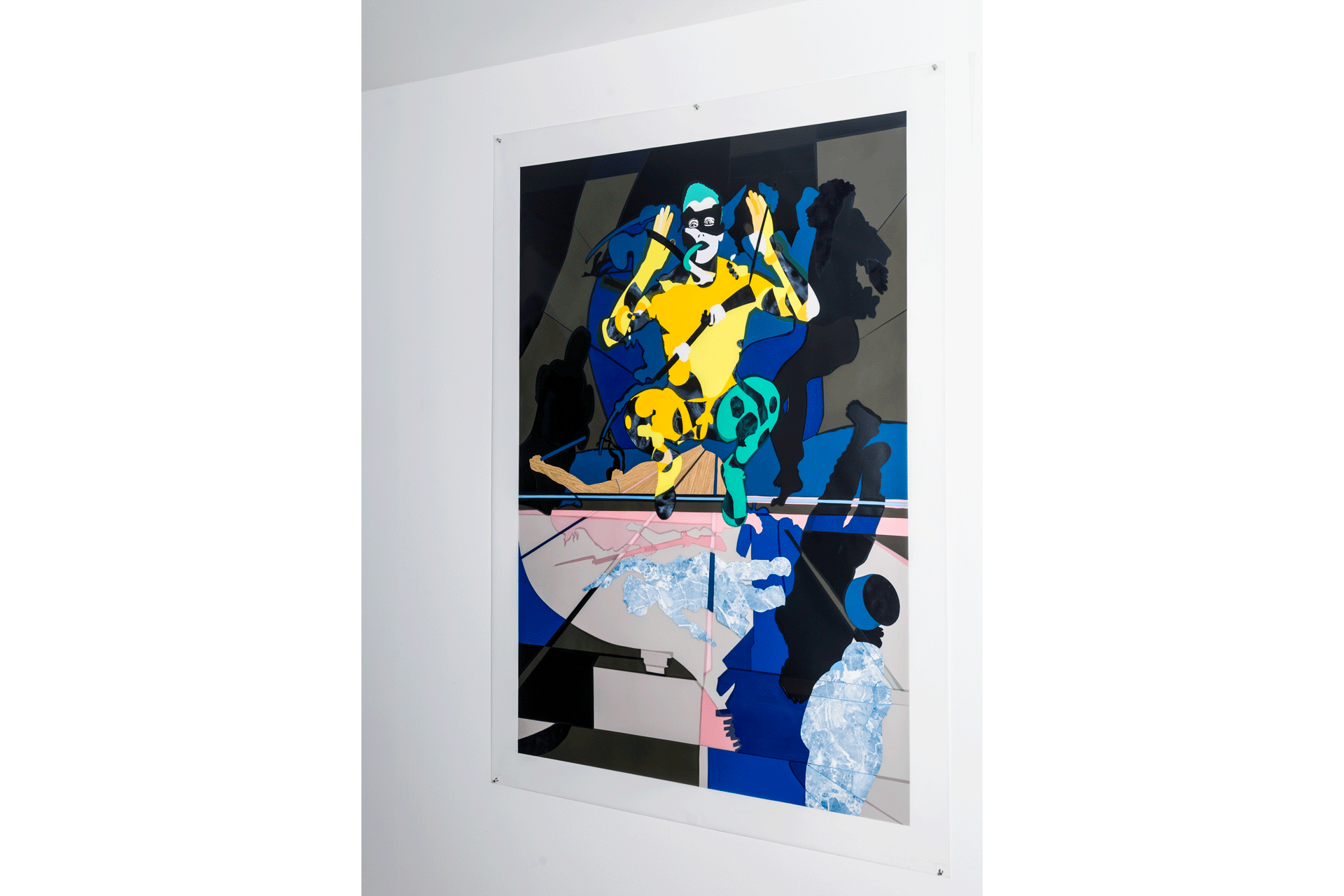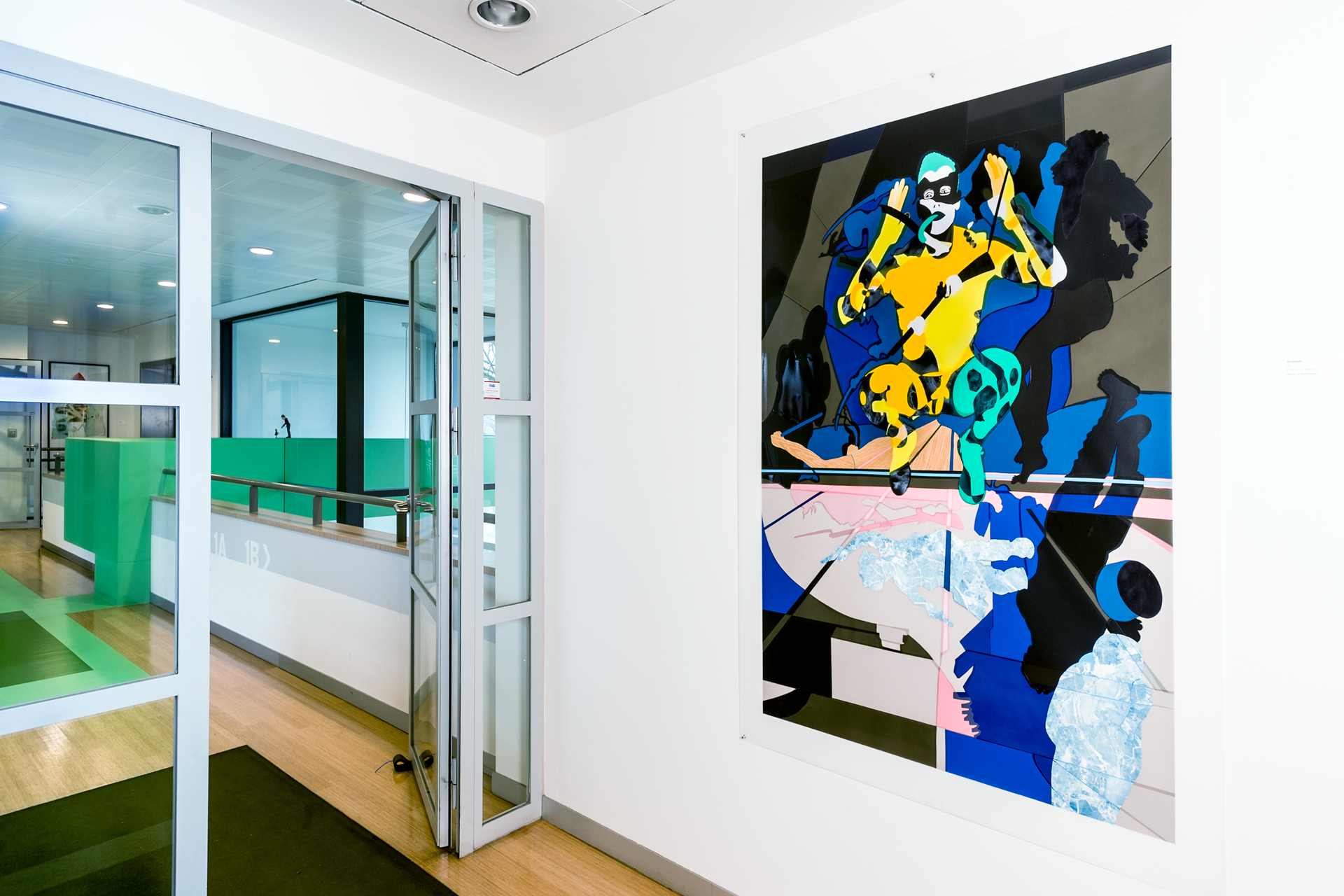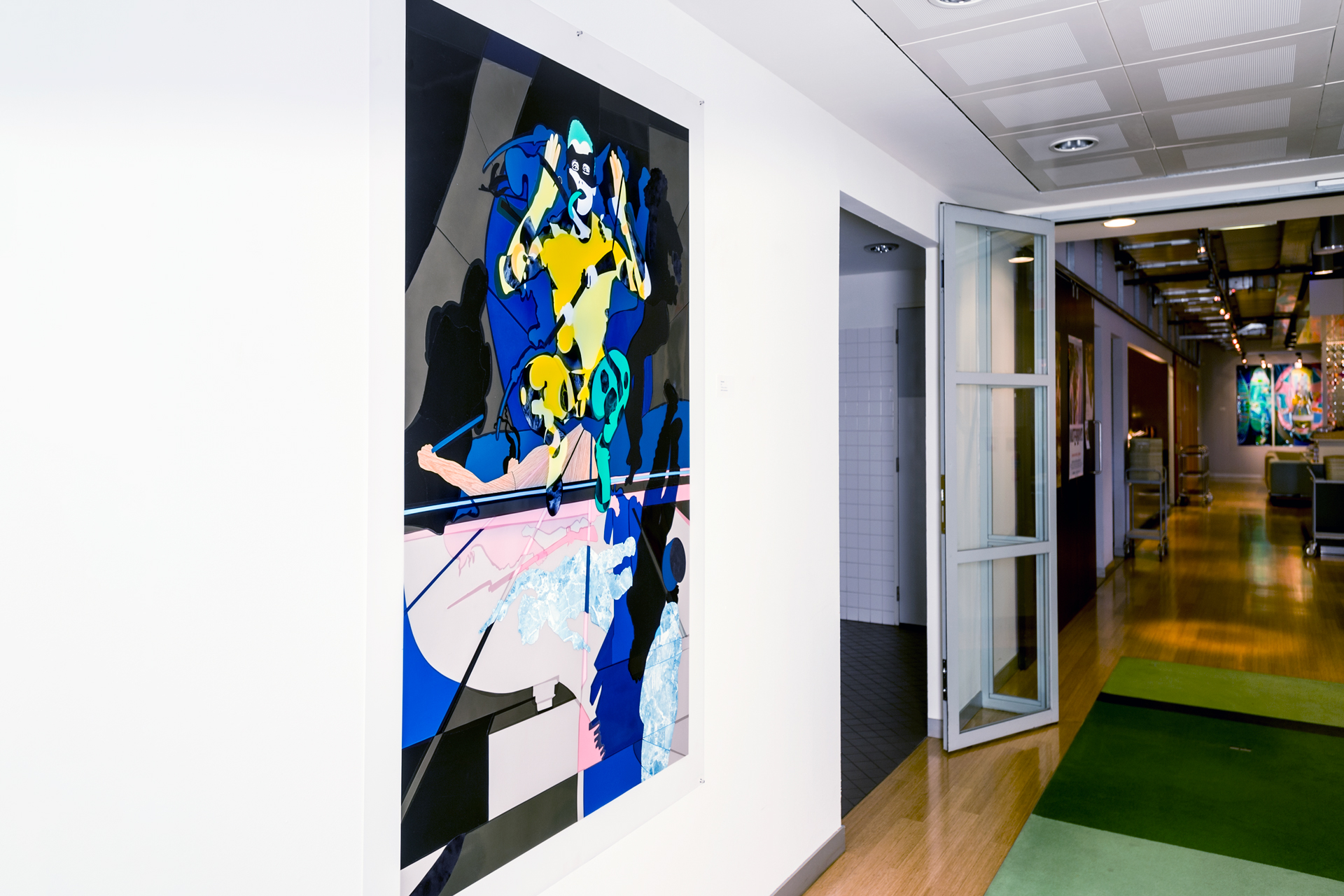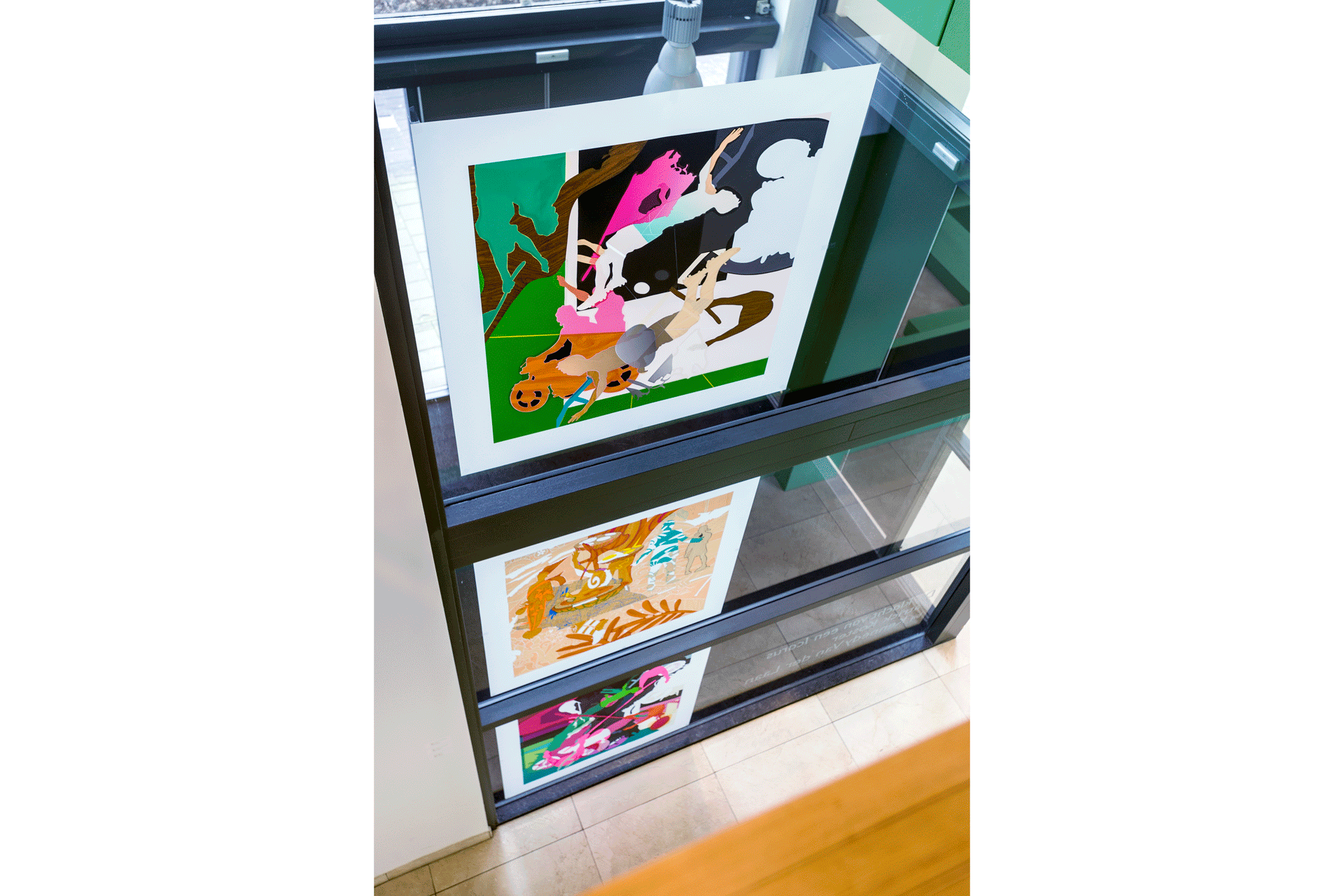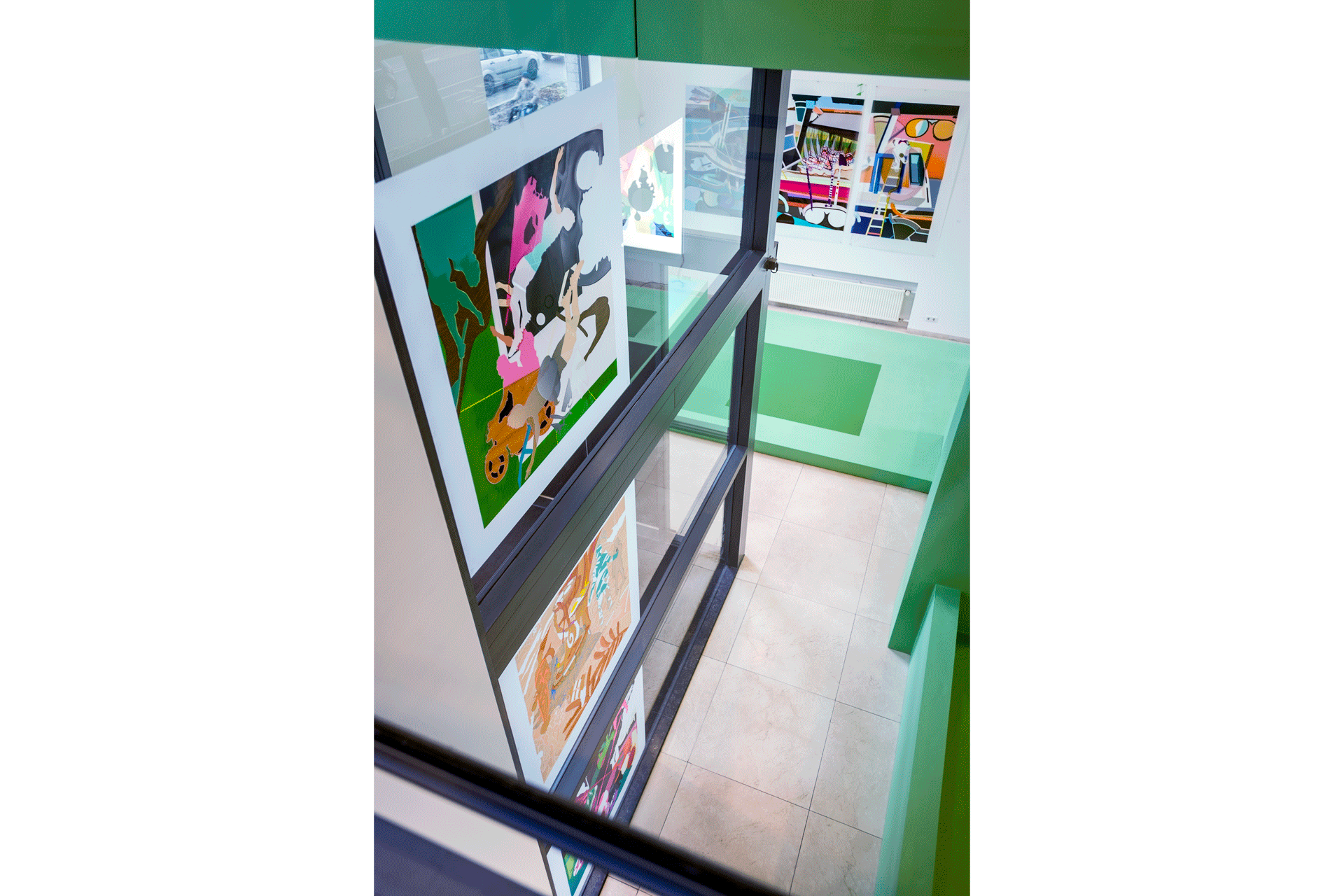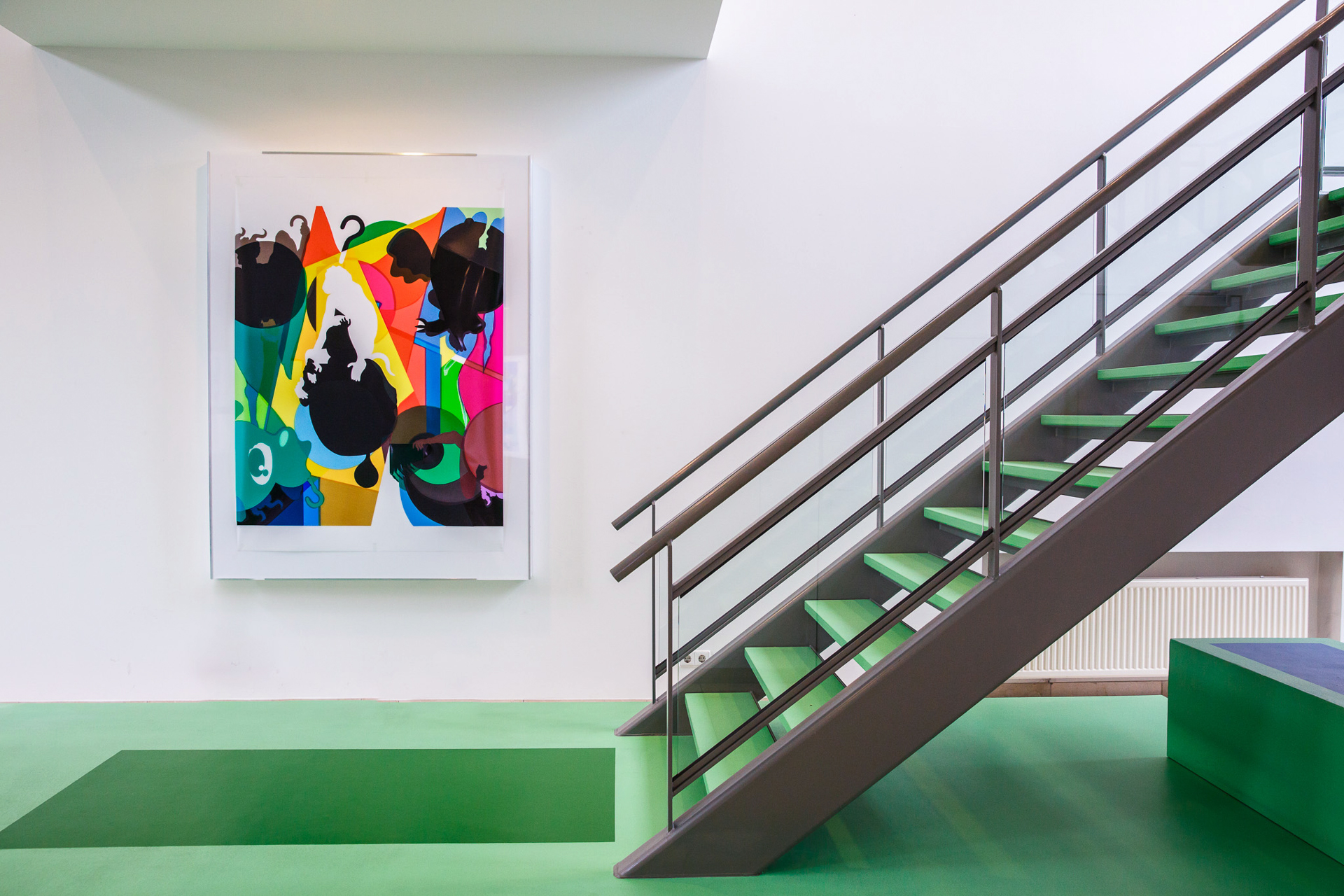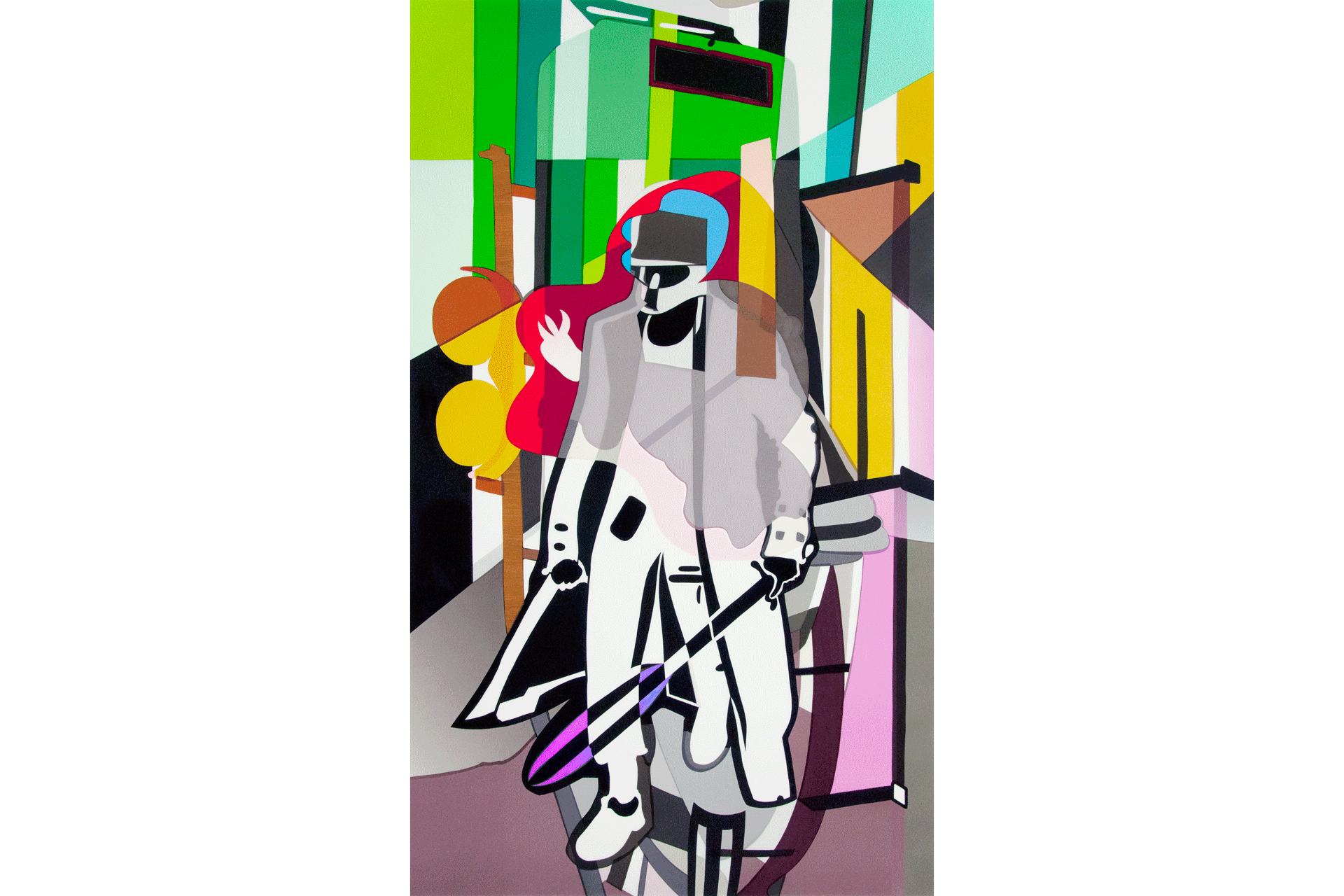The Parable of the Sower VI, 2019
Patrick Koster
The Parable of the Sower VI, series #14, The War Prayer, 2019. H 180 cm x w 136 cm (h 70.9 in x w 53.5 inch). Collage of adhesive film on drawing polyester on light box.
The War Prayer
During a recent research, I discovered Mark Twain’s (1805-1910) book “The War Prayer”. The book was initially forbidden. The story had similarities with the church attack in Charleston. Mark Twain wrote “The War Prayer” in response to the Spanish-American War and the subsequent Philippine-American War. The book remained unpublished until 1923, thirteen years after his death.
An aged stranger entered and moved with slow and noiseless step up the main aisle. His eyes fixed upon the minister. His long body clothed in a robe that reached to his feet. is head bare, his white hair descending in a frothy cataract to his shoulders, his seamy face unnaturally pale, pale even to ghastliness
(Mark Twain, The War Prayer, 1905). The pastor read from “Laws for War, When you go to war”. Chapter 20 of Deuteronomy that just like “Book of the Wars of the Lord” are parts of the Old Testament.
In “The War Prayer”, the stranger confronts the pastor and the church community with group egoism, praying for a successful result of one’s own group, of an avoidable war and propagandize it. The message from the strange visitor amounted to: “stop patriotic incitement to a useless war and religious incitement of innocent civilians to go to war.” He was considered a lunatic “because there was no sense in what he said” (The War Prayer, 1905).
This story of “The War Prayer” can also be interpreted as a parable to illustrate in an apparently simple story a moral or spiritual lesson.
Coda Museum: Beauty Of The Battle
Patrick Koster
The Beauty Of The Battle on show in Coda Museum Apeldoorn
Violence, struggle and hatred often evoke disgust. Despite, the combat and its beauty fascinate. For example, if it is depicted in a dance performance or in an art work. In Beauty of the Battle, CODA Museum Apeldoorn confronts the visitor with this contrast. The exhibition explores the boundaries of hate and love, danger and beauty. Beauty of the Battle unites painting, sculpture, performance art, installations and dance. Coda Museum director Carin Reinders cordially invites you to the opening of Beauty of the Battle on Sunday September 30. Find more information on this show at the website of Coda Museum.
Struggle and violence in art
The exhibition takes the visitor through the broad spectrum of violence in the visual arts. Seemingly seeking the motives of man. This has been fascinated by the fight for a long time. We see historical representations of ferocious Japanese warriors from Hokusai. These are displayed alongside rare Indian miniatures of hunting riders. Heroic art is the prelude to contemporary works of art that address contemporary themes. Here you can view some of Patrick Koster’s artworks that were featured in the exhibition.
Inner world versus outer world
In today’s society, the display of violence has become almost normal. Every day we are confronted with brutal violence in the media. Violence is glorified in video games and movies. Closer to home, personal conflicts surrounding identity and sexual orientation or sexual violence play a role. These themes are also discussed on social media. In the sports competitions, the audience enjoys the confrontations between athletes. For the artists in Beauty of the Battle, forms of violence or combat are a source of inspiration. They depict this in their own forms, in their own ways and with their own materials. Sometimes an artist reflects on what is happening in the outside world. Often the own inner world is also the starting point.
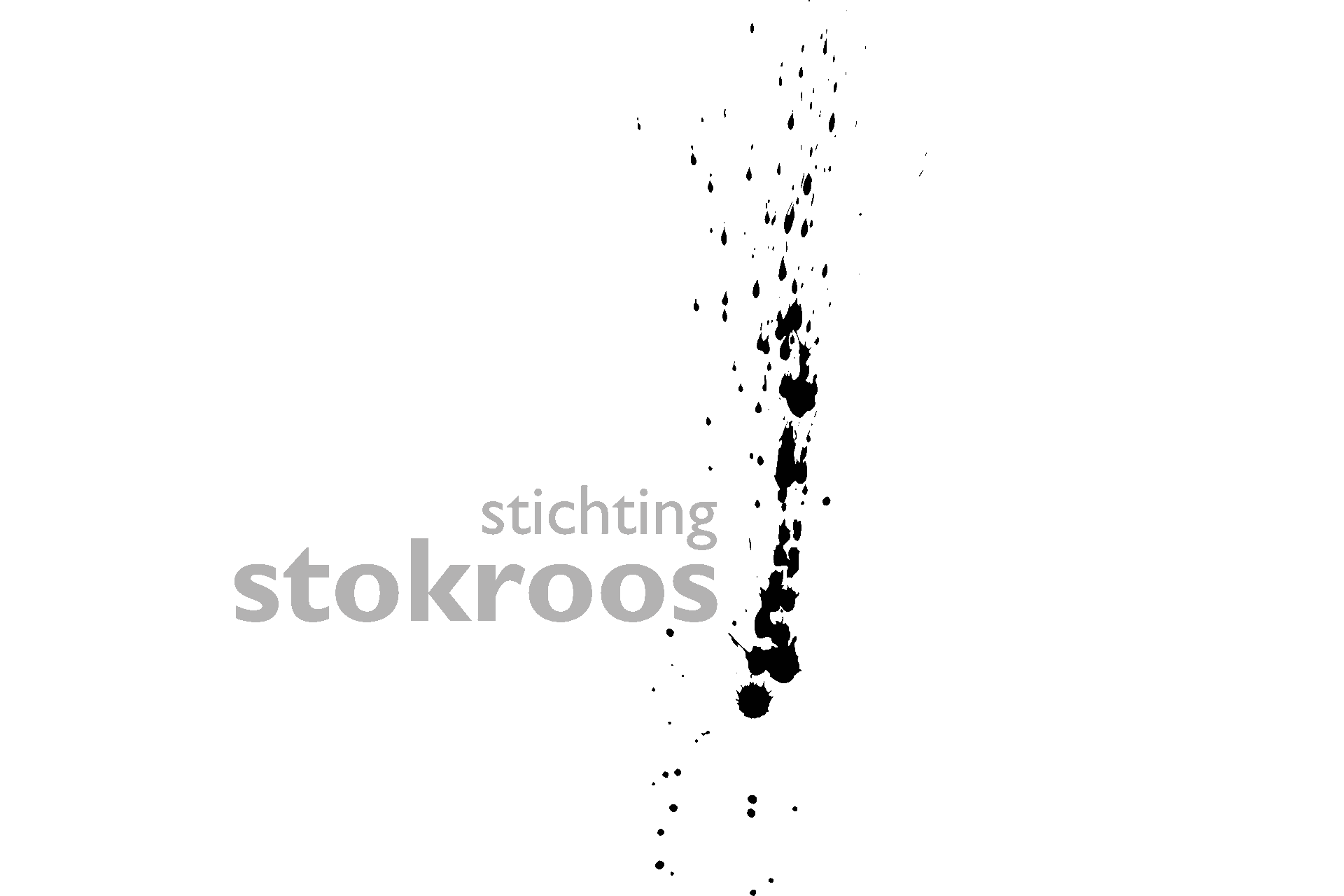
Stichting Stokroos Utrecht
Patrick Koster’s participation was made possible thanks to support from Stichting Stokroos Utrecht
Het Parool Review - Ode To The Bijlmer
Patrick Koster
Het Parool Vijftigjarige wijk in Zuidoost geëerd
Nieuw licht op de Bijlmer
CBK Zuidoost organiseert een tentoonstelling over vijftig jaar Bijlmer. Elf kunstenaars staan stil bij de geschiedenis van de beroemdste en beruchtste nieuwbouwwijk van Nederland.
Bijlmernostalgie is ingewikkeld, bleek afgelopen zaterdag op de opening van de tentoonstelling Ode aan de Bijlmer. De groezelige foto’s en video’s die Patrick Koster (1967) en Thérèse Zoekende (1972) in de jaren 1989-1997 in de Bijlmermeer maakten, bevestigen het beeld van een enge buurt waar het gevaar overal op de loer lag. Het werk van fotografe Brenda de Vries laat ook een andere kant zien. Zij kroop in de huid van haar alter ego Syd D. Doscher en ging op zoek naar haar jeugdherinneringen in de Bijlmer. De gefotografeerde fragmenten van betonnen flats, spelende kinderen en nieuwbouwhuizen zijn losjes met naald en draad aan elkaar bevestigd, wat vergankelijke beelden vol weemoed oplevert.
Groene stad
Dit jaar is het vijftig jaar geleden dat de eerste bewoners in de Bijlmer de sleutel kregen van hun hypermoderne woningen. De honingraatvormige flats waren ontworpen door Siegfried Nassuth (1922-2005), volgens de allernieuwste stedenbouwkundige inzichten. Nassuth liet zich inspireren door de modernistische ideeën van de Zwitsers-Franse architect Le Corbusier. Er kwam een scheiding tussen wonen, werken en recreëren. De nieuwe wijk moest de groene stad van de toekomst worden, met licht, lucht en ruimte voor alle bewoners.
In de la
Zoals bekend bleken zulke utopische ideeën een tikkeltje naïef, waarna een groot deel van de hoge flats werd afgebroken. Toen kunstenaar Hans van Houwelingen (1957) in 2006 door stadsdeel Zuidoost benaderd werd om een monument voor de Bijlmer te maken, bedacht hij een beeld op een viaduct langs de Gooiseweg, ter hoogte van de Daalwijkdreef. Van Houwelingen: “De Gooiseweg had eigenlijk twee keer zo breed moeten worden. De plannen voor die brede weg werden gewijzigd, maar de fundamenten liggen er nog steeds. Ze vertellen iets over de ambities en de ideologie van de wijk. Toen de hoge flats werden afgebroken, heb ik voorgesteld om een model van een Bijlmerflat op de fundamenten van dat viaduct te zetten.” Van Houwelingen wilde zijn Bijlmermonument opdragen aan Siegfried Nassuth, maar de plannenmakers in de buurt waren juist druk bezig om diens ontwerpen weg te poetsen. Het was niet het juiste tijdstip om de oude hoogbouw te eren met een monument en Van Houwelingens ontwerp verdween in de la.
K-buurt
Nu presenteert hij zijn maquette opnieuw, naast een fotomontage van hoe het kunstwerk er ongeveer uit zou kunnen zien. “Nu wijzen de neuzen blijkbaar de andere kant op. Tijdens de opening van de tentoonstelling kreeg ik veel positieve reacties en ik heb net met een aantal politici gesproken die gaan bekijken of het monument alsnog kan worden gerealiseerd.” Grafisch ontwerper Floor Wesseling (1975), oprichter van Studio Wesseling, is opgegroeid in de Bijlmer. Hij ontwierp twee lichtbakken, anderhalve meter hoog, in de vorm van letters die vroeger aan de garages in de G- en K-buurt hingen. “Ik woonde in de G-buurt en als je ’s nachts uit de stad kwam, zag je de naam van je flat op-
Als je ’s nachts uit de stad
kwam, zag je de naam van
je flat opdoemen in het
donker
doemen in het donker.” Tegenover de blauwe G hangt een rode K, de buurt waar Wesselings vriend en collega Marques Malacia vroeger woonde. Het lettertype is Futura medium, ontworpen in 1927. Een modernistisch ontwerp, maar volgens Wesseling ook tijdloos. “Het is net zo op de toekomst gericht als de Bijlmer, de ideale stad. De letters zijn eigenlijk een neutraal portret van de gruwelijkheden van mijn jeugd. Want er waren veel jeugdbendes die zich identificeerden met hun buurt. Zo werd het G tegen K. Eind jaren tachtig keken we naar de straatcultuur in Amerika, naar hiphop en gangsterrap.” Het rood van de K en het blauw van de G zijn ook een knipoog naar de Bloods en de Crips in Los Angeles, al was de rivaliteit in de Bijlmer niet zo heftig, erkent Wesseling. “Maar er waren behoorlijke ruzies en straatgevechten met wapens. Dus die letters zijn een abstract typografisch beeld met een zeer persoonlijke lading.”
Herinterpretatie
Als onderdeel van de tentoonstelling presenteert Studio Wesseling zaterdag 29 september ook een nieuw, tijdelijk werk op het plein tegenover CBK Zuidoost. Het is een herinterpretatie van het verdwenen kunstwerk De grote glijbaan van Karin Daan (1944), dat zich vroeger vlak bij de metrohalte Ganzenhoef bevond. Het bestond uit twee glijbanen onder een viaduct, dat door kinderen gretig werd gebruikt. Wesseling: “Als mijn ouders daar boodschappen gingen doen, ging ik er altijd spelen. Omdat er twee banen naast elkaar waren kon je wedstrijdjes doen met andere kinderen. De dingdong die we hoorden als de metro wegreed was ons startsein.”
Tentoonstelling Ode aan de Bijlmer, CBK Zuidoost.
T/m 20/10
Kees Keijer
AMSTERDAM
Bijlmer Years 1989-1997
Patrick Koster
Patrick Koster | Thérèse Zoekende
mixed media installation
Ode To The Bijlmer
Patrick Koster (NL, 1967) and Thérèse Zoekende (NL, 1972), are artists who work together on an ad hoc basis. For the exhibition Ode to the Bijlmer in CBK South-Easth, they made the work Bijlmer Years 1989-1997. In this work they use trusted visual imagery to bring to life their shared Bijlmer history.
Twenty-nine years ago, as students at the Rietveld Academy, they came to live in this district. After nine years, urban renewal forced them to leave. Their earlier Bijlmer habitat, was former subject matter for their artistic work. It had a significant influence on their personal and artistic development.
Bijlmer Years
The project Bijlmer Years 1989-1997 is a mixed-media installation. It consists of videos with sound, pinhole photographs, and illuminated panels. The installation is showing the Bijlmer in its authentic state. The project is largely based in the 1990’s. These years likewise formed a kind of tipping point for the neighbourhood.
Decline had reached an absolute low. Through the high level of crime, drug nuisance, and general social problems, it was beginning to look more and more as though the progresive urban concept of the Bijlmer as ‘utopian city’ could simply be an illusion, a dystopia. In July of 1992, Amsterdam decided to start with the large-scale project ‘Renewal Bijlmermeer’, which broke with the original ideas of the designers of the Bijlmer.
Fossiled Images
Bijlmer Years 1989-1997 is an artistic video and photography project consisting of almost fossilesed images of the Bijlmer. Fifty years ago the district was completed, and 25 years ago it was already mostly relegated to history. Likewise, the images of the project are only thirty years old, yet already they belong to the more or less forgotten past of the old Bijlmer.
Kraaiennest
From conversations with young inhabitants of the renewed Kraaiennest, it appears, for exemple, that they have never even heard of the high-rise called Koningshoef. The project has been made from an insiders’ standpoint and it makes palpable ho wit was, to have lived and worked in the old Bijlmer.

This project has been made possible in part through a contribution from the AFK (Amsterdam Fund for the Art).
Ode To The Bijlmer
Patrick Koster
Exhibition: Ode To The Bijlmer
Opening: September 8 (15:00) in: CBK-Zuidoost.
Ode To The Bijlmer can be visited from September 8 to October 20, 2018.
The Bijlmer will be 50 years old in 2018. CBK Zuidoost is developing a group exhibition “Ode To The Bijlmer” with 11 artists. In the exhibition the artists reflect in their work on the urban development of the Bijlmer and the current reforms. Over the years there has been a lot of attention for the Bijlmer, especially about everything that went wrong. The neighborhood that was seen as “the city of the future” upon completion was already partially demolished after 25 years. Siegfried Nassuth’s utopian urban plan was dismissed as a major failure. Bijlmer had and still has a stigma, especially for people who have never been there.
Urban Renewal
In the meantime, this district has existed for half a century already. All that time it has been inhabited, played, lived and worked. A third generation of children is growing up. Flats have been demolished and flats have been thoroughly renovated. An urban plan has drastically changed and construction is still going on; the district is still developing. The artists in the exhibition Ode To The Bijlmer show the Bijlmer as a monument, as urban renewal, as utopia, as special and different or as youth sentiment. Common thread in the exhibition is an autonomous visual translation of a positive experience with this neighborhood.
Bijlmer Years 1989-1997
For the exhibition ‘Ode aan de Bijlmer’ in CBK Zuidoost, I made the work ‘Bijlmer Years 1989-1997’. It is a collaboration project with visual artist Thérèse Zoekende, in which we bring our shared Bijlmer past to life in a confidential picture story. Twenty-nine years ago, as Rietveld students, we came to live in this urban district. We were forced to leave nine years later due to urban renewal. Project “Bijlmer Years 1989-1997” is a mixed media installation consisting of videos with sound, photos and light boxes that shows the Bijlmer in its authentic state.
Honeycomb flat Koningshoef
Our house in the honeycomb flat Koningshoef in the K-neighborhood plays an important central role in the creation of the images in the exhibition. Koningshoef was the largest Bijlmer apartment with 525 houses. We lived on the corner, three high at number six. Our home was our lookout point, we photographed views in different directions and at different seasons. The home was often the starting point for the videos. Koningshoef and large parts of the K-neighborhood have since been demolished and changed beyond recognition.
KunstRai-Art Amsterdam 2018
Patrick Koster
KunstRai-Art Amsterdam
Galerie Fontana would like to invite you to the festive opening of the KunstRai-Art Amsterdam 2018. On Wednesday April 4 from 5: 00-10:00 PM. The fair will be officially opened at 7:00 PM. Motto of this fair is Focus Barcelona. Hence the Spanish Ambassador Z.E. Mr Fernando Arias González will be present at the opening. Usually the fair will be held in Hall 7 of the Amstelhal. Part of the RAI Amsterdam builbing complex. At the Wielingenstraat you will find the entrance.
The Vernissage
Visual artist Patrick Koster exhibits a series of square and predominantly red works. All these works are made in the technique that Patrick has studied in recent years. Collage of adhesive film on drawing polyester mounted on light box. The works are entitled The Vernissage. Patrick chose a newspaper photo as a starting point for making the series. Taken at the opening of an art exhibition in Ankara, Turkey. A man disguised as a security guard had attacked the Russian Ambassador who spoke an opening speech.
Inspired by the time and world in which we live, Patrick Koster intervenes artistically by placing “evil” in an alienating context. His work ensures that your mind does not immediately see struggle and violence in the image, but rather uses your imagination to understand it.
In my work I immerse myself in the violence and ideas of attackers. In many cases, there is hardly any contradiction between reasonable thinking and evil. Reason is an instrument that can be used for good and for bad. Thinking can also easily change from good to evil.
Question Mark Amid The Deluge Of Images
“Studying evil and violence has traditionally been an area of the arts. Think of Francisco Goya’s painting “Saturn swallowing his children”, Dante’s La Divina Commedia, Medea from Greek mythology, Van den Vos Reynaerde, Macbeth, The Joker or Hanibal Lecter. It often satisfies our fascination with violence. Or our desire to witness the cross-border, the secret, the forbidden, the horrific.
Art can create an interval between seeing and understanding, raising a question mark amid the deluge of images. Creating a kind of in-between so that thinking no longer reproduces the already established opinions and new thoughts can begin. To reveal such an intermediate area, the artist will have to undermine the stereotypical images and thinking patterns. Sprinkle sand in the representation machine, so that it falters and jerks and no longer conjures up the calibrated image. None of the contradictions with which we have divided our world appears to be trusting. The beautiful no longer belongs to the good, the ugly no longer automatically to evil.
Art The Hague | Patrick Koster
Patrick Koster
Art The Hague 2017
Artworks Patrick Koster on view at Art The Hague 2017 from Wednesday 4 to Sunday 8 October 2017, Fokker terminal, The Hague, The Netherlands.
Patrick Koster represented at Art The Hague.
One of the works that can be seen at Art The Hague is Hanna and Evy in Delft, 1944 I, series # 2, made in 2015. The artwork is made in Patrick’s well-known collage technique of adhesive film on drawing polyester, mounted on the light box. The dimensions of the work are height 157.6 cm x width 81.6 cm or height 62.1 inch by width 32.1 inch.
For this work at Art The Hague Patrick took inspiration for the work from literature this time. A long-lost “Diary 1944” by the writer Hans Keilson about his time in hiding in Delft. An old newspaper photo taken in the hunger winter 44-45 was the starting point for this work. On show are two women Hanna Sanders (23 years old) and Evy Bakker. Author Hans Keilson went into hiding with them for some time in World War II. Sit in a small room at the table and both women lick their plates.
Les Fleurs du Mal
The photo reminded me of the poem: Dusk by Charles Baudelaire published in the collection of poems Les Fleurs du Mal. The air is full of morbid devils you can hear awakening. Baudelaire was fascinated by the lurid and satanic. Man’s discomfort with his fate intrigued him. Baudelaire also rejected any belief in progress.
Diner Plate As A Shield
I folded the photo of the two women in half. Both women are portrayed separately at their own work. That is why I came up with a series of two works. Hanna and Evy II imagines “the world” of Hanna. Evy is central to the first work in the series. Both women depict innocence and good. They seem to use their dinner plate as a shield. As if they want to protect themselves against what is “hanging over their heads”. Please leave a respond if you like this presentation of Patrick Koster’s artwork at Art The Hague.
KunstRai, Gallery Fontana, solo booth
Solo Exhibition Patrick Koster
In addition to their booth, participating galleries will also be organizing a solo booth in which the work of an artist will be presented. Its purpose is to enlarge the visibility of the art and oeuvre of this artist. Galerie Fontana presented works by visual artist Patrick Koster in a solo exhibition.
The Fugitive, triptych, 2014
One of the works that Patrick presented was a large triptych entitled The Fugitive, The triptych was made in the collage technique. My favourite working material is adhesive film that I apply on drawing polyester. The collage on polyester is mounted on a lightbox. It all has a dimension of h 169,6 x w 338,3 or h 66.8 x w 133.2 inch. Read more
Fontana Gallery, Doppelgänger
Patrick Koster
Doppelgänger Series On Show
Gallery Exhibition Doppelgänger
At the exhibition at Fontana gallery, Patrick Koster shows two works from the Doppelgänger series. Doppelgänger 1 and 2 from a series of 3 both from 2014. They are collage artworks on a lightbox. Made in the technique adhesive film on drawing polyester mounted on light box. The works have the same size and measure a height 153.5 cm by width 129 cm. In Inches it gives a height of 60.4 by width 50.8 inches. Have a look at the complete series here.
Divisors Of Soul Space
Christopher is known as a bearer of Christ. The theme is about arrogance. He only wanted to respect the supreme power. Therefor he served the king, the emperor, the devil, respectively, and ended with Christ. Christopher is the exemplary servant who carries the wearer who bears everything.
A doppelganger can be seen as a second me. “I am your second self. The doppelganger is also called known as double-ego or alter ego. Encounter yourself through a doppelganger. German culture philosopher Peter Sloterdijk (1947) wrote about this in his books Spheres from 1998 and Globes from 1999. Sloterdijk writes about “divisors of soul space” such as angels, twins and doppelgänger.
Genius and Daimonion
Genius means your guardian spirit from birth to the Romans. “Daimonion” is an internalized guardian spirit from Socrates. An indication that the subject is in a world bordering on a near transcendence.
Unknowable Chaos Of Existence
The doppelgänger has three aspects. It is an artistic motif. In addition, it is a psychological-psychiatric case. Finally, the doppelganger also appears as a fact in reality. In double-parenting, one person can represent another’s superego. An ideal self that is blindly followed by the other. When the doppelganger disappears, the active life of the other character no longer has any meaning.
The doppelganger motif often has an element of confusion. To obscure reality, and to affect human cognition. Thus it is a contribution to the demonstration of the unknowable chaos of existence.
I World
Also in texts from Antiquity and the Renaissance the doppelganger appears. Sometimes as the cause of confusion and complications. It can have a comic effect as a result. In German Romanticism arts the doppelganger appears as an encounter with the self. This doppelganger arises from subjective idealism (Fichte, 1762-1814). This posed the problem of reality in the opposition I-world. Therefor this idealism culminated in the view that the world exists only as a representation of the ego. There is a clear connection with the dualistic sense of life of Romanticism. In Romanticism there is a desire to transcend the finite limits of the I to the irrational. The desire for what one is not but wishes to be.
Be happy to view the Exhibition Doppelgänger online here. And if you like Patrick Koster’s exhibition, please leave a reply or share the article.
Laments of an Icarus
The Laments of an Icarus a solo exhibition at Kenndey Van Der Laan gallery with artworks by Patrick Koster It is not often that you come across an artist who has been working in his studio for about twenty years. He has hardly ever shown that work before. More often it happens that artists come out a little too quickly with immature work.
It is also worth mentioning that in those years a close and consistent body of work has emerged. Patrick’s work is difficult to compare with the work of others. Yet Patrick Koster is not a hermit. He is in the middle of the world. runs a karate school. Patrick sees exhibitions, reads a lot and collects images and stories from the big world. Images from the world as they appear in our newspapers. He does not watch television.
Knives and scissors are his brushes
He compiles his own images from the folders and scrapbooks full of remarkable newspaper photos. Images which we quickly take for granted. This is done sketching, in pencil, then cutting and pasting until he likes it. Then he enlarges the sketch manually and “paints” with layers of colored, transparent film. Knives and scissors are his brushes. Adhesive plastic has something of the stickers that he already liked as a child and pasted everywhere. He pioneered a completely personal working method.
Issues about right and wrong
What motivates him are major social issues of good and evil. The derailed boys who cause so much suffering, with their acts of desperation or well-organized violent actions. Sometimes the images are taken from works of art history where murder scenes are depicted as heroes in war scenes.
Icarus
The large triptych in the restaurant entitled “Icarus” depicts the rescue operation of the 33 Chilean miners who were trapped underground for 17 days in 2010 and were eventually lifted up one by one in a capsule. From darkness to light. The works are incredibly well composed, compositionally crystal clear and yet exciting, touching big things without being compelling. There is much to experience in many ways and to enjoy sophisticated use of color.
As an art committee, we consider ourselves lucky to see this work in The Laments of an Icarus see the light of day. This work it deserves it. You will soon be warmly invited to meet the artist at a meeting in early November at Kennedy Van Der Laan.
Erik Mattijssen
Solo Exhibition, KVdL
Patrick Koster
Solo Exhibition, KVdL (Kennedy Van der Laan) The Laments of an Icare, Patrick Koster.
It is not often that you come across an artist who has been working in his studio for about twenty years. During this period he has hardly ever shown his work. More often it happens that artists come out a little too quickly with immature work.
It is also worth mentioning that in those years a close and consistent body of work has emerged. These works are difficult to compare with the work of others. Yet Patrick Koster is not a hermit. He is in the middle of the world. Patrick runs a karate school. He sees exhibitions, reads a lot and collects images and stories from the big world. The world as it appears in our newspapers. He does not watch television.
Knives and scissors are his brushes
He compiles his own images from the folders and scrapbooks full of remarkable photos from the newspaper, which we quickly take for granted. This is done sketching, in pencil, then cutting and pasting until he likes it. Then he enlarges the sketch manually and ‘paints’ with layers of colored, transparent film. Knives and scissors are his brushes. That adhesive plastic has something of the stickers that he already liked as a child and pasted everywhere.
He pioneered a completely personal working method.
Issues of right and wrong
What motivates him are major social issues of good and evil. The derailed boys who cause so much suffering, with their acts of desperation or well-organized violent actions. Sometimes the images are taken from works of art history where murder scenes are depicted as heroes in war scenes.
Icarus
The large triptych in the restaurant entitled ‘Icarus’ depicts the rescue operation of the 33 Chilean miners who were trapped underground for 17 days in 2010 and were eventually lifted up one by one in a capsule. From darkness to light.
The works are incredibly well composed, compositionally crystal clear and yet exciting, touching big things without being compelling. There is much to experience in many ways and to enjoy sophisticated use of color.
As an art committee, we consider ourselves lucky to see this work see the light of day, because it deserves it. You will soon be warmly invited to Solo Exhibition An Icarus to meet the artist at a meeting in at Kennedy Van der Laan. [Erik Mattijssen]
Le Massacre des Innocents
Patrick Koster
Le massacre des innocents, 2016, h 205 cm x w 122 cm (h 80.8 in x w 48.1 in), collage of adhesive film on drawing polyester on lightbox, Also follow Patrick Koster on Instagram.
The Child Murder of Bethlehem
A media image inspired me to create two art works. In 2016, I made ‘Le massacre des innocents’ (The Massacre of the Innocents). It is a recurring theme in art history that mythologically reverts to ‘The Child Murder of Bethlehem’.
Trollhättan school attacker
I found a film footage of the ‘Trollhättan school attacker’. The 21-year-old man was dressed in the outfit of Darth Vader, a fearful and masked character from Star Wars. He was armed with a real sword, making him a symbolic Roman gladiator, a knight or Japanese samurai.
The Corridors
During his journey through the corridors of the school building he was filmed by closed circuit television security cameras. You could these videos on internet. Two girls saw the boy marching in disguise and thought he was on his way to a Halloween party. It was October 22, 2015. They were happily embraced with him on a selfie, to then put the photo on social media.
After the photo session the young man continued perseveringly and undisturbed with his intended path and a few minutes later, implemented his plan cold-blooded.
[Nederlandse tekst]
Het bloedbad van de onschuldigen
Een mediabeeld zette me aan tot het maken van meerdere werken. In het jaar 2016 maakte ik naar aanleiding ervan een groot werk met de titel: ‘Le massacre des innocents’ (Het bloedbad van de onschuldigen, h 200 cm x b 116,7 cm), omdat dat vrij precies de gevolgen van de geplande actie van de jongen vertolkt. Het is een in de kunstgeschiedenis regelmatig terugkerend motief dat mythologisch teruggrijpt op ‘De Kindermoord van Bethlehem’.
Van de infanticide, die plaatsvond na de geboorte van Jezus, zijn al boekillustraties bekend uit de tiende eeuw. Veel kunstenaars waaronder Giotto di Bondone, Pieter Bruegel de Oude, Jacopo Tintoretto, Peter Paul Rubens en wat dichterbij in de tijd, Nicolas Poussin, hebben deze thematiek bestudeerd en er eigentijdse versies van geschilderd. Hoe oud en vaak afgebeeld de thematiek ook is, ze is geenszins sleets en heeft zeker niet aan zeggingskracht en verbinding met de hedendaagse realiteit ingeboet.
